Strategic Planning for Aldi: Environmental Analysis and New Strategy Proposal
VerifiedAdded on 2023/06/08
|41
|8901
|415
AI Summary
This report highlights the environmental analysis of Aldi, one of the major discount chain stores, operating in Europe, Australia, USA and China, and proposes a new strategy for the company to expand its market. Through SWOT, PESTLE, Porter’s five forces and Porter’s generic strategies, it has been suggested that Aldi should adopt differentiation strategy to increase its market share.
Contribute Materials
Your contribution can guide someone’s learning journey. Share your
documents today.

Running head: STRATEGIC PLANNING
Strategic Planning
Name of the Student:
Name of the University:
Author note:
Strategic Planning
Name of the Student:
Name of the University:
Author note:
Secure Best Marks with AI Grader
Need help grading? Try our AI Grader for instant feedback on your assignments.
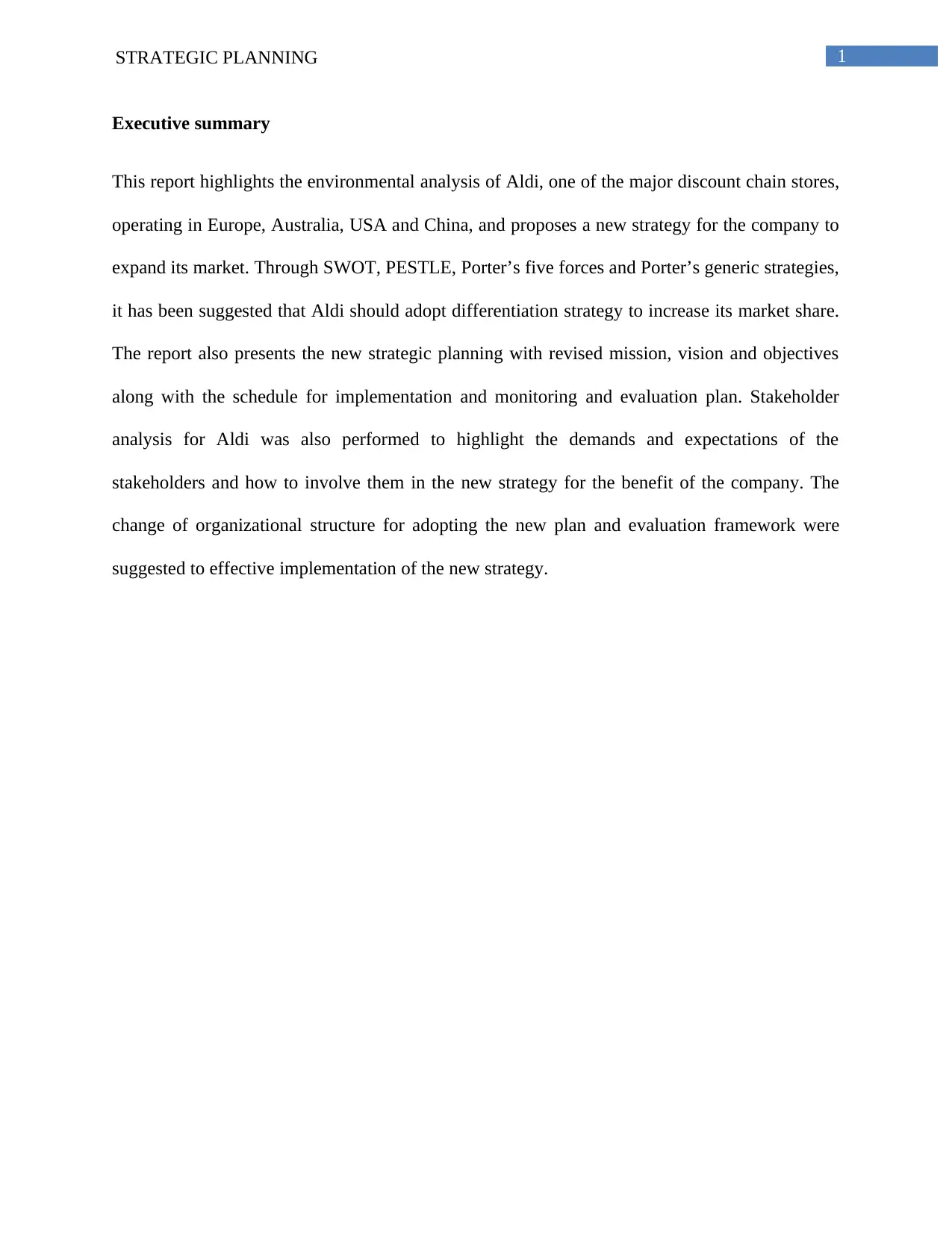
1STRATEGIC PLANNING
Executive summary
This report highlights the environmental analysis of Aldi, one of the major discount chain stores,
operating in Europe, Australia, USA and China, and proposes a new strategy for the company to
expand its market. Through SWOT, PESTLE, Porter’s five forces and Porter’s generic strategies,
it has been suggested that Aldi should adopt differentiation strategy to increase its market share.
The report also presents the new strategic planning with revised mission, vision and objectives
along with the schedule for implementation and monitoring and evaluation plan. Stakeholder
analysis for Aldi was also performed to highlight the demands and expectations of the
stakeholders and how to involve them in the new strategy for the benefit of the company. The
change of organizational structure for adopting the new plan and evaluation framework were
suggested to effective implementation of the new strategy.
Executive summary
This report highlights the environmental analysis of Aldi, one of the major discount chain stores,
operating in Europe, Australia, USA and China, and proposes a new strategy for the company to
expand its market. Through SWOT, PESTLE, Porter’s five forces and Porter’s generic strategies,
it has been suggested that Aldi should adopt differentiation strategy to increase its market share.
The report also presents the new strategic planning with revised mission, vision and objectives
along with the schedule for implementation and monitoring and evaluation plan. Stakeholder
analysis for Aldi was also performed to highlight the demands and expectations of the
stakeholders and how to involve them in the new strategy for the benefit of the company. The
change of organizational structure for adopting the new plan and evaluation framework were
suggested to effective implementation of the new strategy.
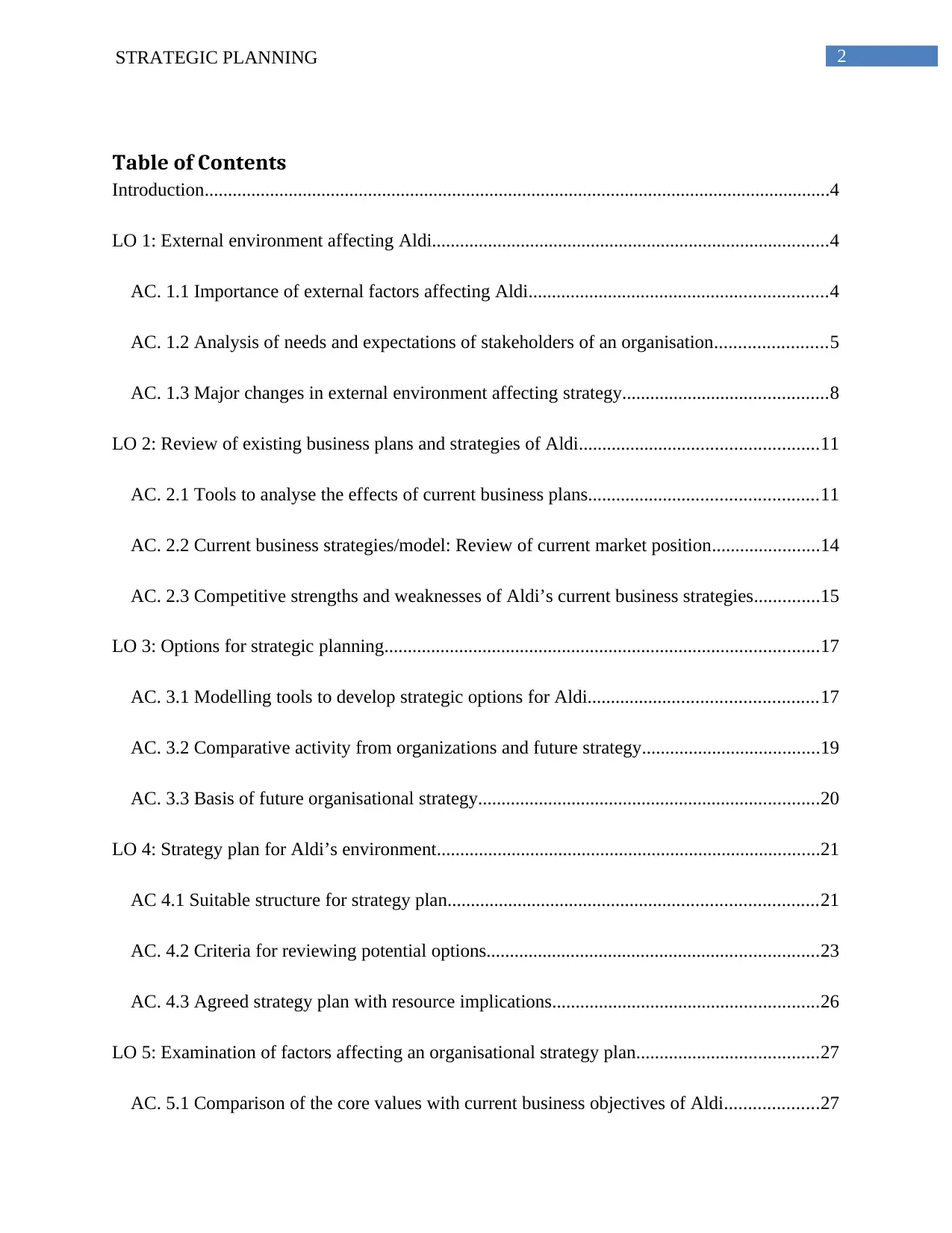
2STRATEGIC PLANNING
Table of Contents
Introduction......................................................................................................................................4
LO 1: External environment affecting Aldi.....................................................................................4
AC. 1.1 Importance of external factors affecting Aldi................................................................4
AC. 1.2 Analysis of needs and expectations of stakeholders of an organisation........................5
AC. 1.3 Major changes in external environment affecting strategy............................................8
LO 2: Review of existing business plans and strategies of Aldi...................................................11
AC. 2.1 Tools to analyse the effects of current business plans.................................................11
AC. 2.2 Current business strategies/model: Review of current market position.......................14
AC. 2.3 Competitive strengths and weaknesses of Aldi’s current business strategies..............15
LO 3: Options for strategic planning.............................................................................................17
AC. 3.1 Modelling tools to develop strategic options for Aldi.................................................17
AC. 3.2 Comparative activity from organizations and future strategy......................................19
AC. 3.3 Basis of future organisational strategy.........................................................................20
LO 4: Strategy plan for Aldi’s environment..................................................................................21
AC 4.1 Suitable structure for strategy plan...............................................................................21
AC. 4.2 Criteria for reviewing potential options.......................................................................23
AC. 4.3 Agreed strategy plan with resource implications.........................................................26
LO 5: Examination of factors affecting an organisational strategy plan.......................................27
AC. 5.1 Comparison of the core values with current business objectives of Aldi....................27
Table of Contents
Introduction......................................................................................................................................4
LO 1: External environment affecting Aldi.....................................................................................4
AC. 1.1 Importance of external factors affecting Aldi................................................................4
AC. 1.2 Analysis of needs and expectations of stakeholders of an organisation........................5
AC. 1.3 Major changes in external environment affecting strategy............................................8
LO 2: Review of existing business plans and strategies of Aldi...................................................11
AC. 2.1 Tools to analyse the effects of current business plans.................................................11
AC. 2.2 Current business strategies/model: Review of current market position.......................14
AC. 2.3 Competitive strengths and weaknesses of Aldi’s current business strategies..............15
LO 3: Options for strategic planning.............................................................................................17
AC. 3.1 Modelling tools to develop strategic options for Aldi.................................................17
AC. 3.2 Comparative activity from organizations and future strategy......................................19
AC. 3.3 Basis of future organisational strategy.........................................................................20
LO 4: Strategy plan for Aldi’s environment..................................................................................21
AC 4.1 Suitable structure for strategy plan...............................................................................21
AC. 4.2 Criteria for reviewing potential options.......................................................................23
AC. 4.3 Agreed strategy plan with resource implications.........................................................26
LO 5: Examination of factors affecting an organisational strategy plan.......................................27
AC. 5.1 Comparison of the core values with current business objectives of Aldi....................27
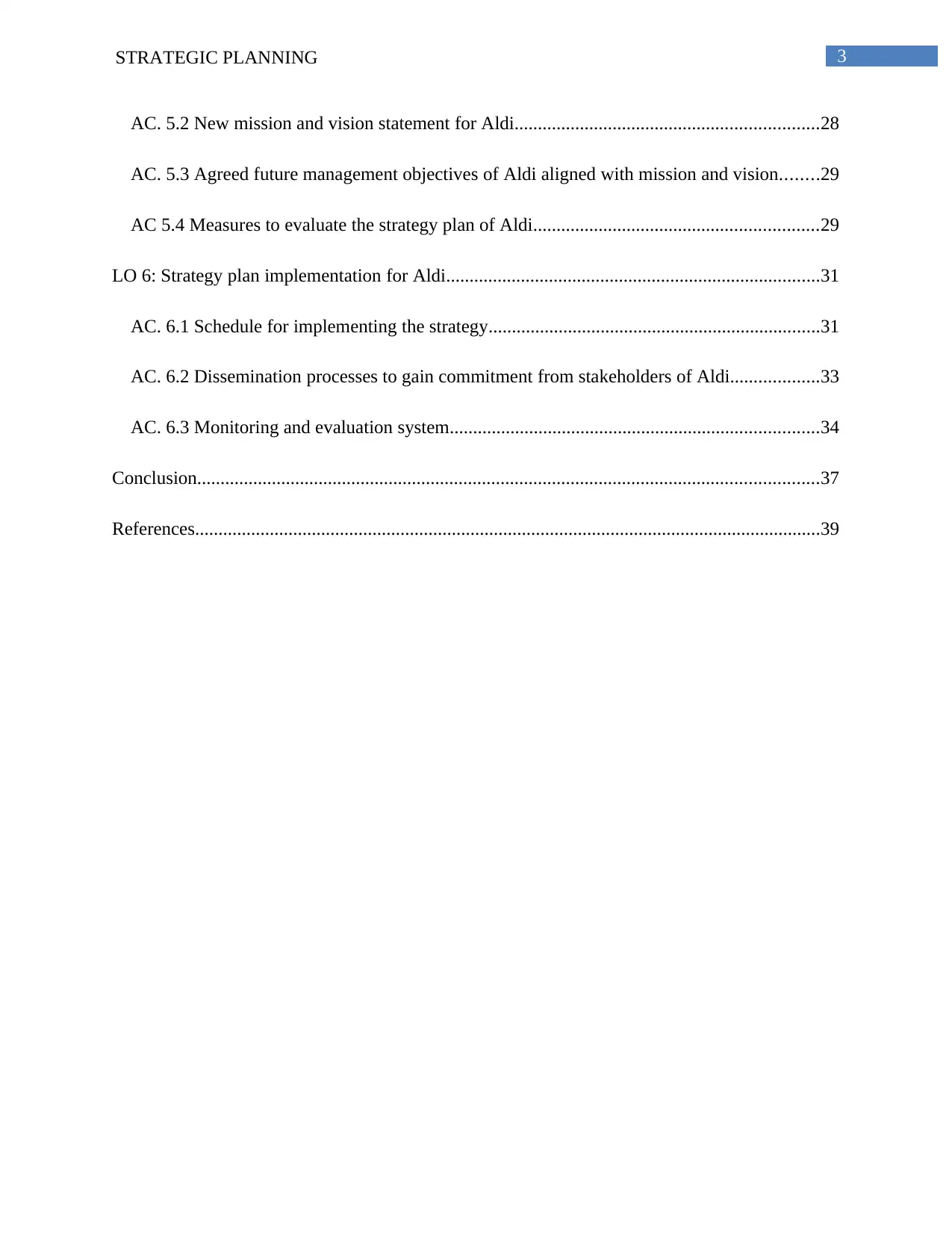
3STRATEGIC PLANNING
AC. 5.2 New mission and vision statement for Aldi.................................................................28
AC. 5.3 Agreed future management objectives of Aldi aligned with mission and vision........29
AC 5.4 Measures to evaluate the strategy plan of Aldi.............................................................29
LO 6: Strategy plan implementation for Aldi................................................................................31
AC. 6.1 Schedule for implementing the strategy.......................................................................31
AC. 6.2 Dissemination processes to gain commitment from stakeholders of Aldi...................33
AC. 6.3 Monitoring and evaluation system...............................................................................34
Conclusion.....................................................................................................................................37
References......................................................................................................................................39
AC. 5.2 New mission and vision statement for Aldi.................................................................28
AC. 5.3 Agreed future management objectives of Aldi aligned with mission and vision........29
AC 5.4 Measures to evaluate the strategy plan of Aldi.............................................................29
LO 6: Strategy plan implementation for Aldi................................................................................31
AC. 6.1 Schedule for implementing the strategy.......................................................................31
AC. 6.2 Dissemination processes to gain commitment from stakeholders of Aldi...................33
AC. 6.3 Monitoring and evaluation system...............................................................................34
Conclusion.....................................................................................................................................37
References......................................................................................................................................39
Secure Best Marks with AI Grader
Need help grading? Try our AI Grader for instant feedback on your assignments.
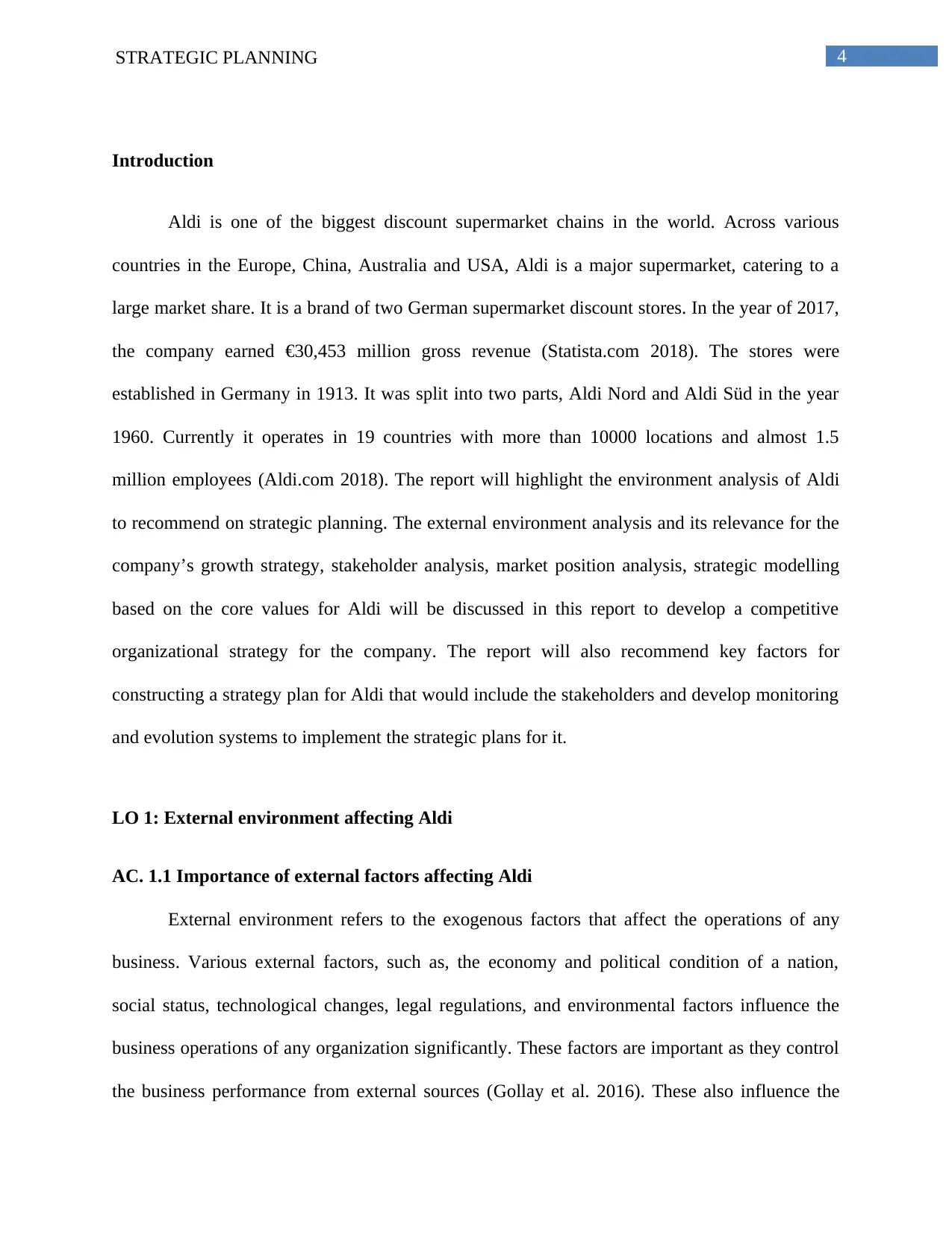
4STRATEGIC PLANNING
Introduction
Aldi is one of the biggest discount supermarket chains in the world. Across various
countries in the Europe, China, Australia and USA, Aldi is a major supermarket, catering to a
large market share. It is a brand of two German supermarket discount stores. In the year of 2017,
the company earned €30,453 million gross revenue (Statista.com 2018). The stores were
established in Germany in 1913. It was split into two parts, Aldi Nord and Aldi Süd in the year
1960. Currently it operates in 19 countries with more than 10000 locations and almost 1.5
million employees (Aldi.com 2018). The report will highlight the environment analysis of Aldi
to recommend on strategic planning. The external environment analysis and its relevance for the
company’s growth strategy, stakeholder analysis, market position analysis, strategic modelling
based on the core values for Aldi will be discussed in this report to develop a competitive
organizational strategy for the company. The report will also recommend key factors for
constructing a strategy plan for Aldi that would include the stakeholders and develop monitoring
and evolution systems to implement the strategic plans for it.
LO 1: External environment affecting Aldi
AC. 1.1 Importance of external factors affecting Aldi
External environment refers to the exogenous factors that affect the operations of any
business. Various external factors, such as, the economy and political condition of a nation,
social status, technological changes, legal regulations, and environmental factors influence the
business operations of any organization significantly. These factors are important as they control
the business performance from external sources (Gollay et al. 2016). These also influence the
Introduction
Aldi is one of the biggest discount supermarket chains in the world. Across various
countries in the Europe, China, Australia and USA, Aldi is a major supermarket, catering to a
large market share. It is a brand of two German supermarket discount stores. In the year of 2017,
the company earned €30,453 million gross revenue (Statista.com 2018). The stores were
established in Germany in 1913. It was split into two parts, Aldi Nord and Aldi Süd in the year
1960. Currently it operates in 19 countries with more than 10000 locations and almost 1.5
million employees (Aldi.com 2018). The report will highlight the environment analysis of Aldi
to recommend on strategic planning. The external environment analysis and its relevance for the
company’s growth strategy, stakeholder analysis, market position analysis, strategic modelling
based on the core values for Aldi will be discussed in this report to develop a competitive
organizational strategy for the company. The report will also recommend key factors for
constructing a strategy plan for Aldi that would include the stakeholders and develop monitoring
and evolution systems to implement the strategic plans for it.
LO 1: External environment affecting Aldi
AC. 1.1 Importance of external factors affecting Aldi
External environment refers to the exogenous factors that affect the operations of any
business. Various external factors, such as, the economy and political condition of a nation,
social status, technological changes, legal regulations, and environmental factors influence the
business operations of any organization significantly. These factors are important as they control
the business performance from external sources (Gollay et al. 2016). These also influence the
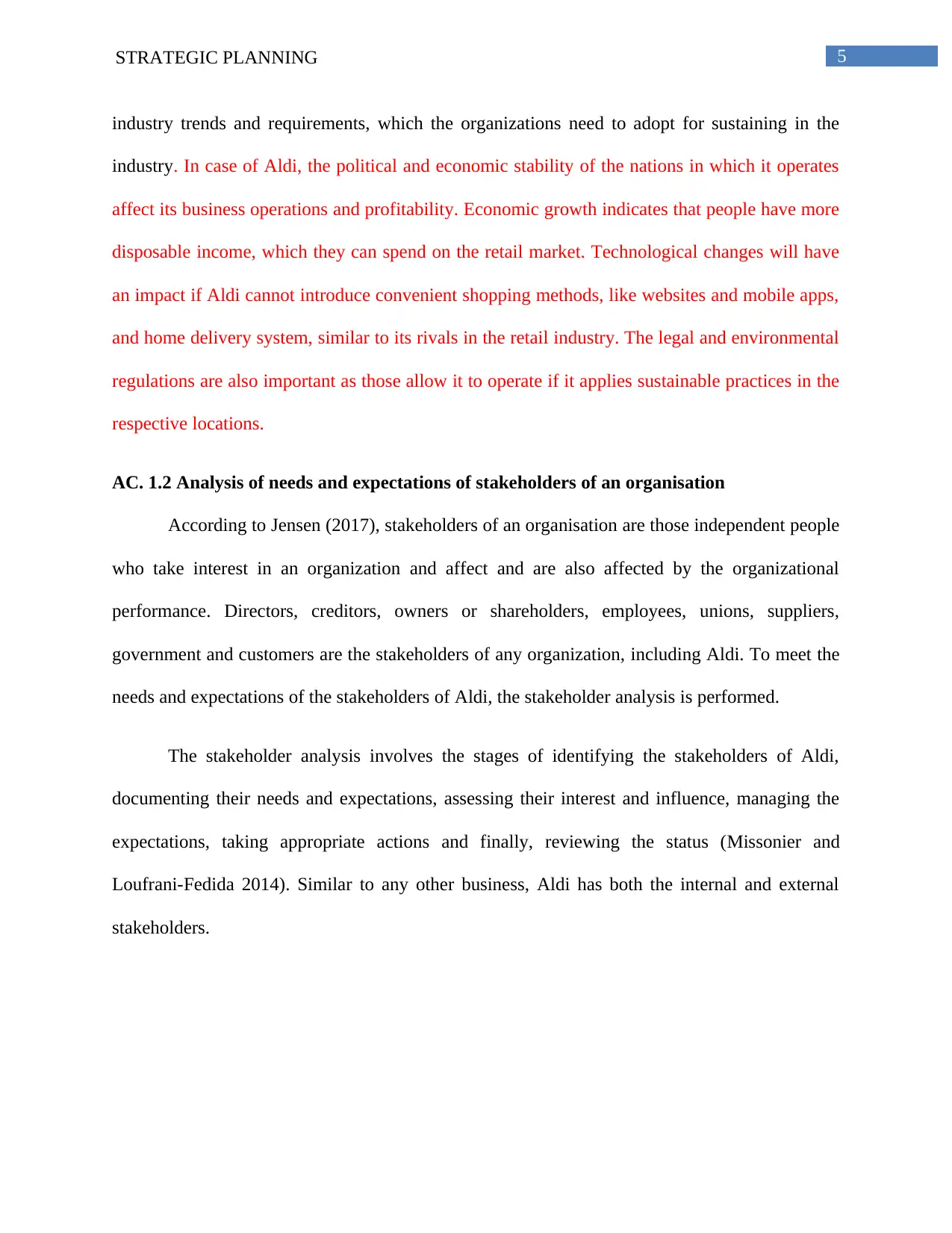
5STRATEGIC PLANNING
industry trends and requirements, which the organizations need to adopt for sustaining in the
industry. In case of Aldi, the political and economic stability of the nations in which it operates
affect its business operations and profitability. Economic growth indicates that people have more
disposable income, which they can spend on the retail market. Technological changes will have
an impact if Aldi cannot introduce convenient shopping methods, like websites and mobile apps,
and home delivery system, similar to its rivals in the retail industry. The legal and environmental
regulations are also important as those allow it to operate if it applies sustainable practices in the
respective locations.
AC. 1.2 Analysis of needs and expectations of stakeholders of an organisation
According to Jensen (2017), stakeholders of an organisation are those independent people
who take interest in an organization and affect and are also affected by the organizational
performance. Directors, creditors, owners or shareholders, employees, unions, suppliers,
government and customers are the stakeholders of any organization, including Aldi. To meet the
needs and expectations of the stakeholders of Aldi, the stakeholder analysis is performed.
The stakeholder analysis involves the stages of identifying the stakeholders of Aldi,
documenting their needs and expectations, assessing their interest and influence, managing the
expectations, taking appropriate actions and finally, reviewing the status (Missonier and
Loufrani-Fedida 2014). Similar to any other business, Aldi has both the internal and external
stakeholders.
industry trends and requirements, which the organizations need to adopt for sustaining in the
industry. In case of Aldi, the political and economic stability of the nations in which it operates
affect its business operations and profitability. Economic growth indicates that people have more
disposable income, which they can spend on the retail market. Technological changes will have
an impact if Aldi cannot introduce convenient shopping methods, like websites and mobile apps,
and home delivery system, similar to its rivals in the retail industry. The legal and environmental
regulations are also important as those allow it to operate if it applies sustainable practices in the
respective locations.
AC. 1.2 Analysis of needs and expectations of stakeholders of an organisation
According to Jensen (2017), stakeholders of an organisation are those independent people
who take interest in an organization and affect and are also affected by the organizational
performance. Directors, creditors, owners or shareholders, employees, unions, suppliers,
government and customers are the stakeholders of any organization, including Aldi. To meet the
needs and expectations of the stakeholders of Aldi, the stakeholder analysis is performed.
The stakeholder analysis involves the stages of identifying the stakeholders of Aldi,
documenting their needs and expectations, assessing their interest and influence, managing the
expectations, taking appropriate actions and finally, reviewing the status (Missonier and
Loufrani-Fedida 2014). Similar to any other business, Aldi has both the internal and external
stakeholders.
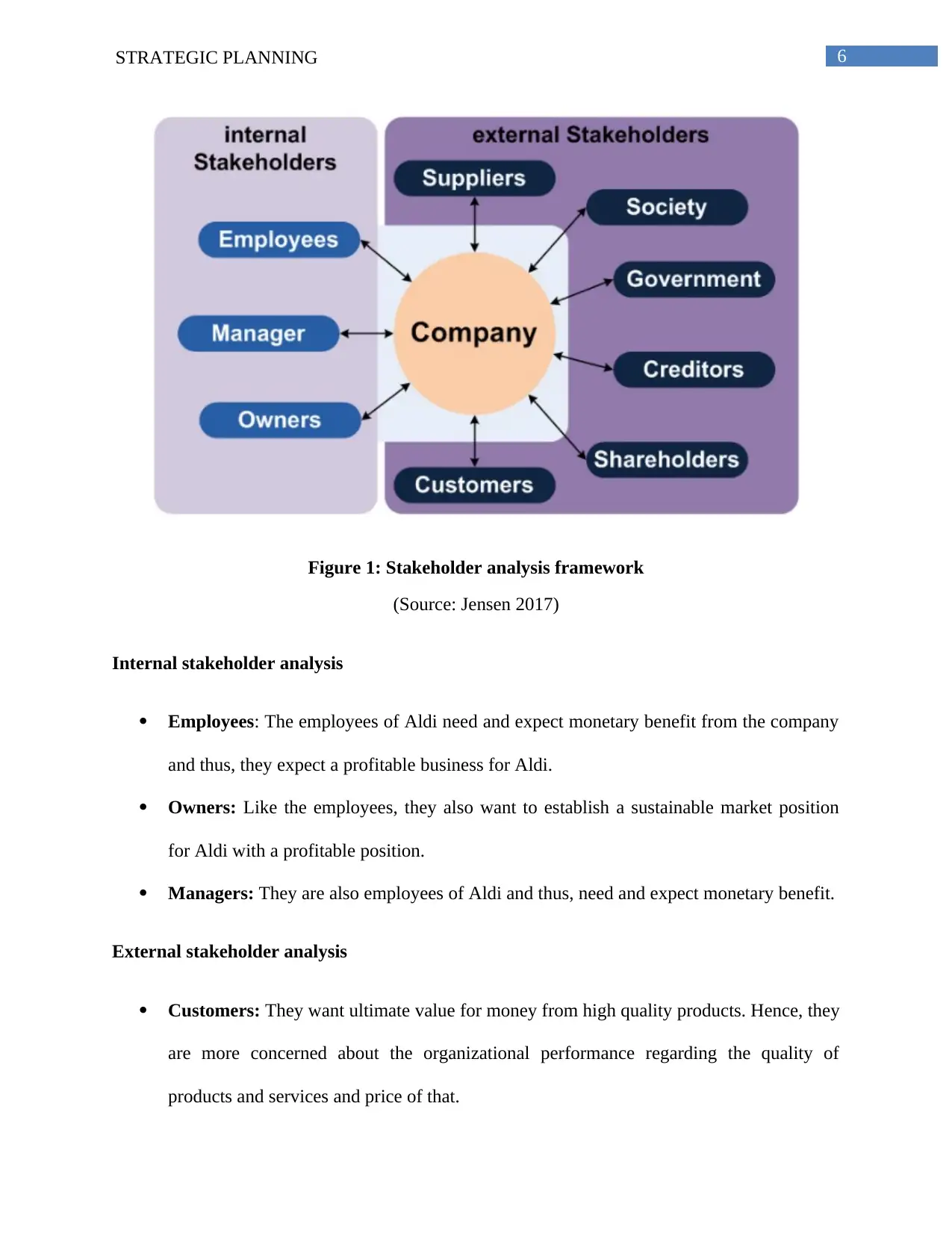
6STRATEGIC PLANNING
Figure 1: Stakeholder analysis framework
(Source: Jensen 2017)
Internal stakeholder analysis
Employees: The employees of Aldi need and expect monetary benefit from the company
and thus, they expect a profitable business for Aldi.
Owners: Like the employees, they also want to establish a sustainable market position
for Aldi with a profitable position.
Managers: They are also employees of Aldi and thus, need and expect monetary benefit.
External stakeholder analysis
Customers: They want ultimate value for money from high quality products. Hence, they
are more concerned about the organizational performance regarding the quality of
products and services and price of that.
Figure 1: Stakeholder analysis framework
(Source: Jensen 2017)
Internal stakeholder analysis
Employees: The employees of Aldi need and expect monetary benefit from the company
and thus, they expect a profitable business for Aldi.
Owners: Like the employees, they also want to establish a sustainable market position
for Aldi with a profitable position.
Managers: They are also employees of Aldi and thus, need and expect monetary benefit.
External stakeholder analysis
Customers: They want ultimate value for money from high quality products. Hence, they
are more concerned about the organizational performance regarding the quality of
products and services and price of that.
Paraphrase This Document
Need a fresh take? Get an instant paraphrase of this document with our AI Paraphraser
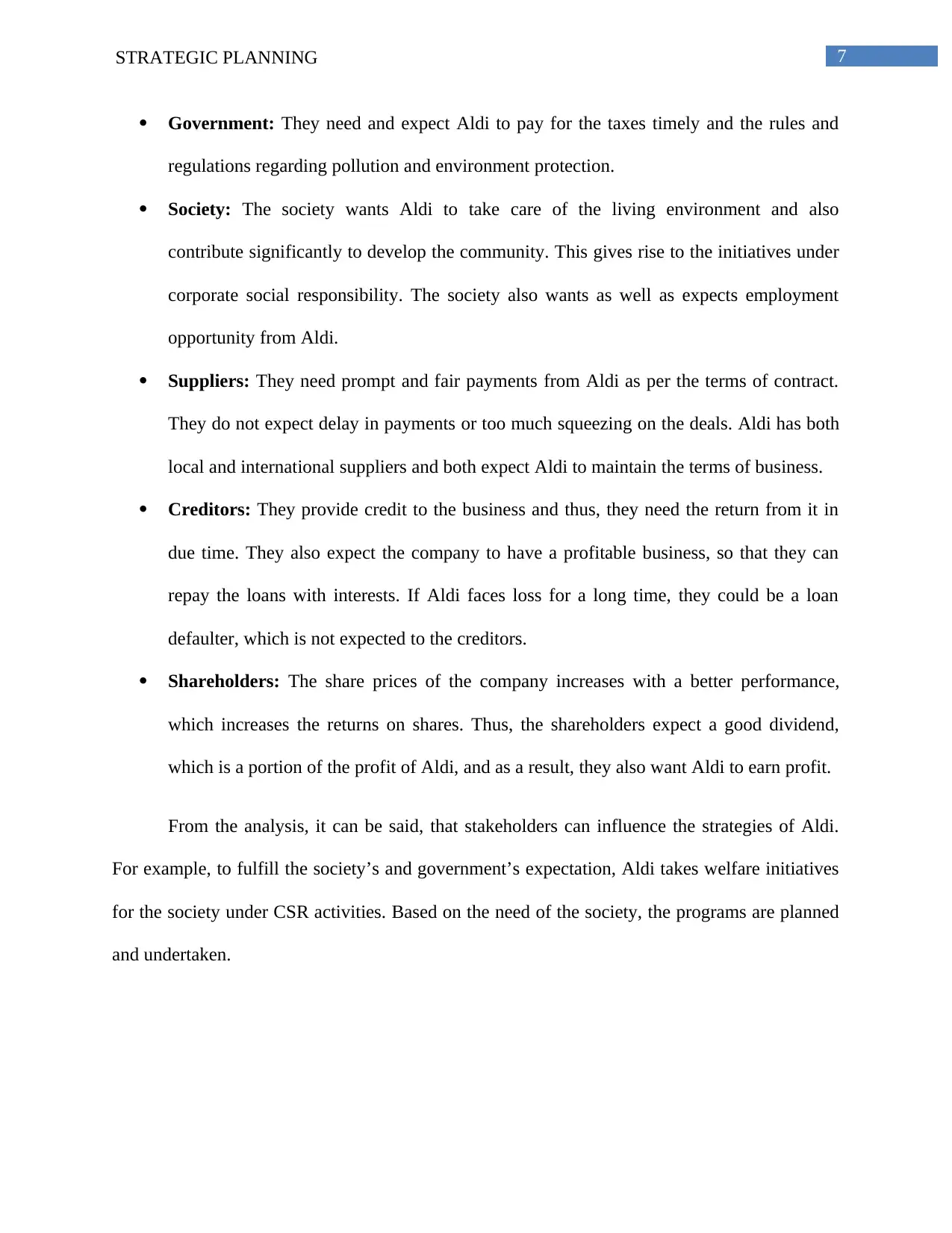
7STRATEGIC PLANNING
Government: They need and expect Aldi to pay for the taxes timely and the rules and
regulations regarding pollution and environment protection.
Society: The society wants Aldi to take care of the living environment and also
contribute significantly to develop the community. This gives rise to the initiatives under
corporate social responsibility. The society also wants as well as expects employment
opportunity from Aldi.
Suppliers: They need prompt and fair payments from Aldi as per the terms of contract.
They do not expect delay in payments or too much squeezing on the deals. Aldi has both
local and international suppliers and both expect Aldi to maintain the terms of business.
Creditors: They provide credit to the business and thus, they need the return from it in
due time. They also expect the company to have a profitable business, so that they can
repay the loans with interests. If Aldi faces loss for a long time, they could be a loan
defaulter, which is not expected to the creditors.
Shareholders: The share prices of the company increases with a better performance,
which increases the returns on shares. Thus, the shareholders expect a good dividend,
which is a portion of the profit of Aldi, and as a result, they also want Aldi to earn profit.
From the analysis, it can be said, that stakeholders can influence the strategies of Aldi.
For example, to fulfill the society’s and government’s expectation, Aldi takes welfare initiatives
for the society under CSR activities. Based on the need of the society, the programs are planned
and undertaken.
Government: They need and expect Aldi to pay for the taxes timely and the rules and
regulations regarding pollution and environment protection.
Society: The society wants Aldi to take care of the living environment and also
contribute significantly to develop the community. This gives rise to the initiatives under
corporate social responsibility. The society also wants as well as expects employment
opportunity from Aldi.
Suppliers: They need prompt and fair payments from Aldi as per the terms of contract.
They do not expect delay in payments or too much squeezing on the deals. Aldi has both
local and international suppliers and both expect Aldi to maintain the terms of business.
Creditors: They provide credit to the business and thus, they need the return from it in
due time. They also expect the company to have a profitable business, so that they can
repay the loans with interests. If Aldi faces loss for a long time, they could be a loan
defaulter, which is not expected to the creditors.
Shareholders: The share prices of the company increases with a better performance,
which increases the returns on shares. Thus, the shareholders expect a good dividend,
which is a portion of the profit of Aldi, and as a result, they also want Aldi to earn profit.
From the analysis, it can be said, that stakeholders can influence the strategies of Aldi.
For example, to fulfill the society’s and government’s expectation, Aldi takes welfare initiatives
for the society under CSR activities. Based on the need of the society, the programs are planned
and undertaken.
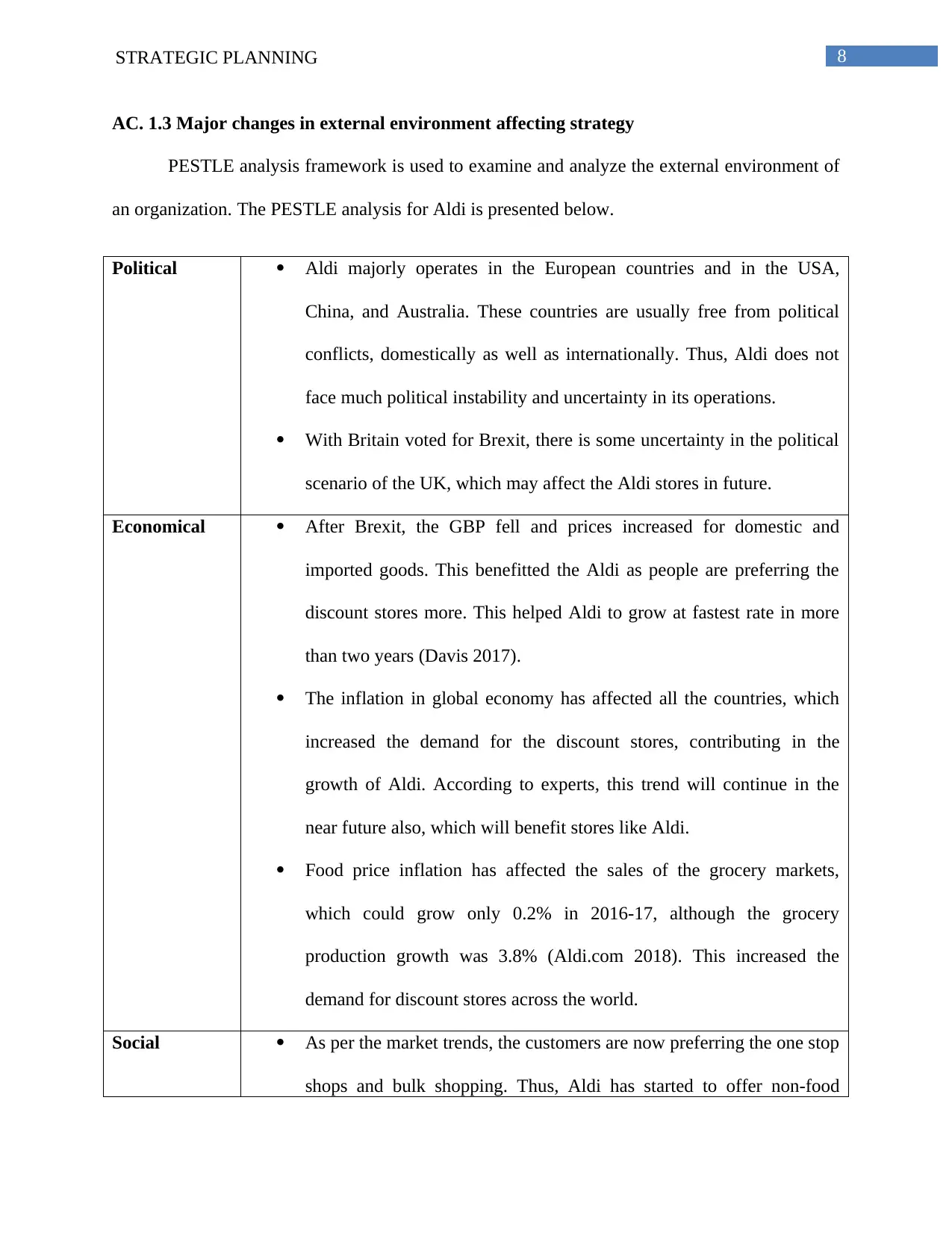
8STRATEGIC PLANNING
AC. 1.3 Major changes in external environment affecting strategy
PESTLE analysis framework is used to examine and analyze the external environment of
an organization. The PESTLE analysis for Aldi is presented below.
Political Aldi majorly operates in the European countries and in the USA,
China, and Australia. These countries are usually free from political
conflicts, domestically as well as internationally. Thus, Aldi does not
face much political instability and uncertainty in its operations.
With Britain voted for Brexit, there is some uncertainty in the political
scenario of the UK, which may affect the Aldi stores in future.
Economical After Brexit, the GBP fell and prices increased for domestic and
imported goods. This benefitted the Aldi as people are preferring the
discount stores more. This helped Aldi to grow at fastest rate in more
than two years (Davis 2017).
The inflation in global economy has affected all the countries, which
increased the demand for the discount stores, contributing in the
growth of Aldi. According to experts, this trend will continue in the
near future also, which will benefit stores like Aldi.
Food price inflation has affected the sales of the grocery markets,
which could grow only 0.2% in 2016-17, although the grocery
production growth was 3.8% (Aldi.com 2018). This increased the
demand for discount stores across the world.
Social As per the market trends, the customers are now preferring the one stop
shops and bulk shopping. Thus, Aldi has started to offer non-food
AC. 1.3 Major changes in external environment affecting strategy
PESTLE analysis framework is used to examine and analyze the external environment of
an organization. The PESTLE analysis for Aldi is presented below.
Political Aldi majorly operates in the European countries and in the USA,
China, and Australia. These countries are usually free from political
conflicts, domestically as well as internationally. Thus, Aldi does not
face much political instability and uncertainty in its operations.
With Britain voted for Brexit, there is some uncertainty in the political
scenario of the UK, which may affect the Aldi stores in future.
Economical After Brexit, the GBP fell and prices increased for domestic and
imported goods. This benefitted the Aldi as people are preferring the
discount stores more. This helped Aldi to grow at fastest rate in more
than two years (Davis 2017).
The inflation in global economy has affected all the countries, which
increased the demand for the discount stores, contributing in the
growth of Aldi. According to experts, this trend will continue in the
near future also, which will benefit stores like Aldi.
Food price inflation has affected the sales of the grocery markets,
which could grow only 0.2% in 2016-17, although the grocery
production growth was 3.8% (Aldi.com 2018). This increased the
demand for discount stores across the world.
Social As per the market trends, the customers are now preferring the one stop
shops and bulk shopping. Thus, Aldi has started to offer non-food
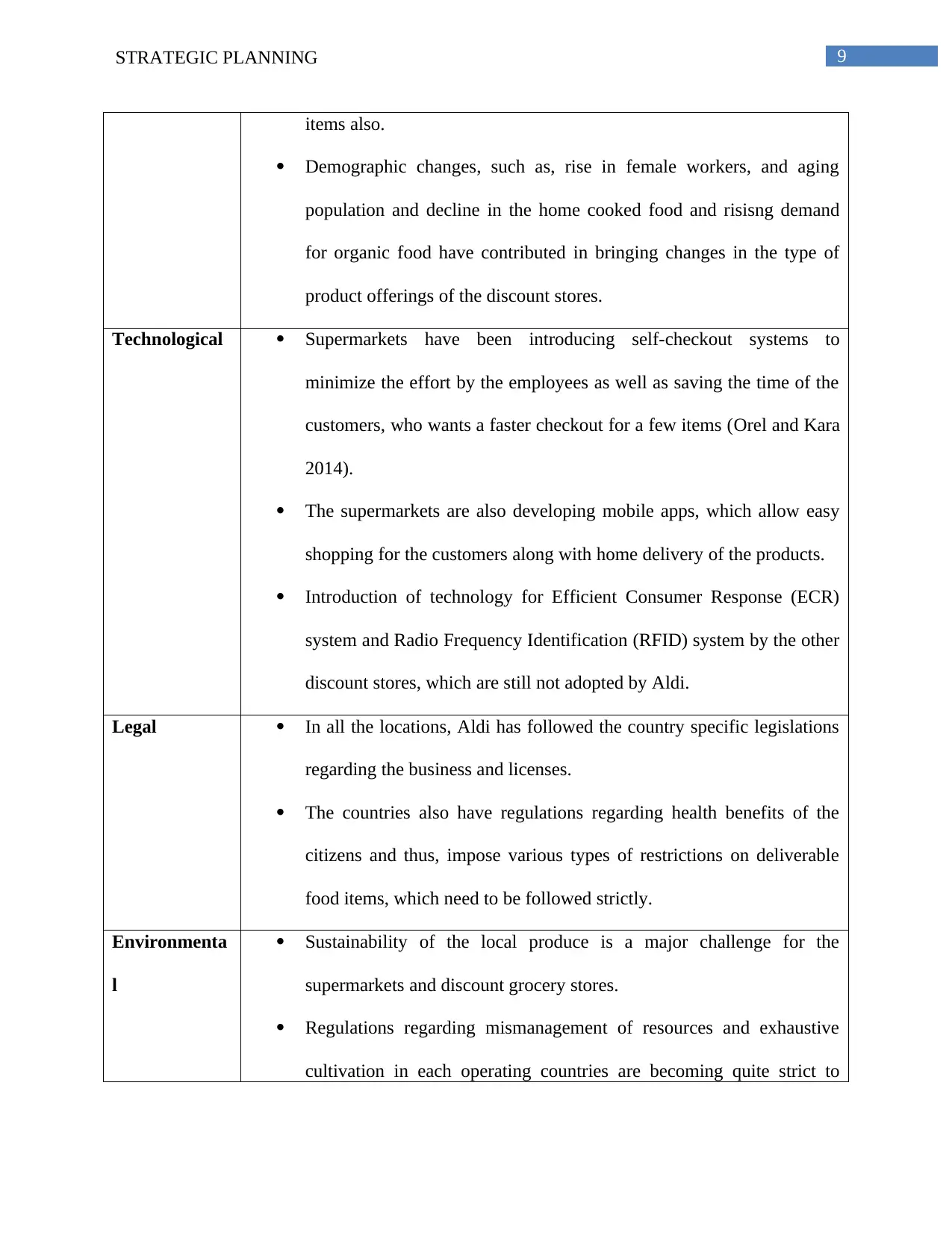
9STRATEGIC PLANNING
items also.
Demographic changes, such as, rise in female workers, and aging
population and decline in the home cooked food and risisng demand
for organic food have contributed in bringing changes in the type of
product offerings of the discount stores.
Technological Supermarkets have been introducing self-checkout systems to
minimize the effort by the employees as well as saving the time of the
customers, who wants a faster checkout for a few items (Orel and Kara
2014).
The supermarkets are also developing mobile apps, which allow easy
shopping for the customers along with home delivery of the products.
Introduction of technology for Efficient Consumer Response (ECR)
system and Radio Frequency Identification (RFID) system by the other
discount stores, which are still not adopted by Aldi.
Legal In all the locations, Aldi has followed the country specific legislations
regarding the business and licenses.
The countries also have regulations regarding health benefits of the
citizens and thus, impose various types of restrictions on deliverable
food items, which need to be followed strictly.
Environmenta
l
Sustainability of the local produce is a major challenge for the
supermarkets and discount grocery stores.
Regulations regarding mismanagement of resources and exhaustive
cultivation in each operating countries are becoming quite strict to
items also.
Demographic changes, such as, rise in female workers, and aging
population and decline in the home cooked food and risisng demand
for organic food have contributed in bringing changes in the type of
product offerings of the discount stores.
Technological Supermarkets have been introducing self-checkout systems to
minimize the effort by the employees as well as saving the time of the
customers, who wants a faster checkout for a few items (Orel and Kara
2014).
The supermarkets are also developing mobile apps, which allow easy
shopping for the customers along with home delivery of the products.
Introduction of technology for Efficient Consumer Response (ECR)
system and Radio Frequency Identification (RFID) system by the other
discount stores, which are still not adopted by Aldi.
Legal In all the locations, Aldi has followed the country specific legislations
regarding the business and licenses.
The countries also have regulations regarding health benefits of the
citizens and thus, impose various types of restrictions on deliverable
food items, which need to be followed strictly.
Environmenta
l
Sustainability of the local produce is a major challenge for the
supermarkets and discount grocery stores.
Regulations regarding mismanagement of resources and exhaustive
cultivation in each operating countries are becoming quite strict to
Secure Best Marks with AI Grader
Need help grading? Try our AI Grader for instant feedback on your assignments.
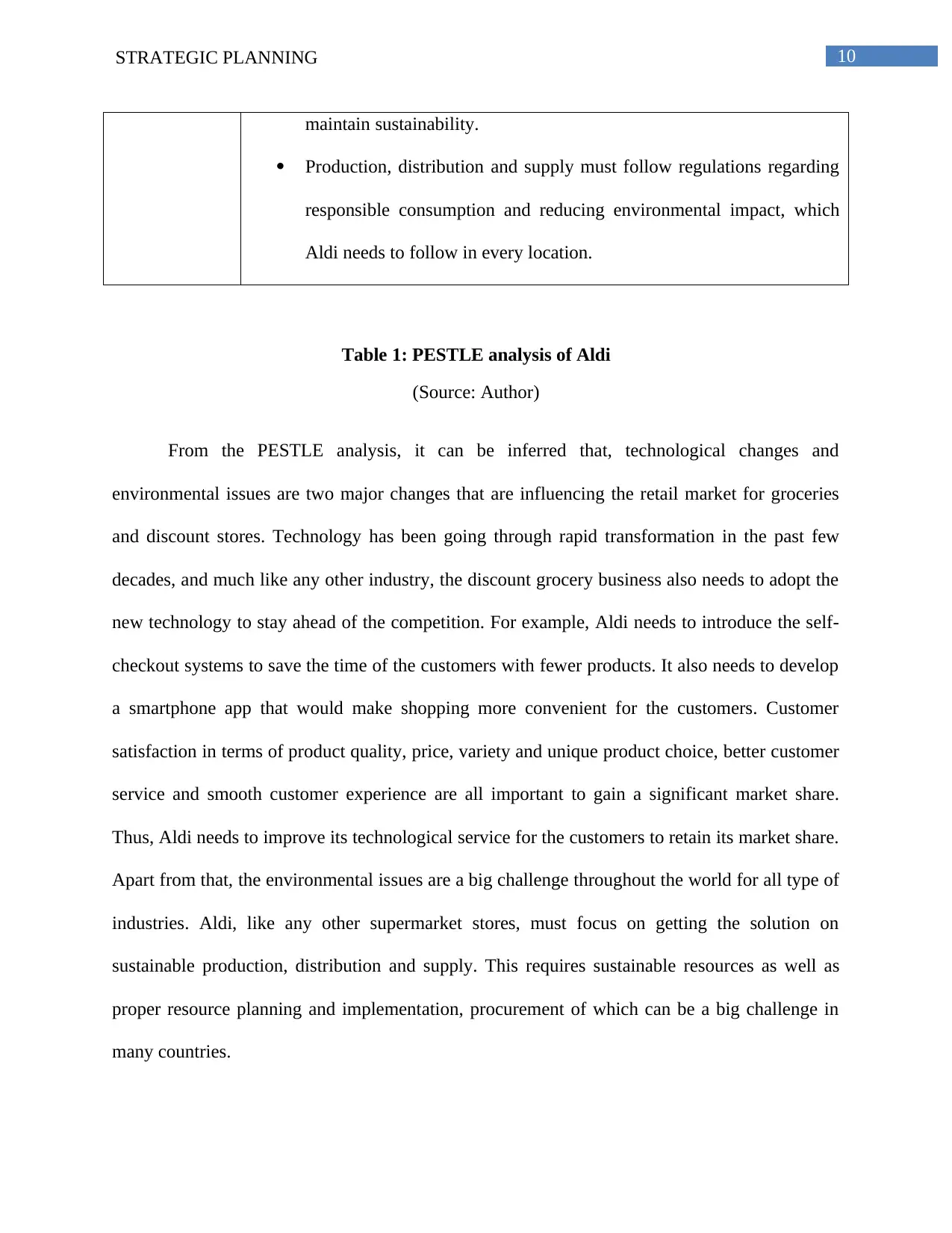
10STRATEGIC PLANNING
maintain sustainability.
Production, distribution and supply must follow regulations regarding
responsible consumption and reducing environmental impact, which
Aldi needs to follow in every location.
Table 1: PESTLE analysis of Aldi
(Source: Author)
From the PESTLE analysis, it can be inferred that, technological changes and
environmental issues are two major changes that are influencing the retail market for groceries
and discount stores. Technology has been going through rapid transformation in the past few
decades, and much like any other industry, the discount grocery business also needs to adopt the
new technology to stay ahead of the competition. For example, Aldi needs to introduce the self-
checkout systems to save the time of the customers with fewer products. It also needs to develop
a smartphone app that would make shopping more convenient for the customers. Customer
satisfaction in terms of product quality, price, variety and unique product choice, better customer
service and smooth customer experience are all important to gain a significant market share.
Thus, Aldi needs to improve its technological service for the customers to retain its market share.
Apart from that, the environmental issues are a big challenge throughout the world for all type of
industries. Aldi, like any other supermarket stores, must focus on getting the solution on
sustainable production, distribution and supply. This requires sustainable resources as well as
proper resource planning and implementation, procurement of which can be a big challenge in
many countries.
maintain sustainability.
Production, distribution and supply must follow regulations regarding
responsible consumption and reducing environmental impact, which
Aldi needs to follow in every location.
Table 1: PESTLE analysis of Aldi
(Source: Author)
From the PESTLE analysis, it can be inferred that, technological changes and
environmental issues are two major changes that are influencing the retail market for groceries
and discount stores. Technology has been going through rapid transformation in the past few
decades, and much like any other industry, the discount grocery business also needs to adopt the
new technology to stay ahead of the competition. For example, Aldi needs to introduce the self-
checkout systems to save the time of the customers with fewer products. It also needs to develop
a smartphone app that would make shopping more convenient for the customers. Customer
satisfaction in terms of product quality, price, variety and unique product choice, better customer
service and smooth customer experience are all important to gain a significant market share.
Thus, Aldi needs to improve its technological service for the customers to retain its market share.
Apart from that, the environmental issues are a big challenge throughout the world for all type of
industries. Aldi, like any other supermarket stores, must focus on getting the solution on
sustainable production, distribution and supply. This requires sustainable resources as well as
proper resource planning and implementation, procurement of which can be a big challenge in
many countries.
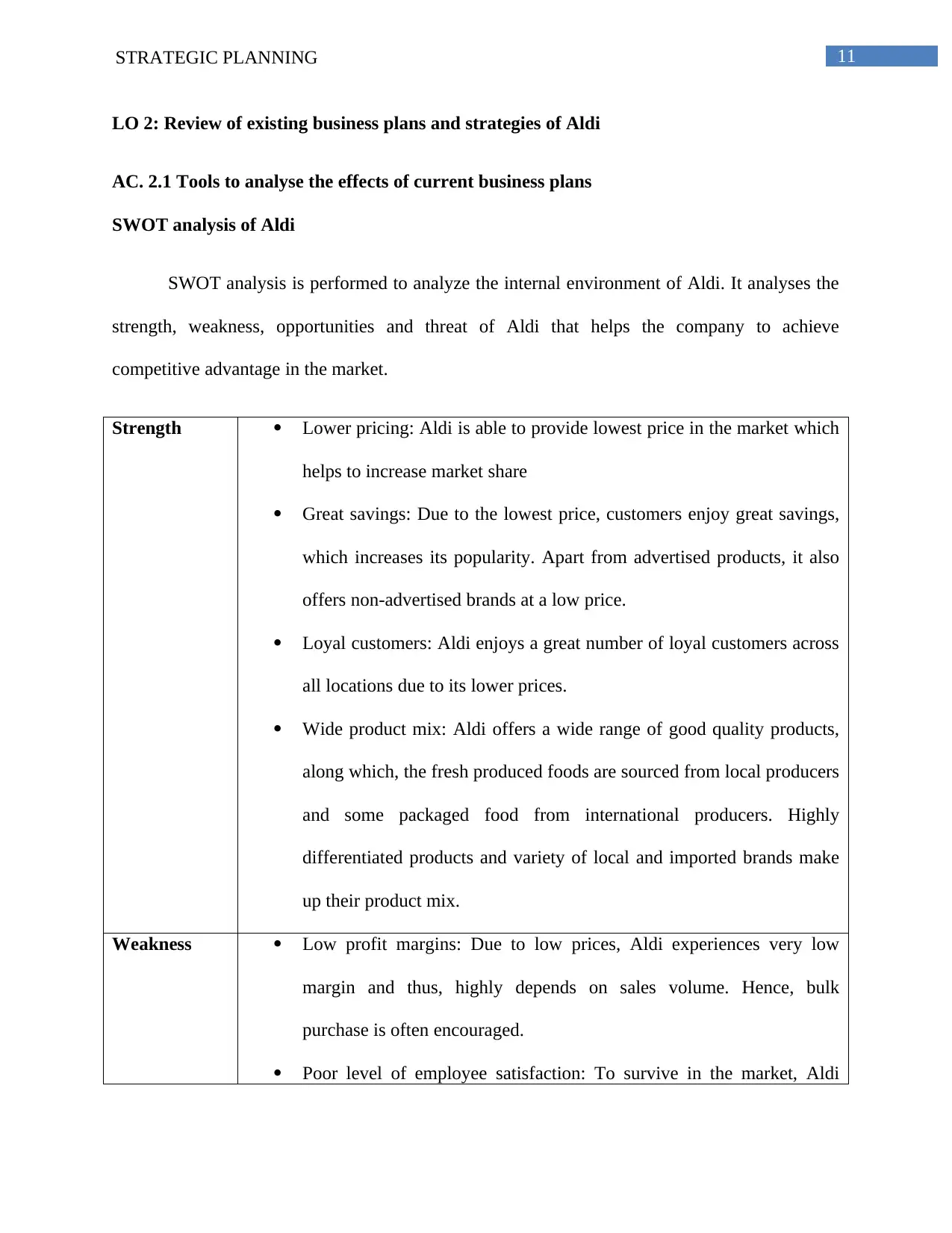
11STRATEGIC PLANNING
LO 2: Review of existing business plans and strategies of Aldi
AC. 2.1 Tools to analyse the effects of current business plans
SWOT analysis of Aldi
SWOT analysis is performed to analyze the internal environment of Aldi. It analyses the
strength, weakness, opportunities and threat of Aldi that helps the company to achieve
competitive advantage in the market.
Strength Lower pricing: Aldi is able to provide lowest price in the market which
helps to increase market share
Great savings: Due to the lowest price, customers enjoy great savings,
which increases its popularity. Apart from advertised products, it also
offers non-advertised brands at a low price.
Loyal customers: Aldi enjoys a great number of loyal customers across
all locations due to its lower prices.
Wide product mix: Aldi offers a wide range of good quality products,
along which, the fresh produced foods are sourced from local producers
and some packaged food from international producers. Highly
differentiated products and variety of local and imported brands make
up their product mix.
Weakness Low profit margins: Due to low prices, Aldi experiences very low
margin and thus, highly depends on sales volume. Hence, bulk
purchase is often encouraged.
Poor level of employee satisfaction: To survive in the market, Aldi
LO 2: Review of existing business plans and strategies of Aldi
AC. 2.1 Tools to analyse the effects of current business plans
SWOT analysis of Aldi
SWOT analysis is performed to analyze the internal environment of Aldi. It analyses the
strength, weakness, opportunities and threat of Aldi that helps the company to achieve
competitive advantage in the market.
Strength Lower pricing: Aldi is able to provide lowest price in the market which
helps to increase market share
Great savings: Due to the lowest price, customers enjoy great savings,
which increases its popularity. Apart from advertised products, it also
offers non-advertised brands at a low price.
Loyal customers: Aldi enjoys a great number of loyal customers across
all locations due to its lower prices.
Wide product mix: Aldi offers a wide range of good quality products,
along which, the fresh produced foods are sourced from local producers
and some packaged food from international producers. Highly
differentiated products and variety of local and imported brands make
up their product mix.
Weakness Low profit margins: Due to low prices, Aldi experiences very low
margin and thus, highly depends on sales volume. Hence, bulk
purchase is often encouraged.
Poor level of employee satisfaction: To survive in the market, Aldi
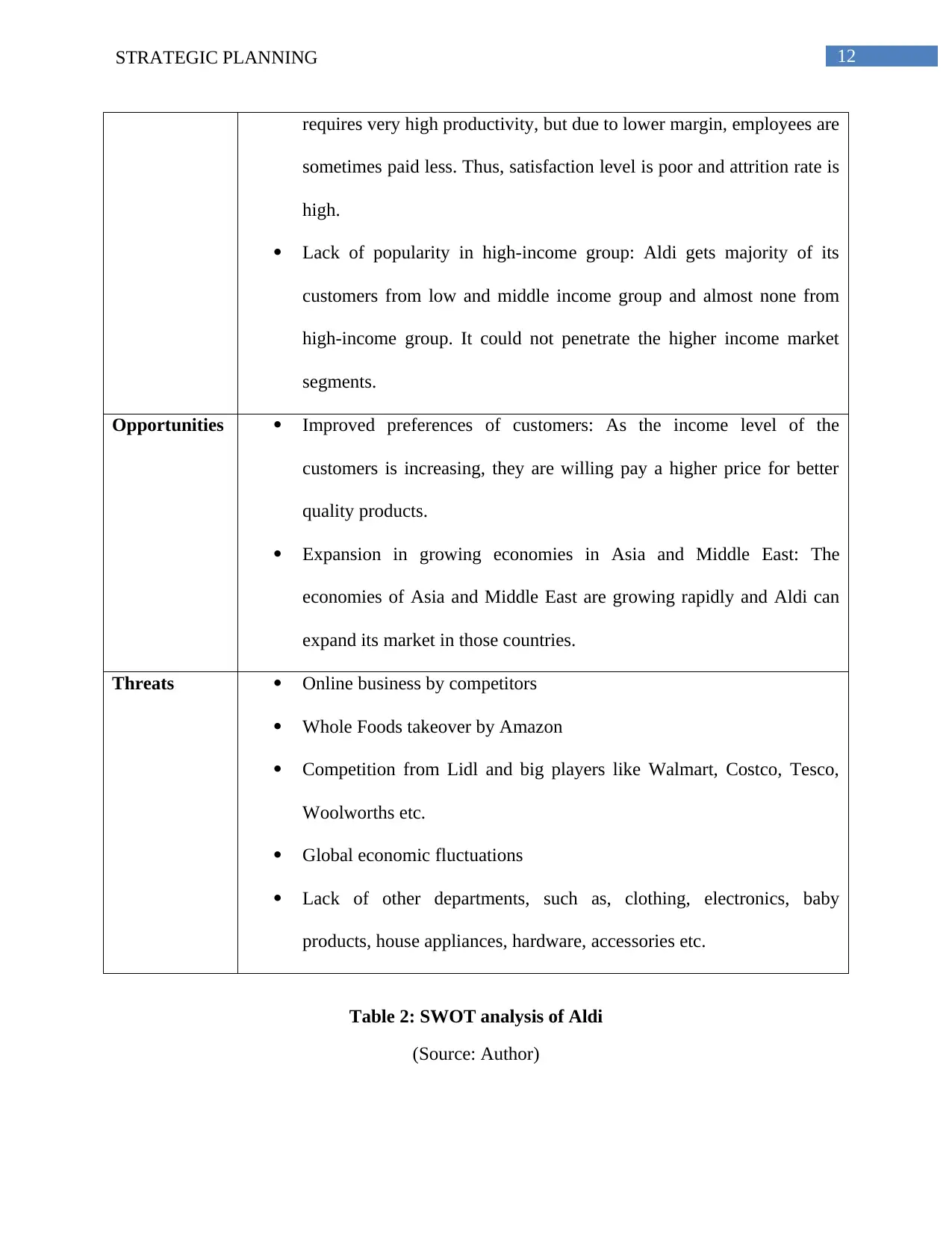
12STRATEGIC PLANNING
requires very high productivity, but due to lower margin, employees are
sometimes paid less. Thus, satisfaction level is poor and attrition rate is
high.
Lack of popularity in high-income group: Aldi gets majority of its
customers from low and middle income group and almost none from
high-income group. It could not penetrate the higher income market
segments.
Opportunities Improved preferences of customers: As the income level of the
customers is increasing, they are willing pay a higher price for better
quality products.
Expansion in growing economies in Asia and Middle East: The
economies of Asia and Middle East are growing rapidly and Aldi can
expand its market in those countries.
Threats Online business by competitors
Whole Foods takeover by Amazon
Competition from Lidl and big players like Walmart, Costco, Tesco,
Woolworths etc.
Global economic fluctuations
Lack of other departments, such as, clothing, electronics, baby
products, house appliances, hardware, accessories etc.
Table 2: SWOT analysis of Aldi
(Source: Author)
requires very high productivity, but due to lower margin, employees are
sometimes paid less. Thus, satisfaction level is poor and attrition rate is
high.
Lack of popularity in high-income group: Aldi gets majority of its
customers from low and middle income group and almost none from
high-income group. It could not penetrate the higher income market
segments.
Opportunities Improved preferences of customers: As the income level of the
customers is increasing, they are willing pay a higher price for better
quality products.
Expansion in growing economies in Asia and Middle East: The
economies of Asia and Middle East are growing rapidly and Aldi can
expand its market in those countries.
Threats Online business by competitors
Whole Foods takeover by Amazon
Competition from Lidl and big players like Walmart, Costco, Tesco,
Woolworths etc.
Global economic fluctuations
Lack of other departments, such as, clothing, electronics, baby
products, house appliances, hardware, accessories etc.
Table 2: SWOT analysis of Aldi
(Source: Author)
Paraphrase This Document
Need a fresh take? Get an instant paraphrase of this document with our AI Paraphraser
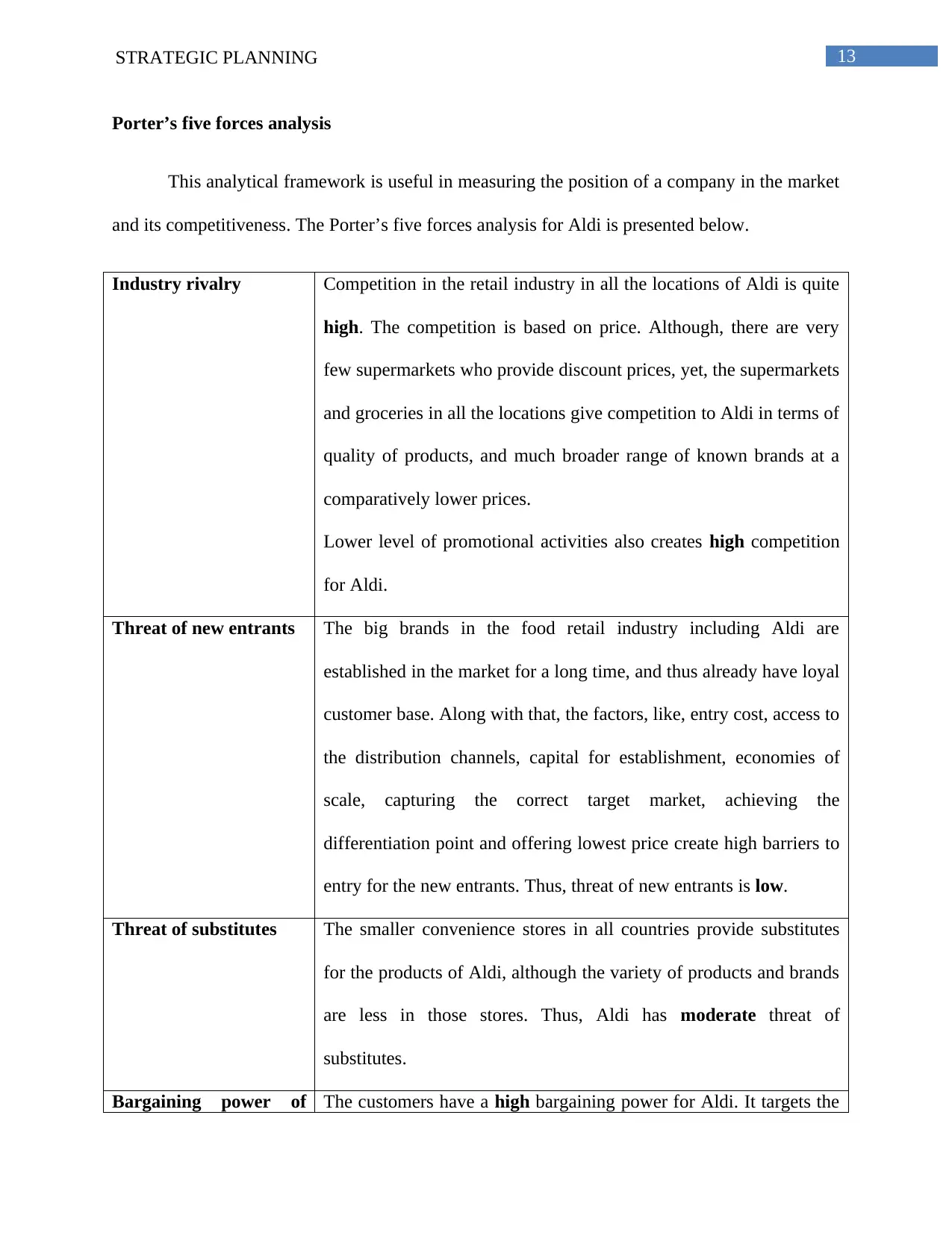
13STRATEGIC PLANNING
Porter’s five forces analysis
This analytical framework is useful in measuring the position of a company in the market
and its competitiveness. The Porter’s five forces analysis for Aldi is presented below.
Industry rivalry Competition in the retail industry in all the locations of Aldi is quite
high. The competition is based on price. Although, there are very
few supermarkets who provide discount prices, yet, the supermarkets
and groceries in all the locations give competition to Aldi in terms of
quality of products, and much broader range of known brands at a
comparatively lower prices.
Lower level of promotional activities also creates high competition
for Aldi.
Threat of new entrants The big brands in the food retail industry including Aldi are
established in the market for a long time, and thus already have loyal
customer base. Along with that, the factors, like, entry cost, access to
the distribution channels, capital for establishment, economies of
scale, capturing the correct target market, achieving the
differentiation point and offering lowest price create high barriers to
entry for the new entrants. Thus, threat of new entrants is low.
Threat of substitutes The smaller convenience stores in all countries provide substitutes
for the products of Aldi, although the variety of products and brands
are less in those stores. Thus, Aldi has moderate threat of
substitutes.
Bargaining power of The customers have a high bargaining power for Aldi. It targets the
Porter’s five forces analysis
This analytical framework is useful in measuring the position of a company in the market
and its competitiveness. The Porter’s five forces analysis for Aldi is presented below.
Industry rivalry Competition in the retail industry in all the locations of Aldi is quite
high. The competition is based on price. Although, there are very
few supermarkets who provide discount prices, yet, the supermarkets
and groceries in all the locations give competition to Aldi in terms of
quality of products, and much broader range of known brands at a
comparatively lower prices.
Lower level of promotional activities also creates high competition
for Aldi.
Threat of new entrants The big brands in the food retail industry including Aldi are
established in the market for a long time, and thus already have loyal
customer base. Along with that, the factors, like, entry cost, access to
the distribution channels, capital for establishment, economies of
scale, capturing the correct target market, achieving the
differentiation point and offering lowest price create high barriers to
entry for the new entrants. Thus, threat of new entrants is low.
Threat of substitutes The smaller convenience stores in all countries provide substitutes
for the products of Aldi, although the variety of products and brands
are less in those stores. Thus, Aldi has moderate threat of
substitutes.
Bargaining power of The customers have a high bargaining power for Aldi. It targets the
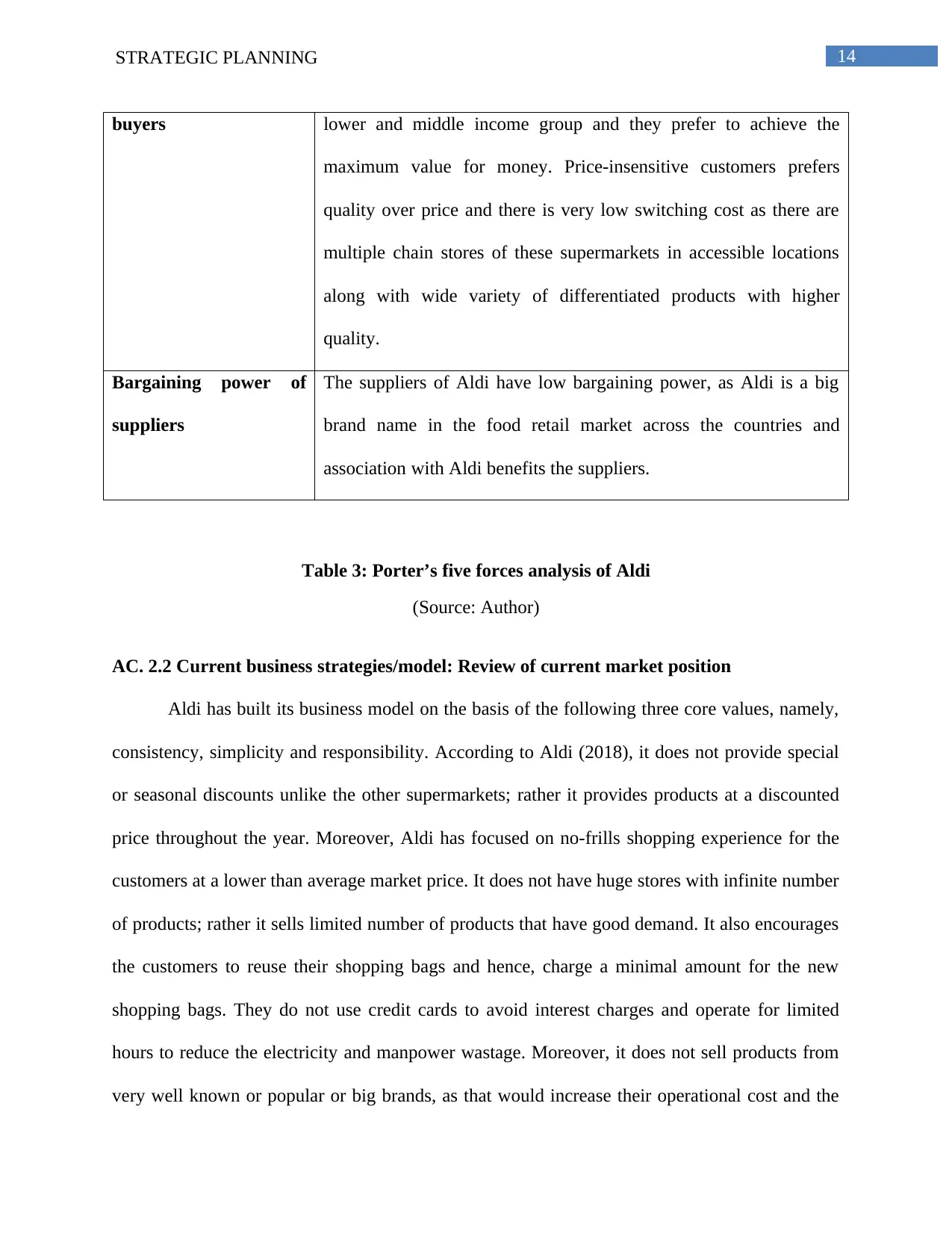
14STRATEGIC PLANNING
buyers lower and middle income group and they prefer to achieve the
maximum value for money. Price-insensitive customers prefers
quality over price and there is very low switching cost as there are
multiple chain stores of these supermarkets in accessible locations
along with wide variety of differentiated products with higher
quality.
Bargaining power of
suppliers
The suppliers of Aldi have low bargaining power, as Aldi is a big
brand name in the food retail market across the countries and
association with Aldi benefits the suppliers.
Table 3: Porter’s five forces analysis of Aldi
(Source: Author)
AC. 2.2 Current business strategies/model: Review of current market position
Aldi has built its business model on the basis of the following three core values, namely,
consistency, simplicity and responsibility. According to Aldi (2018), it does not provide special
or seasonal discounts unlike the other supermarkets; rather it provides products at a discounted
price throughout the year. Moreover, Aldi has focused on no-frills shopping experience for the
customers at a lower than average market price. It does not have huge stores with infinite number
of products; rather it sells limited number of products that have good demand. It also encourages
the customers to reuse their shopping bags and hence, charge a minimal amount for the new
shopping bags. They do not use credit cards to avoid interest charges and operate for limited
hours to reduce the electricity and manpower wastage. Moreover, it does not sell products from
very well known or popular or big brands, as that would increase their operational cost and the
buyers lower and middle income group and they prefer to achieve the
maximum value for money. Price-insensitive customers prefers
quality over price and there is very low switching cost as there are
multiple chain stores of these supermarkets in accessible locations
along with wide variety of differentiated products with higher
quality.
Bargaining power of
suppliers
The suppliers of Aldi have low bargaining power, as Aldi is a big
brand name in the food retail market across the countries and
association with Aldi benefits the suppliers.
Table 3: Porter’s five forces analysis of Aldi
(Source: Author)
AC. 2.2 Current business strategies/model: Review of current market position
Aldi has built its business model on the basis of the following three core values, namely,
consistency, simplicity and responsibility. According to Aldi (2018), it does not provide special
or seasonal discounts unlike the other supermarkets; rather it provides products at a discounted
price throughout the year. Moreover, Aldi has focused on no-frills shopping experience for the
customers at a lower than average market price. It does not have huge stores with infinite number
of products; rather it sells limited number of products that have good demand. It also encourages
the customers to reuse their shopping bags and hence, charge a minimal amount for the new
shopping bags. They do not use credit cards to avoid interest charges and operate for limited
hours to reduce the electricity and manpower wastage. Moreover, it does not sell products from
very well known or popular or big brands, as that would increase their operational cost and the
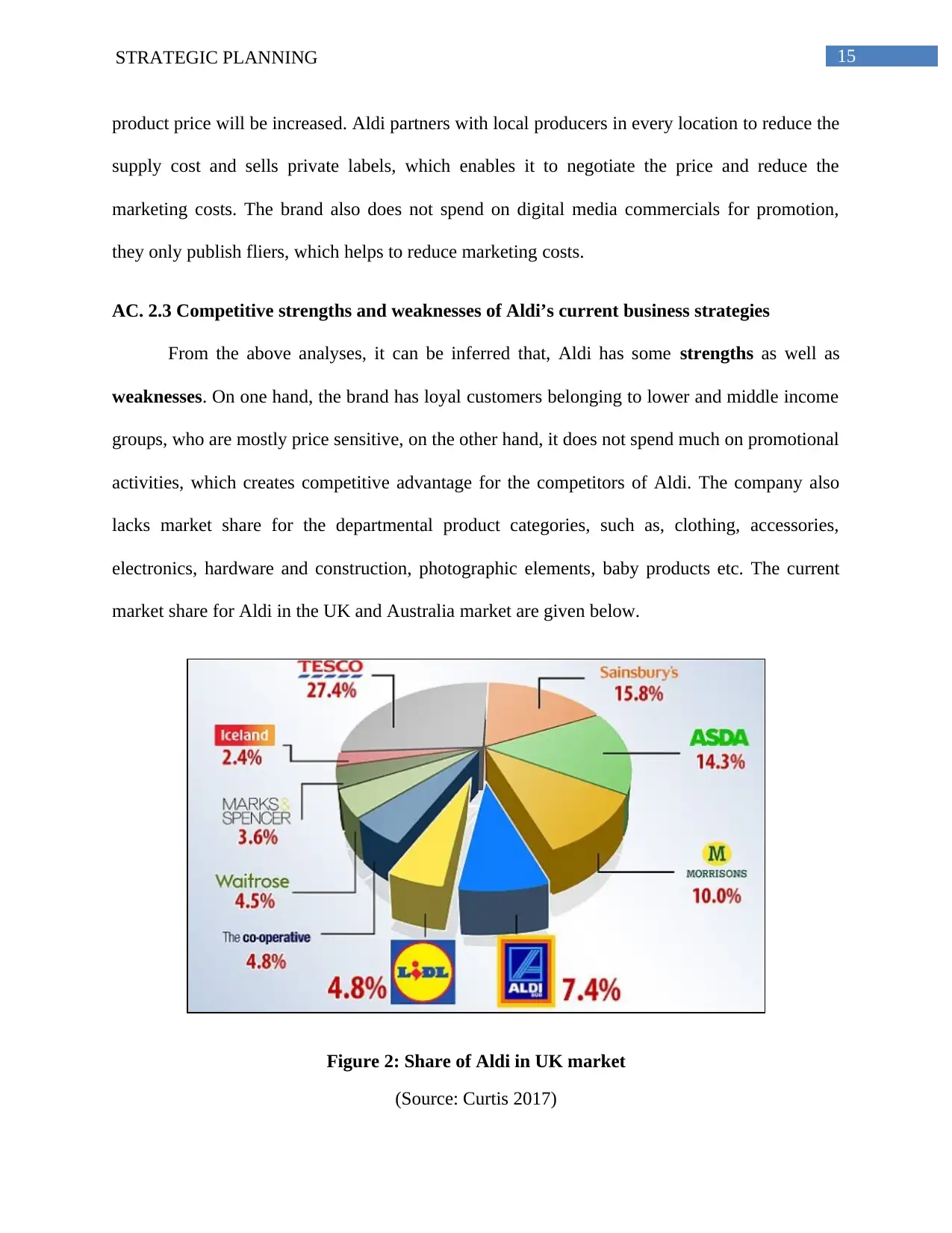
15STRATEGIC PLANNING
product price will be increased. Aldi partners with local producers in every location to reduce the
supply cost and sells private labels, which enables it to negotiate the price and reduce the
marketing costs. The brand also does not spend on digital media commercials for promotion,
they only publish fliers, which helps to reduce marketing costs.
AC. 2.3 Competitive strengths and weaknesses of Aldi’s current business strategies
From the above analyses, it can be inferred that, Aldi has some strengths as well as
weaknesses. On one hand, the brand has loyal customers belonging to lower and middle income
groups, who are mostly price sensitive, on the other hand, it does not spend much on promotional
activities, which creates competitive advantage for the competitors of Aldi. The company also
lacks market share for the departmental product categories, such as, clothing, accessories,
electronics, hardware and construction, photographic elements, baby products etc. The current
market share for Aldi in the UK and Australia market are given below.
Figure 2: Share of Aldi in UK market
(Source: Curtis 2017)
product price will be increased. Aldi partners with local producers in every location to reduce the
supply cost and sells private labels, which enables it to negotiate the price and reduce the
marketing costs. The brand also does not spend on digital media commercials for promotion,
they only publish fliers, which helps to reduce marketing costs.
AC. 2.3 Competitive strengths and weaknesses of Aldi’s current business strategies
From the above analyses, it can be inferred that, Aldi has some strengths as well as
weaknesses. On one hand, the brand has loyal customers belonging to lower and middle income
groups, who are mostly price sensitive, on the other hand, it does not spend much on promotional
activities, which creates competitive advantage for the competitors of Aldi. The company also
lacks market share for the departmental product categories, such as, clothing, accessories,
electronics, hardware and construction, photographic elements, baby products etc. The current
market share for Aldi in the UK and Australia market are given below.
Figure 2: Share of Aldi in UK market
(Source: Curtis 2017)
Secure Best Marks with AI Grader
Need help grading? Try our AI Grader for instant feedback on your assignments.
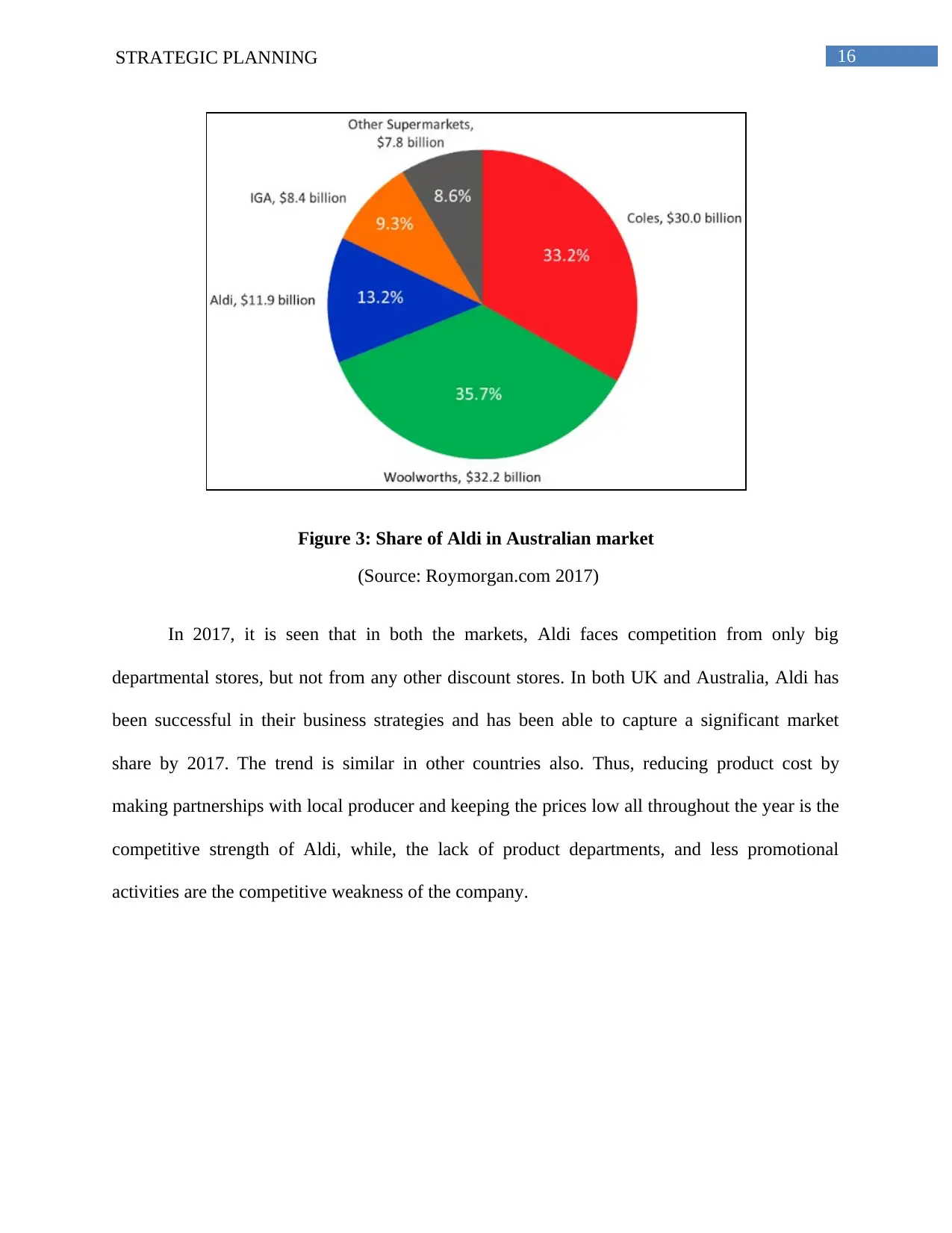
16STRATEGIC PLANNING
Figure 3: Share of Aldi in Australian market
(Source: Roymorgan.com 2017)
In 2017, it is seen that in both the markets, Aldi faces competition from only big
departmental stores, but not from any other discount stores. In both UK and Australia, Aldi has
been successful in their business strategies and has been able to capture a significant market
share by 2017. The trend is similar in other countries also. Thus, reducing product cost by
making partnerships with local producer and keeping the prices low all throughout the year is the
competitive strength of Aldi, while, the lack of product departments, and less promotional
activities are the competitive weakness of the company.
Figure 3: Share of Aldi in Australian market
(Source: Roymorgan.com 2017)
In 2017, it is seen that in both the markets, Aldi faces competition from only big
departmental stores, but not from any other discount stores. In both UK and Australia, Aldi has
been successful in their business strategies and has been able to capture a significant market
share by 2017. The trend is similar in other countries also. Thus, reducing product cost by
making partnerships with local producer and keeping the prices low all throughout the year is the
competitive strength of Aldi, while, the lack of product departments, and less promotional
activities are the competitive weakness of the company.
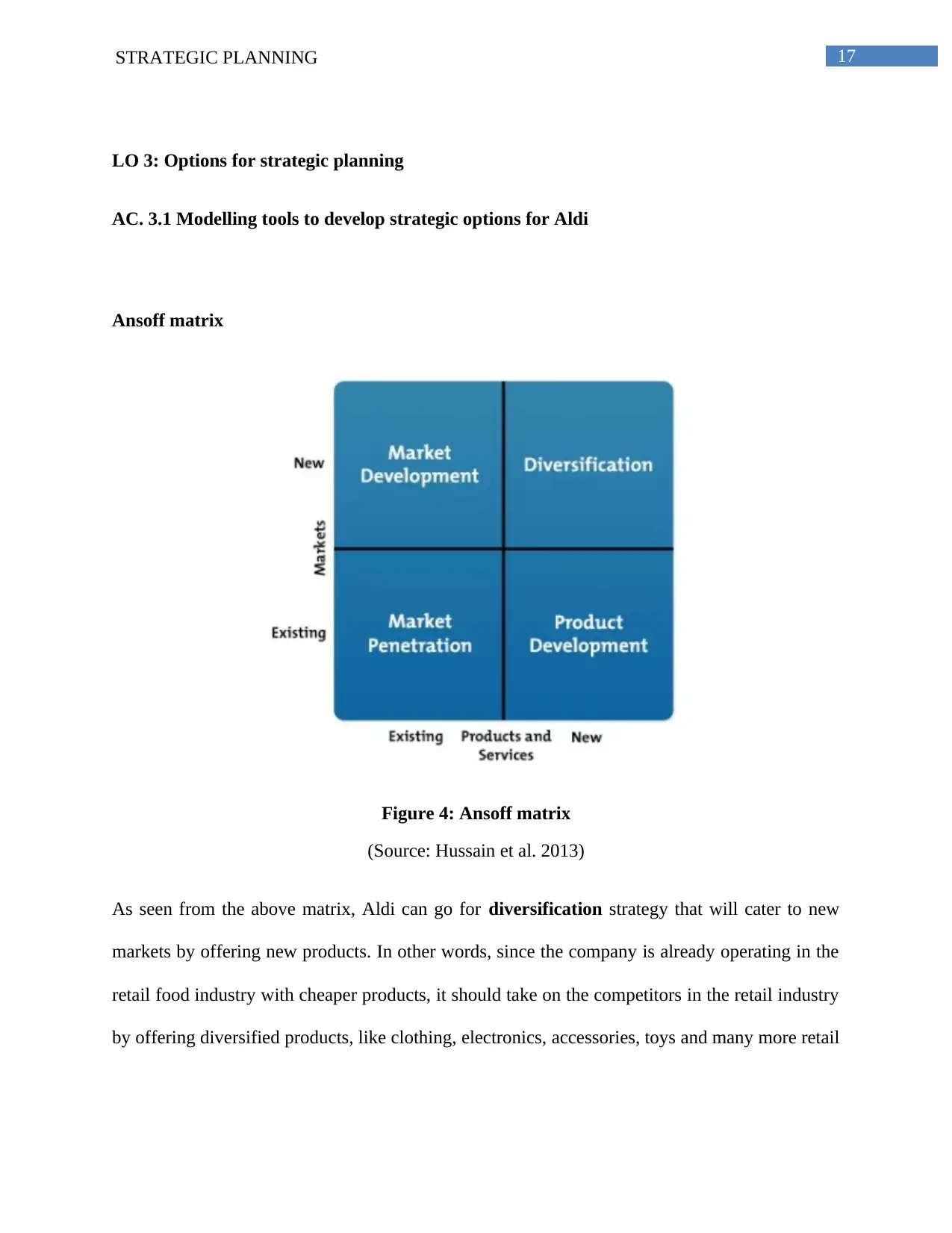
17STRATEGIC PLANNING
LO 3: Options for strategic planning
AC. 3.1 Modelling tools to develop strategic options for Aldi
Ansoff matrix
Figure 4: Ansoff matrix
(Source: Hussain et al. 2013)
As seen from the above matrix, Aldi can go for diversification strategy that will cater to new
markets by offering new products. In other words, since the company is already operating in the
retail food industry with cheaper products, it should take on the competitors in the retail industry
by offering diversified products, like clothing, electronics, accessories, toys and many more retail
LO 3: Options for strategic planning
AC. 3.1 Modelling tools to develop strategic options for Aldi
Ansoff matrix
Figure 4: Ansoff matrix
(Source: Hussain et al. 2013)
As seen from the above matrix, Aldi can go for diversification strategy that will cater to new
markets by offering new products. In other words, since the company is already operating in the
retail food industry with cheaper products, it should take on the competitors in the retail industry
by offering diversified products, like clothing, electronics, accessories, toys and many more retail
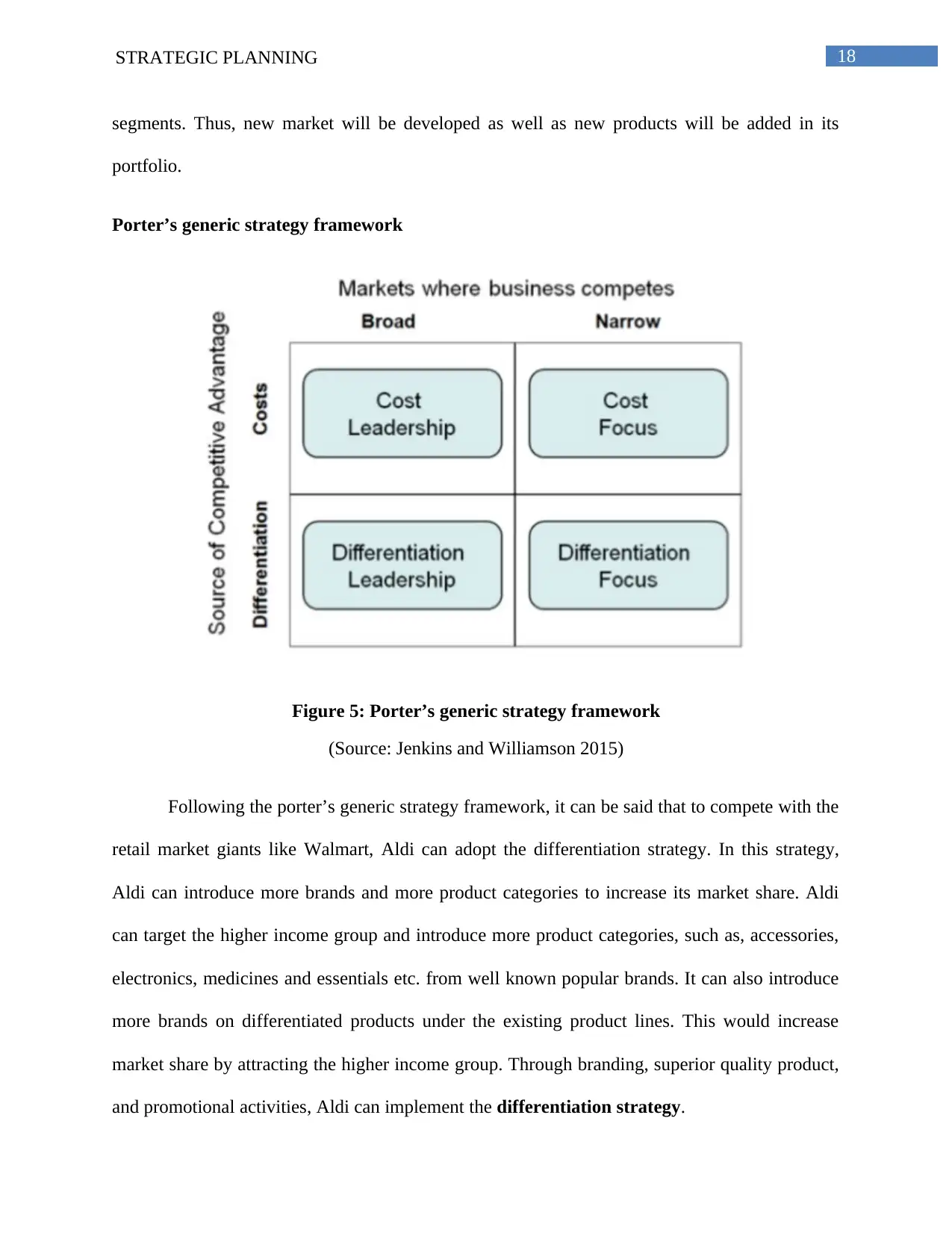
18STRATEGIC PLANNING
segments. Thus, new market will be developed as well as new products will be added in its
portfolio.
Porter’s generic strategy framework
Figure 5: Porter’s generic strategy framework
(Source: Jenkins and Williamson 2015)
Following the porter’s generic strategy framework, it can be said that to compete with the
retail market giants like Walmart, Aldi can adopt the differentiation strategy. In this strategy,
Aldi can introduce more brands and more product categories to increase its market share. Aldi
can target the higher income group and introduce more product categories, such as, accessories,
electronics, medicines and essentials etc. from well known popular brands. It can also introduce
more brands on differentiated products under the existing product lines. This would increase
market share by attracting the higher income group. Through branding, superior quality product,
and promotional activities, Aldi can implement the differentiation strategy.
segments. Thus, new market will be developed as well as new products will be added in its
portfolio.
Porter’s generic strategy framework
Figure 5: Porter’s generic strategy framework
(Source: Jenkins and Williamson 2015)
Following the porter’s generic strategy framework, it can be said that to compete with the
retail market giants like Walmart, Aldi can adopt the differentiation strategy. In this strategy,
Aldi can introduce more brands and more product categories to increase its market share. Aldi
can target the higher income group and introduce more product categories, such as, accessories,
electronics, medicines and essentials etc. from well known popular brands. It can also introduce
more brands on differentiated products under the existing product lines. This would increase
market share by attracting the higher income group. Through branding, superior quality product,
and promotional activities, Aldi can implement the differentiation strategy.
Paraphrase This Document
Need a fresh take? Get an instant paraphrase of this document with our AI Paraphraser
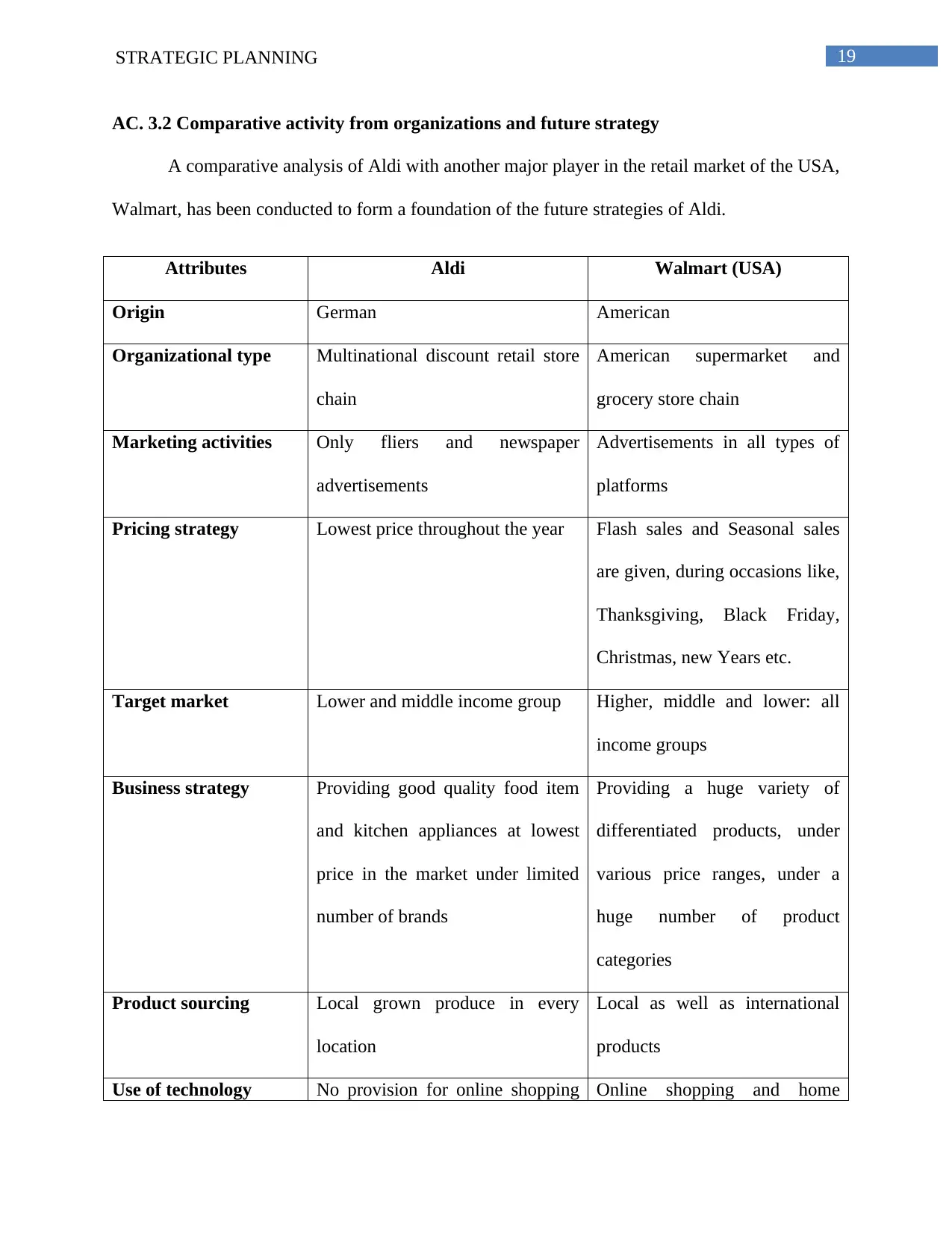
19STRATEGIC PLANNING
AC. 3.2 Comparative activity from organizations and future strategy
A comparative analysis of Aldi with another major player in the retail market of the USA,
Walmart, has been conducted to form a foundation of the future strategies of Aldi.
Attributes Aldi Walmart (USA)
Origin German American
Organizational type Multinational discount retail store
chain
American supermarket and
grocery store chain
Marketing activities Only fliers and newspaper
advertisements
Advertisements in all types of
platforms
Pricing strategy Lowest price throughout the year Flash sales and Seasonal sales
are given, during occasions like,
Thanksgiving, Black Friday,
Christmas, new Years etc.
Target market Lower and middle income group Higher, middle and lower: all
income groups
Business strategy Providing good quality food item
and kitchen appliances at lowest
price in the market under limited
number of brands
Providing a huge variety of
differentiated products, under
various price ranges, under a
huge number of product
categories
Product sourcing Local grown produce in every
location
Local as well as international
products
Use of technology No provision for online shopping Online shopping and home
AC. 3.2 Comparative activity from organizations and future strategy
A comparative analysis of Aldi with another major player in the retail market of the USA,
Walmart, has been conducted to form a foundation of the future strategies of Aldi.
Attributes Aldi Walmart (USA)
Origin German American
Organizational type Multinational discount retail store
chain
American supermarket and
grocery store chain
Marketing activities Only fliers and newspaper
advertisements
Advertisements in all types of
platforms
Pricing strategy Lowest price throughout the year Flash sales and Seasonal sales
are given, during occasions like,
Thanksgiving, Black Friday,
Christmas, new Years etc.
Target market Lower and middle income group Higher, middle and lower: all
income groups
Business strategy Providing good quality food item
and kitchen appliances at lowest
price in the market under limited
number of brands
Providing a huge variety of
differentiated products, under
various price ranges, under a
huge number of product
categories
Product sourcing Local grown produce in every
location
Local as well as international
products
Use of technology No provision for online shopping Online shopping and home
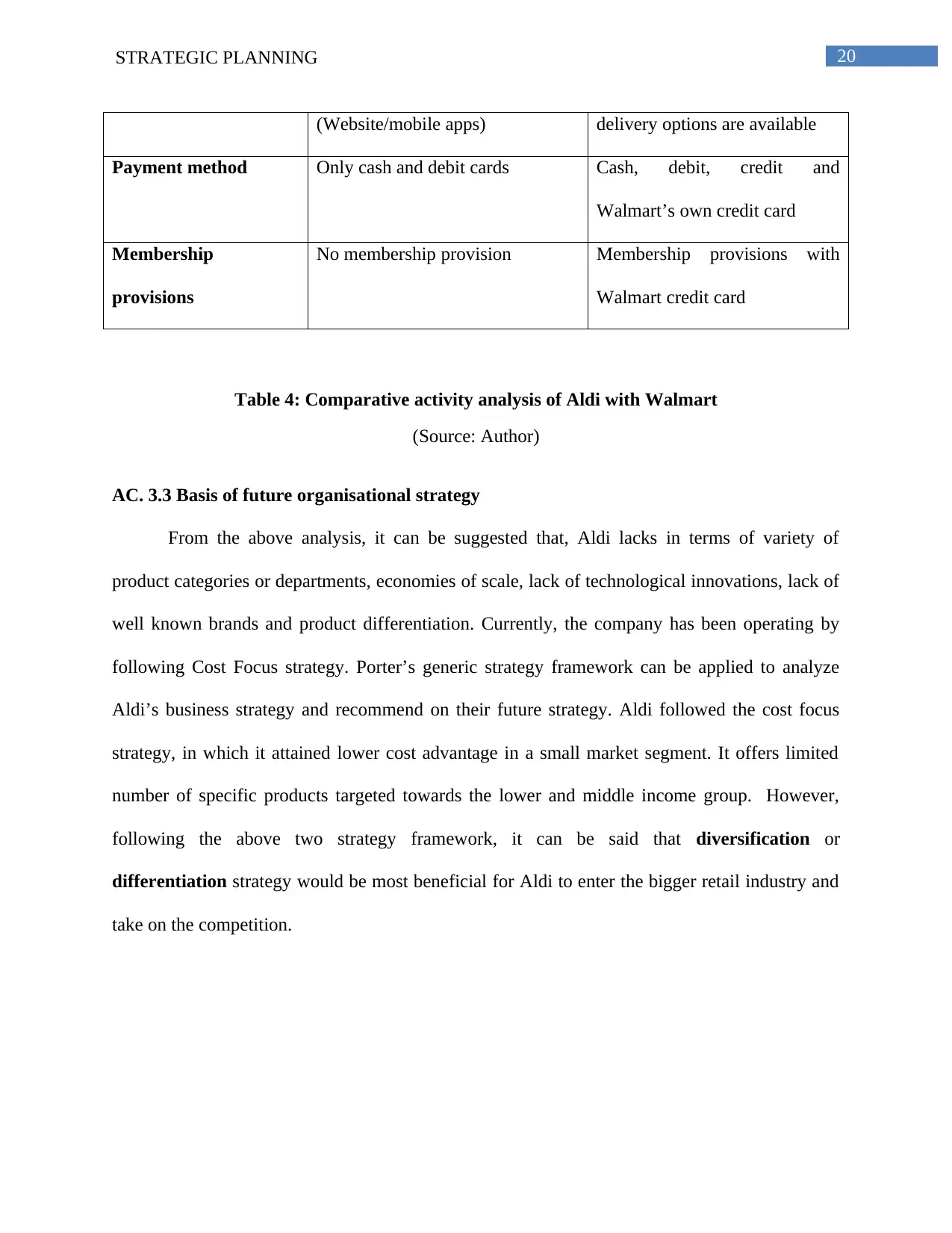
20STRATEGIC PLANNING
(Website/mobile apps) delivery options are available
Payment method Only cash and debit cards Cash, debit, credit and
Walmart’s own credit card
Membership
provisions
No membership provision Membership provisions with
Walmart credit card
Table 4: Comparative activity analysis of Aldi with Walmart
(Source: Author)
AC. 3.3 Basis of future organisational strategy
From the above analysis, it can be suggested that, Aldi lacks in terms of variety of
product categories or departments, economies of scale, lack of technological innovations, lack of
well known brands and product differentiation. Currently, the company has been operating by
following Cost Focus strategy. Porter’s generic strategy framework can be applied to analyze
Aldi’s business strategy and recommend on their future strategy. Aldi followed the cost focus
strategy, in which it attained lower cost advantage in a small market segment. It offers limited
number of specific products targeted towards the lower and middle income group. However,
following the above two strategy framework, it can be said that diversification or
differentiation strategy would be most beneficial for Aldi to enter the bigger retail industry and
take on the competition.
(Website/mobile apps) delivery options are available
Payment method Only cash and debit cards Cash, debit, credit and
Walmart’s own credit card
Membership
provisions
No membership provision Membership provisions with
Walmart credit card
Table 4: Comparative activity analysis of Aldi with Walmart
(Source: Author)
AC. 3.3 Basis of future organisational strategy
From the above analysis, it can be suggested that, Aldi lacks in terms of variety of
product categories or departments, economies of scale, lack of technological innovations, lack of
well known brands and product differentiation. Currently, the company has been operating by
following Cost Focus strategy. Porter’s generic strategy framework can be applied to analyze
Aldi’s business strategy and recommend on their future strategy. Aldi followed the cost focus
strategy, in which it attained lower cost advantage in a small market segment. It offers limited
number of specific products targeted towards the lower and middle income group. However,
following the above two strategy framework, it can be said that diversification or
differentiation strategy would be most beneficial for Aldi to enter the bigger retail industry and
take on the competition.
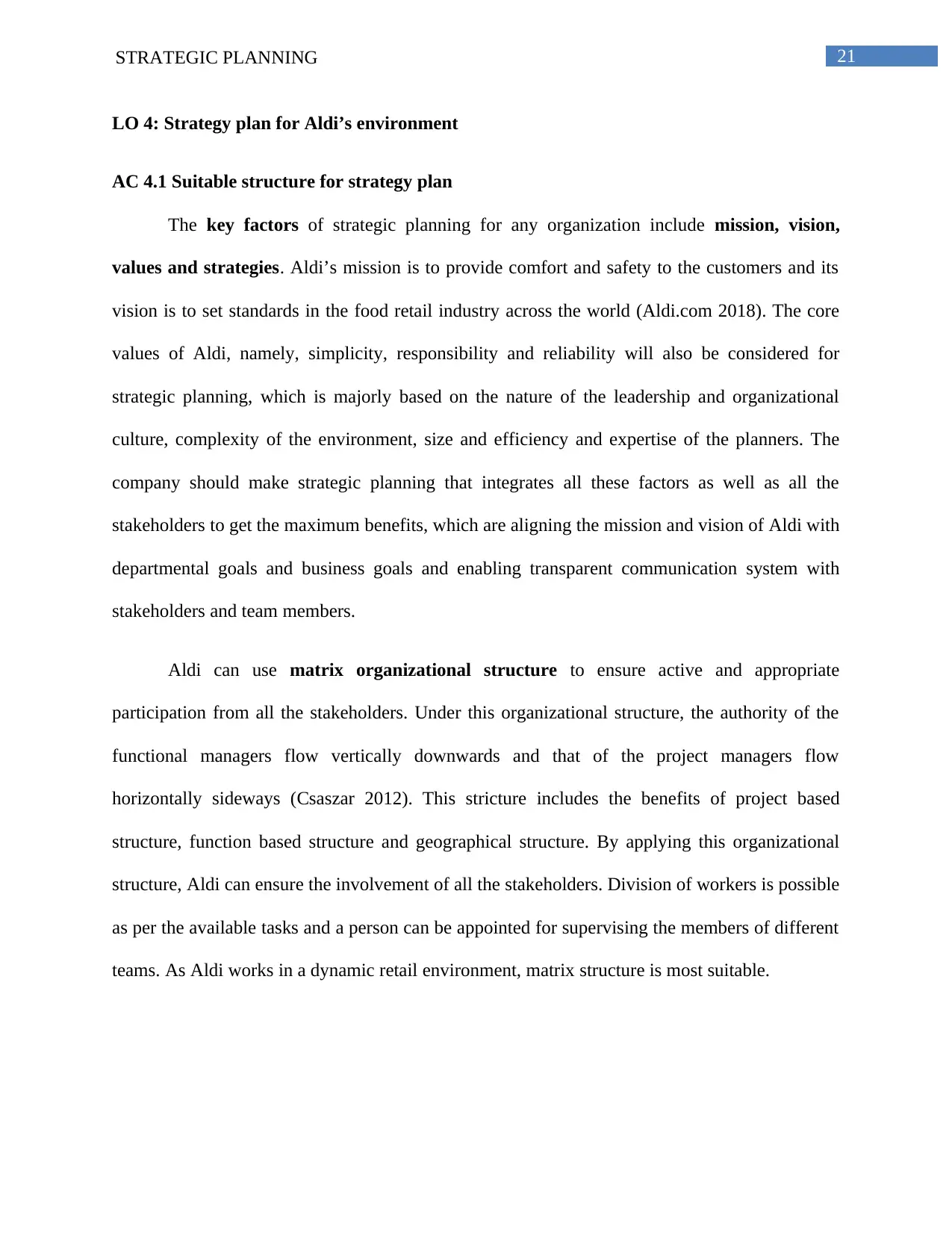
21STRATEGIC PLANNING
LO 4: Strategy plan for Aldi’s environment
AC 4.1 Suitable structure for strategy plan
The key factors of strategic planning for any organization include mission, vision,
values and strategies. Aldi’s mission is to provide comfort and safety to the customers and its
vision is to set standards in the food retail industry across the world (Aldi.com 2018). The core
values of Aldi, namely, simplicity, responsibility and reliability will also be considered for
strategic planning, which is majorly based on the nature of the leadership and organizational
culture, complexity of the environment, size and efficiency and expertise of the planners. The
company should make strategic planning that integrates all these factors as well as all the
stakeholders to get the maximum benefits, which are aligning the mission and vision of Aldi with
departmental goals and business goals and enabling transparent communication system with
stakeholders and team members.
Aldi can use matrix organizational structure to ensure active and appropriate
participation from all the stakeholders. Under this organizational structure, the authority of the
functional managers flow vertically downwards and that of the project managers flow
horizontally sideways (Csaszar 2012). This stricture includes the benefits of project based
structure, function based structure and geographical structure. By applying this organizational
structure, Aldi can ensure the involvement of all the stakeholders. Division of workers is possible
as per the available tasks and a person can be appointed for supervising the members of different
teams. As Aldi works in a dynamic retail environment, matrix structure is most suitable.
LO 4: Strategy plan for Aldi’s environment
AC 4.1 Suitable structure for strategy plan
The key factors of strategic planning for any organization include mission, vision,
values and strategies. Aldi’s mission is to provide comfort and safety to the customers and its
vision is to set standards in the food retail industry across the world (Aldi.com 2018). The core
values of Aldi, namely, simplicity, responsibility and reliability will also be considered for
strategic planning, which is majorly based on the nature of the leadership and organizational
culture, complexity of the environment, size and efficiency and expertise of the planners. The
company should make strategic planning that integrates all these factors as well as all the
stakeholders to get the maximum benefits, which are aligning the mission and vision of Aldi with
departmental goals and business goals and enabling transparent communication system with
stakeholders and team members.
Aldi can use matrix organizational structure to ensure active and appropriate
participation from all the stakeholders. Under this organizational structure, the authority of the
functional managers flow vertically downwards and that of the project managers flow
horizontally sideways (Csaszar 2012). This stricture includes the benefits of project based
structure, function based structure and geographical structure. By applying this organizational
structure, Aldi can ensure the involvement of all the stakeholders. Division of workers is possible
as per the available tasks and a person can be appointed for supervising the members of different
teams. As Aldi works in a dynamic retail environment, matrix structure is most suitable.
Secure Best Marks with AI Grader
Need help grading? Try our AI Grader for instant feedback on your assignments.
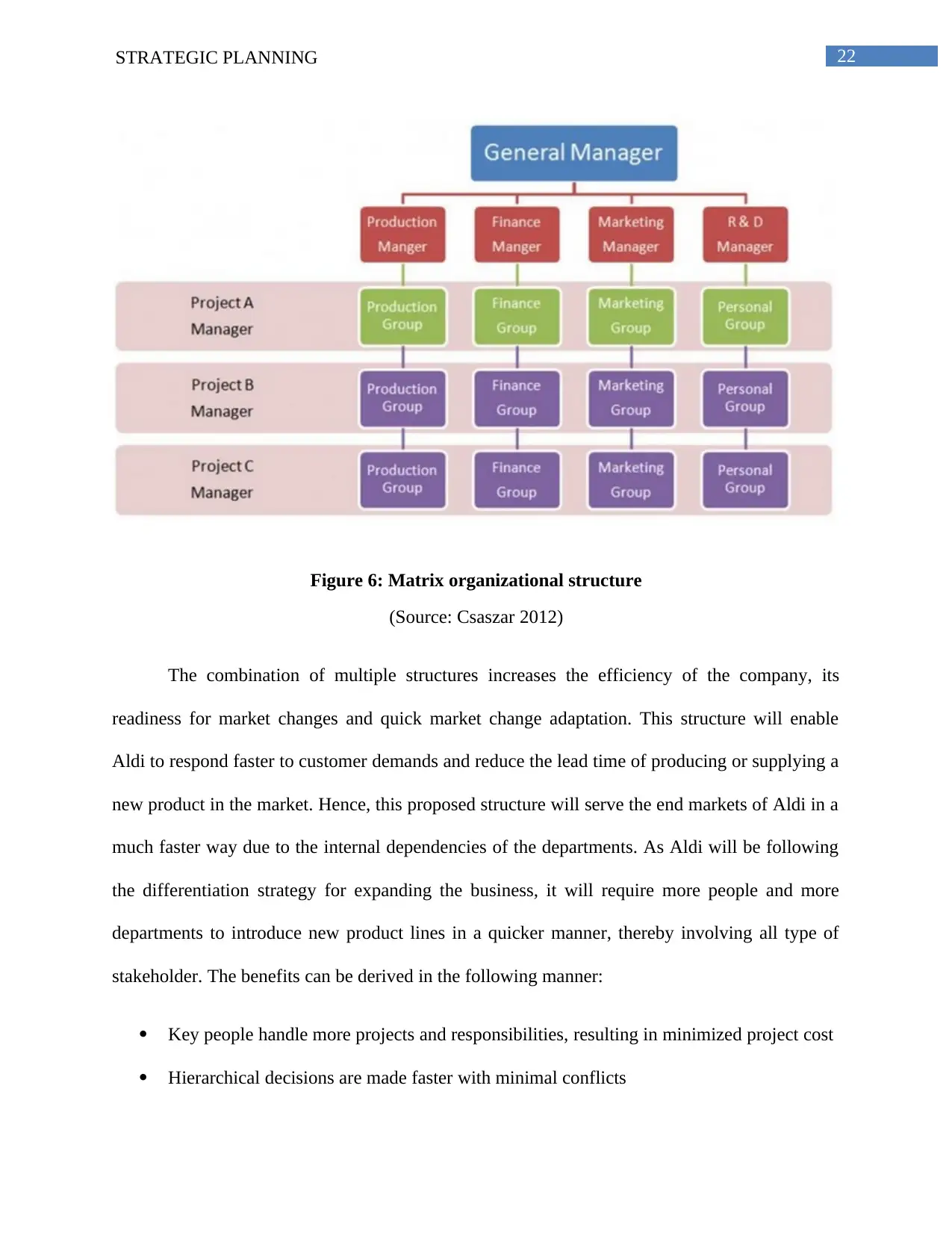
22STRATEGIC PLANNING
Figure 6: Matrix organizational structure
(Source: Csaszar 2012)
The combination of multiple structures increases the efficiency of the company, its
readiness for market changes and quick market change adaptation. This structure will enable
Aldi to respond faster to customer demands and reduce the lead time of producing or supplying a
new product in the market. Hence, this proposed structure will serve the end markets of Aldi in a
much faster way due to the internal dependencies of the departments. As Aldi will be following
the differentiation strategy for expanding the business, it will require more people and more
departments to introduce new product lines in a quicker manner, thereby involving all type of
stakeholder. The benefits can be derived in the following manner:
Key people handle more projects and responsibilities, resulting in minimized project cost
Hierarchical decisions are made faster with minimal conflicts
Figure 6: Matrix organizational structure
(Source: Csaszar 2012)
The combination of multiple structures increases the efficiency of the company, its
readiness for market changes and quick market change adaptation. This structure will enable
Aldi to respond faster to customer demands and reduce the lead time of producing or supplying a
new product in the market. Hence, this proposed structure will serve the end markets of Aldi in a
much faster way due to the internal dependencies of the departments. As Aldi will be following
the differentiation strategy for expanding the business, it will require more people and more
departments to introduce new product lines in a quicker manner, thereby involving all type of
stakeholder. The benefits can be derived in the following manner:
Key people handle more projects and responsibilities, resulting in minimized project cost
Hierarchical decisions are made faster with minimal conflicts
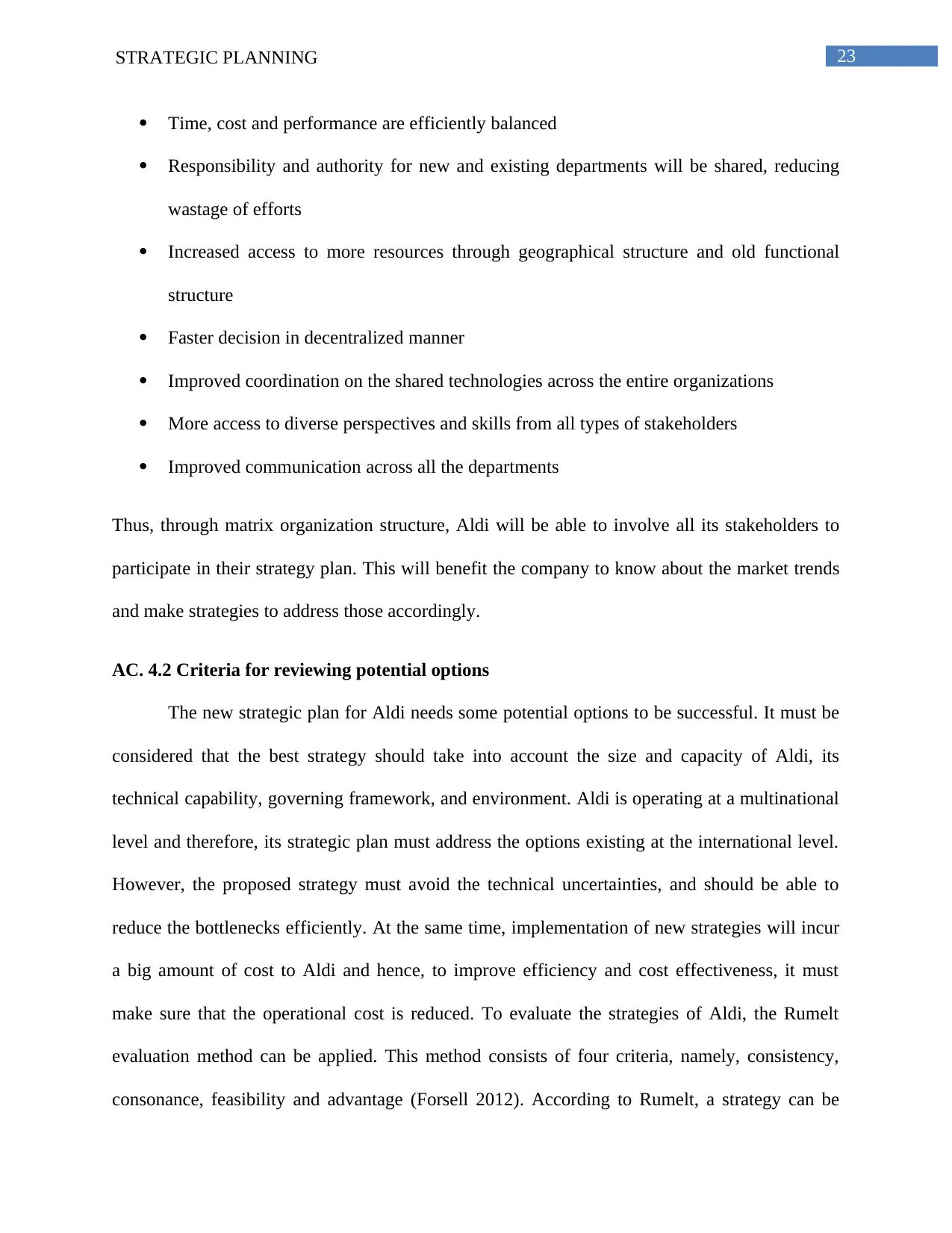
23STRATEGIC PLANNING
Time, cost and performance are efficiently balanced
Responsibility and authority for new and existing departments will be shared, reducing
wastage of efforts
Increased access to more resources through geographical structure and old functional
structure
Faster decision in decentralized manner
Improved coordination on the shared technologies across the entire organizations
More access to diverse perspectives and skills from all types of stakeholders
Improved communication across all the departments
Thus, through matrix organization structure, Aldi will be able to involve all its stakeholders to
participate in their strategy plan. This will benefit the company to know about the market trends
and make strategies to address those accordingly.
AC. 4.2 Criteria for reviewing potential options
The new strategic plan for Aldi needs some potential options to be successful. It must be
considered that the best strategy should take into account the size and capacity of Aldi, its
technical capability, governing framework, and environment. Aldi is operating at a multinational
level and therefore, its strategic plan must address the options existing at the international level.
However, the proposed strategy must avoid the technical uncertainties, and should be able to
reduce the bottlenecks efficiently. At the same time, implementation of new strategies will incur
a big amount of cost to Aldi and hence, to improve efficiency and cost effectiveness, it must
make sure that the operational cost is reduced. To evaluate the strategies of Aldi, the Rumelt
evaluation method can be applied. This method consists of four criteria, namely, consistency,
consonance, feasibility and advantage (Forsell 2012). According to Rumelt, a strategy can be
Time, cost and performance are efficiently balanced
Responsibility and authority for new and existing departments will be shared, reducing
wastage of efforts
Increased access to more resources through geographical structure and old functional
structure
Faster decision in decentralized manner
Improved coordination on the shared technologies across the entire organizations
More access to diverse perspectives and skills from all types of stakeholders
Improved communication across all the departments
Thus, through matrix organization structure, Aldi will be able to involve all its stakeholders to
participate in their strategy plan. This will benefit the company to know about the market trends
and make strategies to address those accordingly.
AC. 4.2 Criteria for reviewing potential options
The new strategic plan for Aldi needs some potential options to be successful. It must be
considered that the best strategy should take into account the size and capacity of Aldi, its
technical capability, governing framework, and environment. Aldi is operating at a multinational
level and therefore, its strategic plan must address the options existing at the international level.
However, the proposed strategy must avoid the technical uncertainties, and should be able to
reduce the bottlenecks efficiently. At the same time, implementation of new strategies will incur
a big amount of cost to Aldi and hence, to improve efficiency and cost effectiveness, it must
make sure that the operational cost is reduced. To evaluate the strategies of Aldi, the Rumelt
evaluation method can be applied. This method consists of four criteria, namely, consistency,
consonance, feasibility and advantage (Forsell 2012). According to Rumelt, a strategy can be
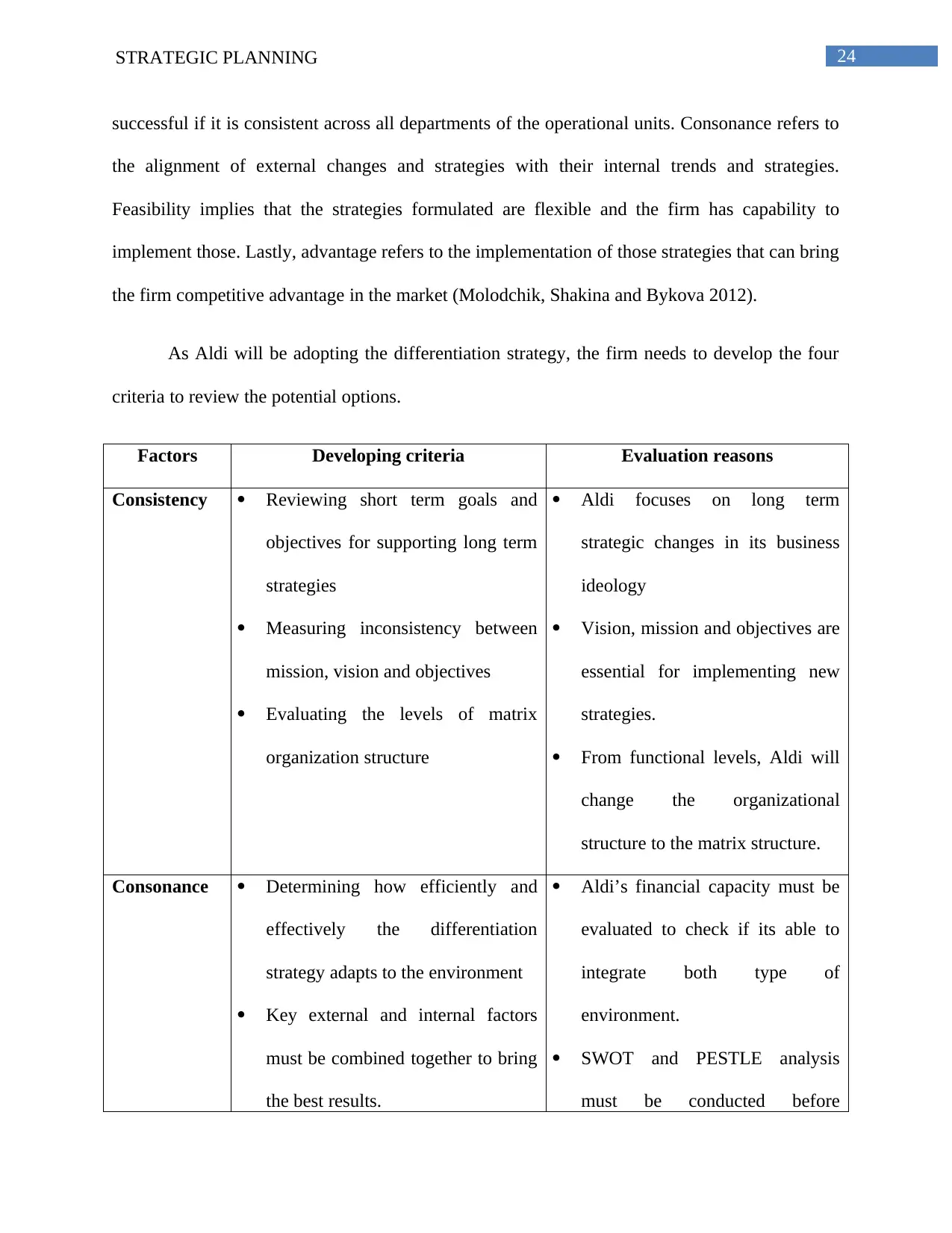
24STRATEGIC PLANNING
successful if it is consistent across all departments of the operational units. Consonance refers to
the alignment of external changes and strategies with their internal trends and strategies.
Feasibility implies that the strategies formulated are flexible and the firm has capability to
implement those. Lastly, advantage refers to the implementation of those strategies that can bring
the firm competitive advantage in the market (Molodchik, Shakina and Bykova 2012).
As Aldi will be adopting the differentiation strategy, the firm needs to develop the four
criteria to review the potential options.
Factors Developing criteria Evaluation reasons
Consistency Reviewing short term goals and
objectives for supporting long term
strategies
Measuring inconsistency between
mission, vision and objectives
Evaluating the levels of matrix
organization structure
Aldi focuses on long term
strategic changes in its business
ideology
Vision, mission and objectives are
essential for implementing new
strategies.
From functional levels, Aldi will
change the organizational
structure to the matrix structure.
Consonance Determining how efficiently and
effectively the differentiation
strategy adapts to the environment
Key external and internal factors
must be combined together to bring
the best results.
Aldi’s financial capacity must be
evaluated to check if its able to
integrate both type of
environment.
SWOT and PESTLE analysis
must be conducted before
successful if it is consistent across all departments of the operational units. Consonance refers to
the alignment of external changes and strategies with their internal trends and strategies.
Feasibility implies that the strategies formulated are flexible and the firm has capability to
implement those. Lastly, advantage refers to the implementation of those strategies that can bring
the firm competitive advantage in the market (Molodchik, Shakina and Bykova 2012).
As Aldi will be adopting the differentiation strategy, the firm needs to develop the four
criteria to review the potential options.
Factors Developing criteria Evaluation reasons
Consistency Reviewing short term goals and
objectives for supporting long term
strategies
Measuring inconsistency between
mission, vision and objectives
Evaluating the levels of matrix
organization structure
Aldi focuses on long term
strategic changes in its business
ideology
Vision, mission and objectives are
essential for implementing new
strategies.
From functional levels, Aldi will
change the organizational
structure to the matrix structure.
Consonance Determining how efficiently and
effectively the differentiation
strategy adapts to the environment
Key external and internal factors
must be combined together to bring
the best results.
Aldi’s financial capacity must be
evaluated to check if its able to
integrate both type of
environment.
SWOT and PESTLE analysis
must be conducted before
Paraphrase This Document
Need a fresh take? Get an instant paraphrase of this document with our AI Paraphraser
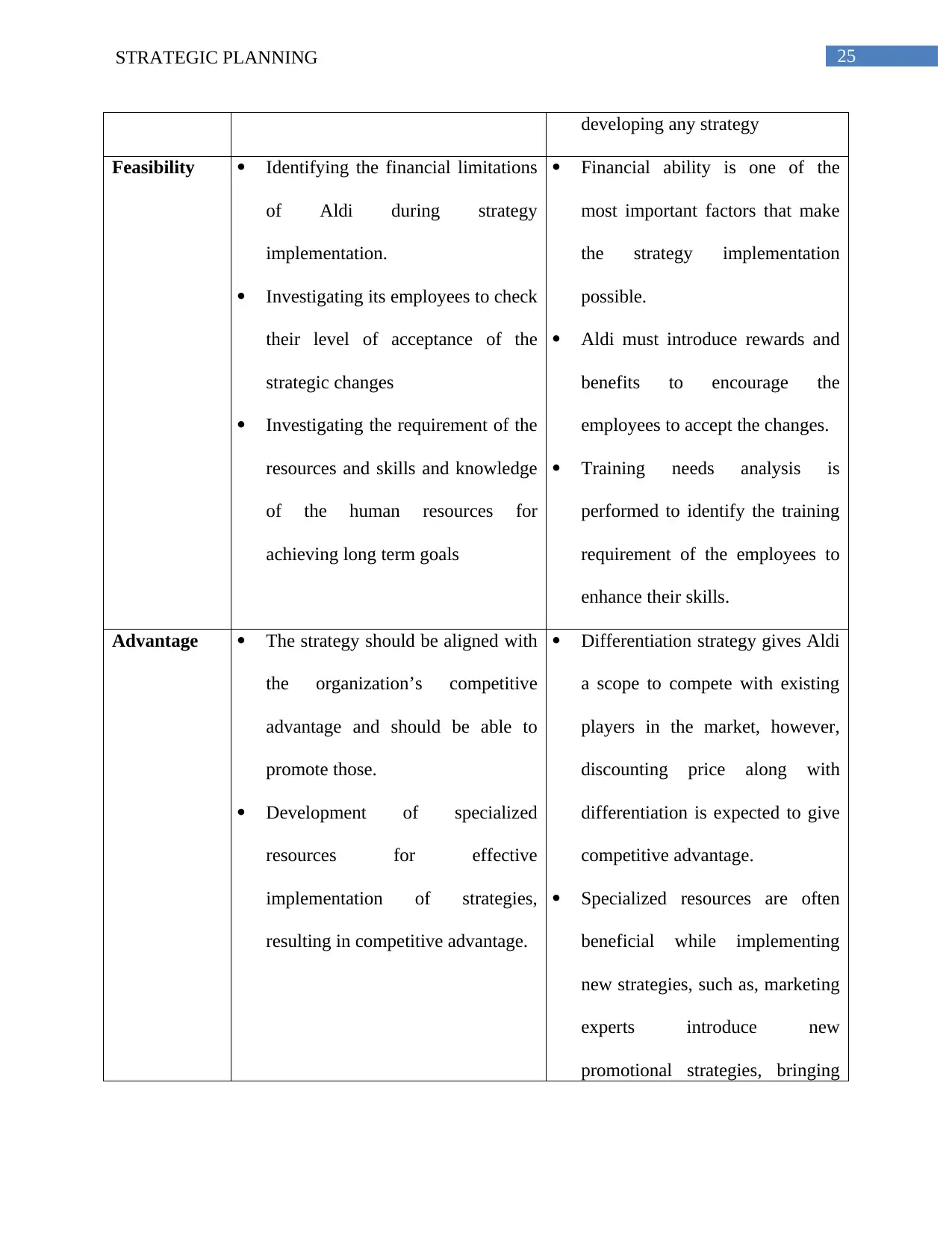
25STRATEGIC PLANNING
developing any strategy
Feasibility Identifying the financial limitations
of Aldi during strategy
implementation.
Investigating its employees to check
their level of acceptance of the
strategic changes
Investigating the requirement of the
resources and skills and knowledge
of the human resources for
achieving long term goals
Financial ability is one of the
most important factors that make
the strategy implementation
possible.
Aldi must introduce rewards and
benefits to encourage the
employees to accept the changes.
Training needs analysis is
performed to identify the training
requirement of the employees to
enhance their skills.
Advantage The strategy should be aligned with
the organization’s competitive
advantage and should be able to
promote those.
Development of specialized
resources for effective
implementation of strategies,
resulting in competitive advantage.
Differentiation strategy gives Aldi
a scope to compete with existing
players in the market, however,
discounting price along with
differentiation is expected to give
competitive advantage.
Specialized resources are often
beneficial while implementing
new strategies, such as, marketing
experts introduce new
promotional strategies, bringing
developing any strategy
Feasibility Identifying the financial limitations
of Aldi during strategy
implementation.
Investigating its employees to check
their level of acceptance of the
strategic changes
Investigating the requirement of the
resources and skills and knowledge
of the human resources for
achieving long term goals
Financial ability is one of the
most important factors that make
the strategy implementation
possible.
Aldi must introduce rewards and
benefits to encourage the
employees to accept the changes.
Training needs analysis is
performed to identify the training
requirement of the employees to
enhance their skills.
Advantage The strategy should be aligned with
the organization’s competitive
advantage and should be able to
promote those.
Development of specialized
resources for effective
implementation of strategies,
resulting in competitive advantage.
Differentiation strategy gives Aldi
a scope to compete with existing
players in the market, however,
discounting price along with
differentiation is expected to give
competitive advantage.
Specialized resources are often
beneficial while implementing
new strategies, such as, marketing
experts introduce new
promotional strategies, bringing
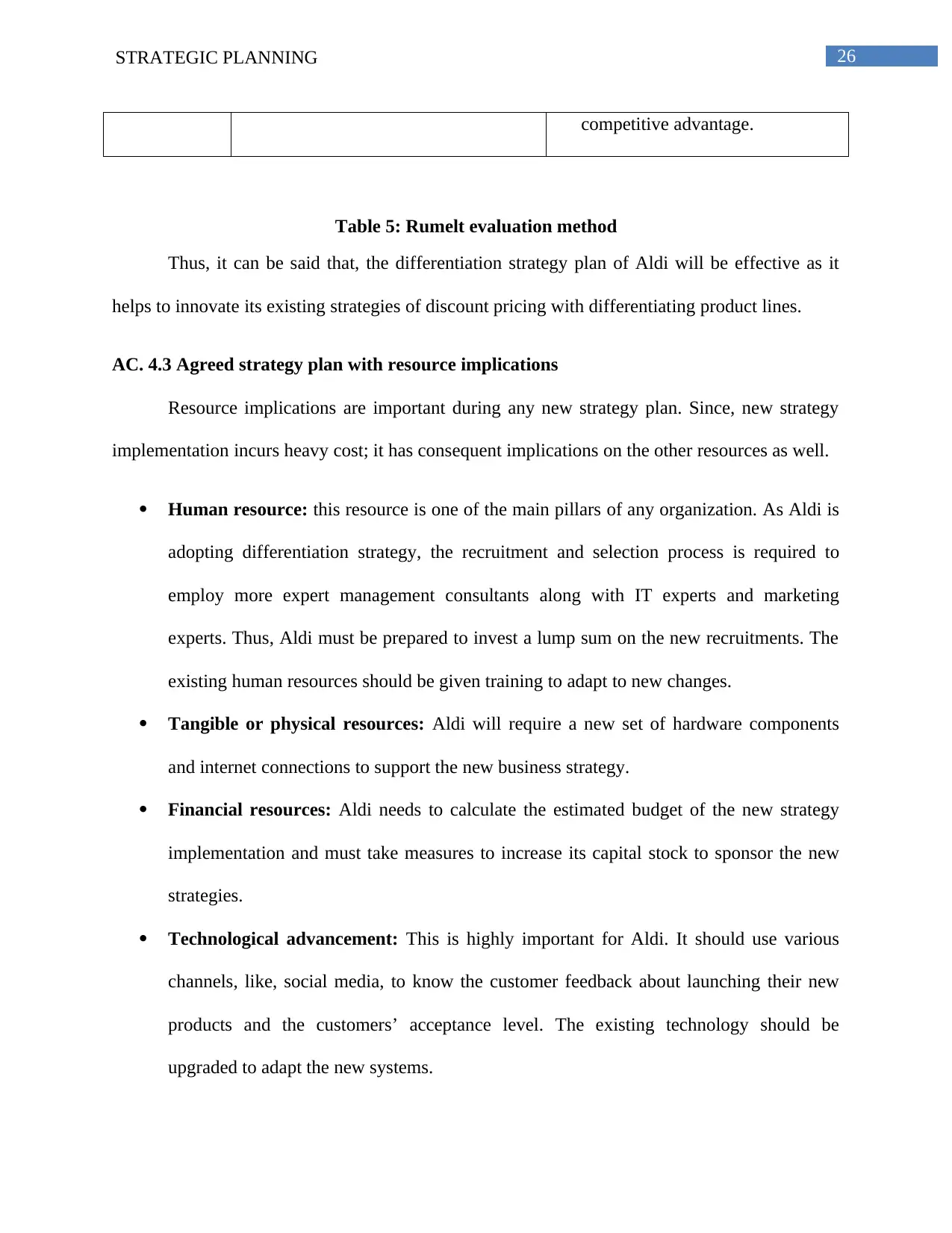
26STRATEGIC PLANNING
competitive advantage.
Table 5: Rumelt evaluation method
Thus, it can be said that, the differentiation strategy plan of Aldi will be effective as it
helps to innovate its existing strategies of discount pricing with differentiating product lines.
AC. 4.3 Agreed strategy plan with resource implications
Resource implications are important during any new strategy plan. Since, new strategy
implementation incurs heavy cost; it has consequent implications on the other resources as well.
Human resource: this resource is one of the main pillars of any organization. As Aldi is
adopting differentiation strategy, the recruitment and selection process is required to
employ more expert management consultants along with IT experts and marketing
experts. Thus, Aldi must be prepared to invest a lump sum on the new recruitments. The
existing human resources should be given training to adapt to new changes.
Tangible or physical resources: Aldi will require a new set of hardware components
and internet connections to support the new business strategy.
Financial resources: Aldi needs to calculate the estimated budget of the new strategy
implementation and must take measures to increase its capital stock to sponsor the new
strategies.
Technological advancement: This is highly important for Aldi. It should use various
channels, like, social media, to know the customer feedback about launching their new
products and the customers’ acceptance level. The existing technology should be
upgraded to adapt the new systems.
competitive advantage.
Table 5: Rumelt evaluation method
Thus, it can be said that, the differentiation strategy plan of Aldi will be effective as it
helps to innovate its existing strategies of discount pricing with differentiating product lines.
AC. 4.3 Agreed strategy plan with resource implications
Resource implications are important during any new strategy plan. Since, new strategy
implementation incurs heavy cost; it has consequent implications on the other resources as well.
Human resource: this resource is one of the main pillars of any organization. As Aldi is
adopting differentiation strategy, the recruitment and selection process is required to
employ more expert management consultants along with IT experts and marketing
experts. Thus, Aldi must be prepared to invest a lump sum on the new recruitments. The
existing human resources should be given training to adapt to new changes.
Tangible or physical resources: Aldi will require a new set of hardware components
and internet connections to support the new business strategy.
Financial resources: Aldi needs to calculate the estimated budget of the new strategy
implementation and must take measures to increase its capital stock to sponsor the new
strategies.
Technological advancement: This is highly important for Aldi. It should use various
channels, like, social media, to know the customer feedback about launching their new
products and the customers’ acceptance level. The existing technology should be
upgraded to adapt the new systems.
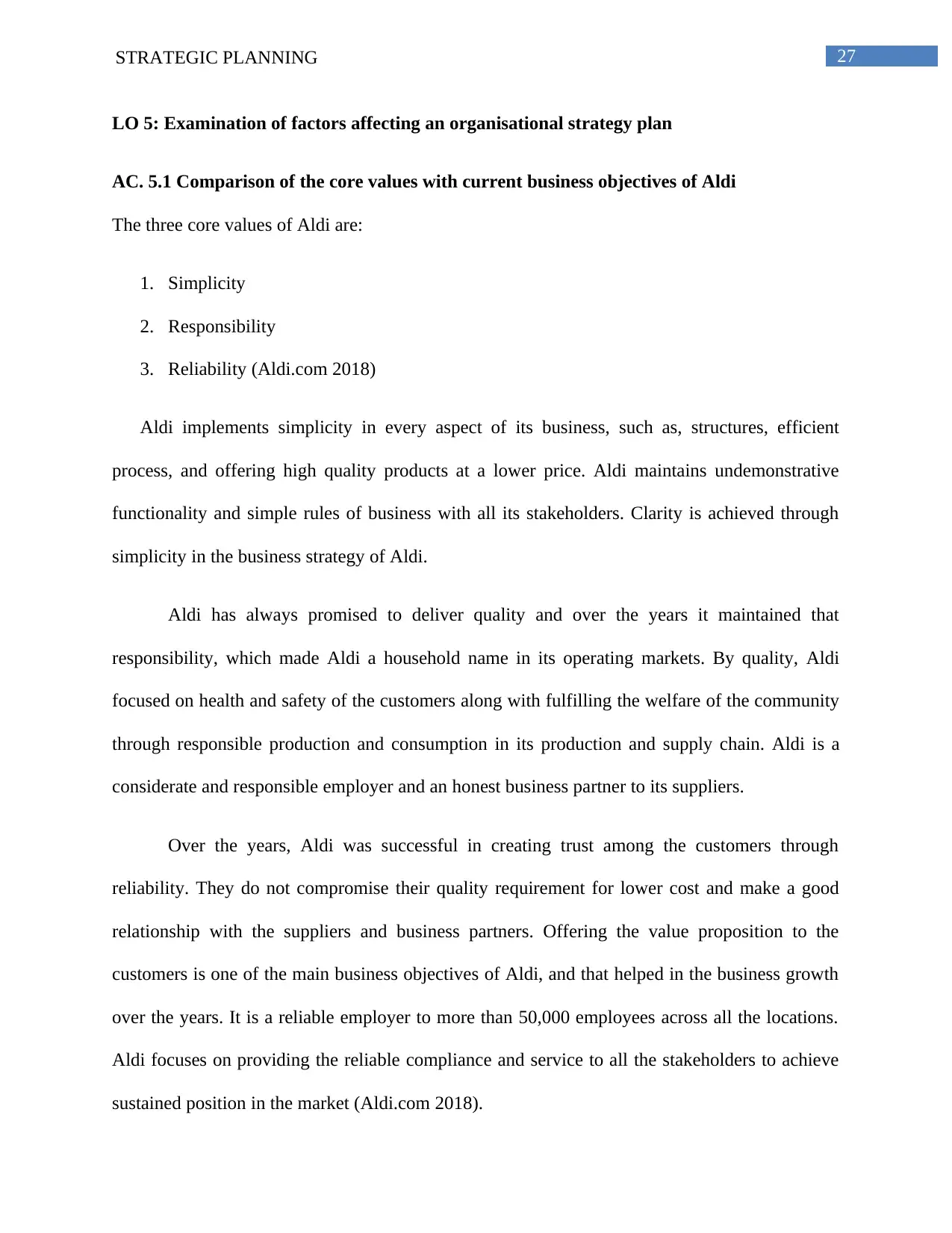
27STRATEGIC PLANNING
LO 5: Examination of factors affecting an organisational strategy plan
AC. 5.1 Comparison of the core values with current business objectives of Aldi
The three core values of Aldi are:
1. Simplicity
2. Responsibility
3. Reliability (Aldi.com 2018)
Aldi implements simplicity in every aspect of its business, such as, structures, efficient
process, and offering high quality products at a lower price. Aldi maintains undemonstrative
functionality and simple rules of business with all its stakeholders. Clarity is achieved through
simplicity in the business strategy of Aldi.
Aldi has always promised to deliver quality and over the years it maintained that
responsibility, which made Aldi a household name in its operating markets. By quality, Aldi
focused on health and safety of the customers along with fulfilling the welfare of the community
through responsible production and consumption in its production and supply chain. Aldi is a
considerate and responsible employer and an honest business partner to its suppliers.
Over the years, Aldi was successful in creating trust among the customers through
reliability. They do not compromise their quality requirement for lower cost and make a good
relationship with the suppliers and business partners. Offering the value proposition to the
customers is one of the main business objectives of Aldi, and that helped in the business growth
over the years. It is a reliable employer to more than 50,000 employees across all the locations.
Aldi focuses on providing the reliable compliance and service to all the stakeholders to achieve
sustained position in the market (Aldi.com 2018).
LO 5: Examination of factors affecting an organisational strategy plan
AC. 5.1 Comparison of the core values with current business objectives of Aldi
The three core values of Aldi are:
1. Simplicity
2. Responsibility
3. Reliability (Aldi.com 2018)
Aldi implements simplicity in every aspect of its business, such as, structures, efficient
process, and offering high quality products at a lower price. Aldi maintains undemonstrative
functionality and simple rules of business with all its stakeholders. Clarity is achieved through
simplicity in the business strategy of Aldi.
Aldi has always promised to deliver quality and over the years it maintained that
responsibility, which made Aldi a household name in its operating markets. By quality, Aldi
focused on health and safety of the customers along with fulfilling the welfare of the community
through responsible production and consumption in its production and supply chain. Aldi is a
considerate and responsible employer and an honest business partner to its suppliers.
Over the years, Aldi was successful in creating trust among the customers through
reliability. They do not compromise their quality requirement for lower cost and make a good
relationship with the suppliers and business partners. Offering the value proposition to the
customers is one of the main business objectives of Aldi, and that helped in the business growth
over the years. It is a reliable employer to more than 50,000 employees across all the locations.
Aldi focuses on providing the reliable compliance and service to all the stakeholders to achieve
sustained position in the market (Aldi.com 2018).
Secure Best Marks with AI Grader
Need help grading? Try our AI Grader for instant feedback on your assignments.
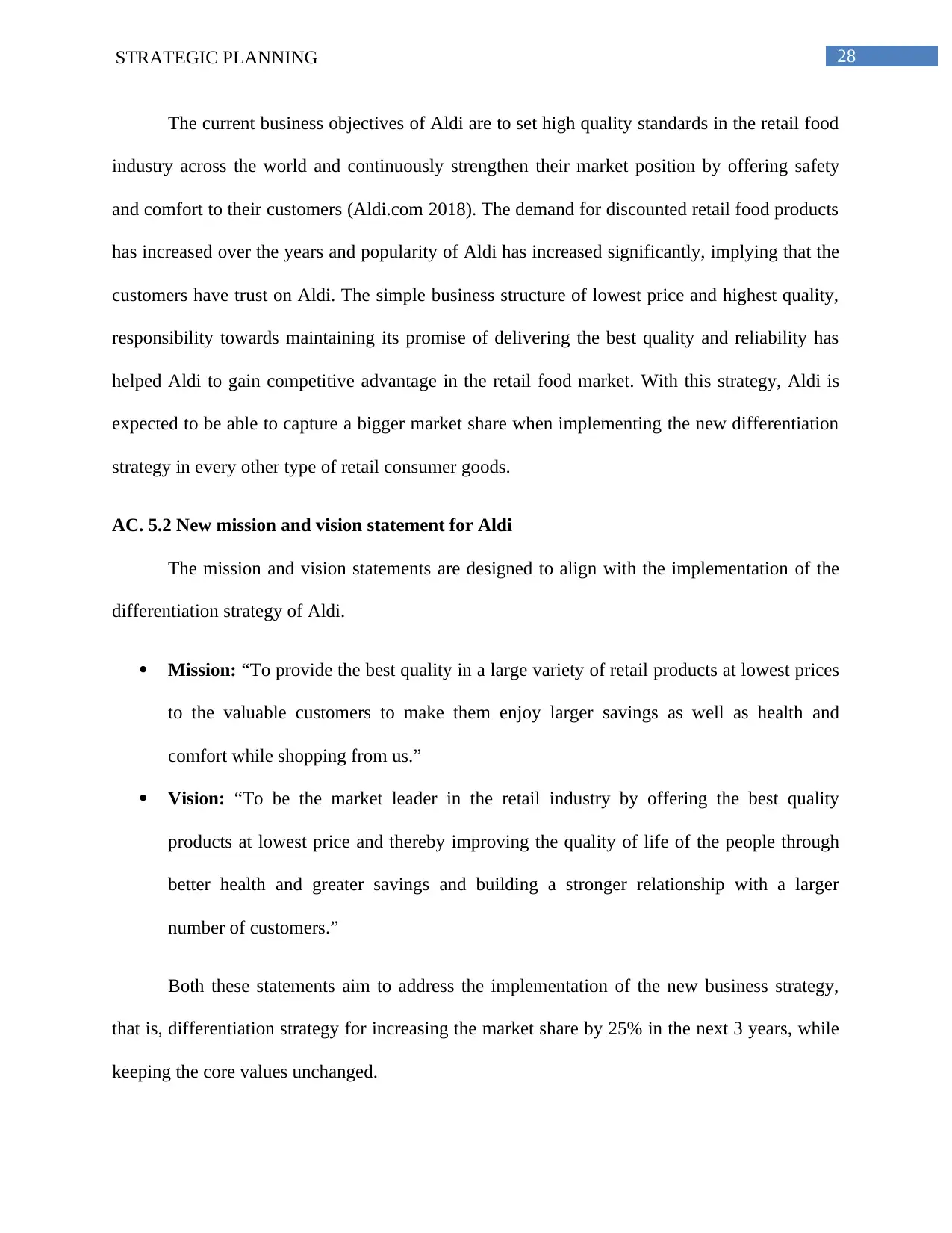
28STRATEGIC PLANNING
The current business objectives of Aldi are to set high quality standards in the retail food
industry across the world and continuously strengthen their market position by offering safety
and comfort to their customers (Aldi.com 2018). The demand for discounted retail food products
has increased over the years and popularity of Aldi has increased significantly, implying that the
customers have trust on Aldi. The simple business structure of lowest price and highest quality,
responsibility towards maintaining its promise of delivering the best quality and reliability has
helped Aldi to gain competitive advantage in the retail food market. With this strategy, Aldi is
expected to be able to capture a bigger market share when implementing the new differentiation
strategy in every other type of retail consumer goods.
AC. 5.2 New mission and vision statement for Aldi
The mission and vision statements are designed to align with the implementation of the
differentiation strategy of Aldi.
Mission: “To provide the best quality in a large variety of retail products at lowest prices
to the valuable customers to make them enjoy larger savings as well as health and
comfort while shopping from us.”
Vision: “To be the market leader in the retail industry by offering the best quality
products at lowest price and thereby improving the quality of life of the people through
better health and greater savings and building a stronger relationship with a larger
number of customers.”
Both these statements aim to address the implementation of the new business strategy,
that is, differentiation strategy for increasing the market share by 25% in the next 3 years, while
keeping the core values unchanged.
The current business objectives of Aldi are to set high quality standards in the retail food
industry across the world and continuously strengthen their market position by offering safety
and comfort to their customers (Aldi.com 2018). The demand for discounted retail food products
has increased over the years and popularity of Aldi has increased significantly, implying that the
customers have trust on Aldi. The simple business structure of lowest price and highest quality,
responsibility towards maintaining its promise of delivering the best quality and reliability has
helped Aldi to gain competitive advantage in the retail food market. With this strategy, Aldi is
expected to be able to capture a bigger market share when implementing the new differentiation
strategy in every other type of retail consumer goods.
AC. 5.2 New mission and vision statement for Aldi
The mission and vision statements are designed to align with the implementation of the
differentiation strategy of Aldi.
Mission: “To provide the best quality in a large variety of retail products at lowest prices
to the valuable customers to make them enjoy larger savings as well as health and
comfort while shopping from us.”
Vision: “To be the market leader in the retail industry by offering the best quality
products at lowest price and thereby improving the quality of life of the people through
better health and greater savings and building a stronger relationship with a larger
number of customers.”
Both these statements aim to address the implementation of the new business strategy,
that is, differentiation strategy for increasing the market share by 25% in the next 3 years, while
keeping the core values unchanged.
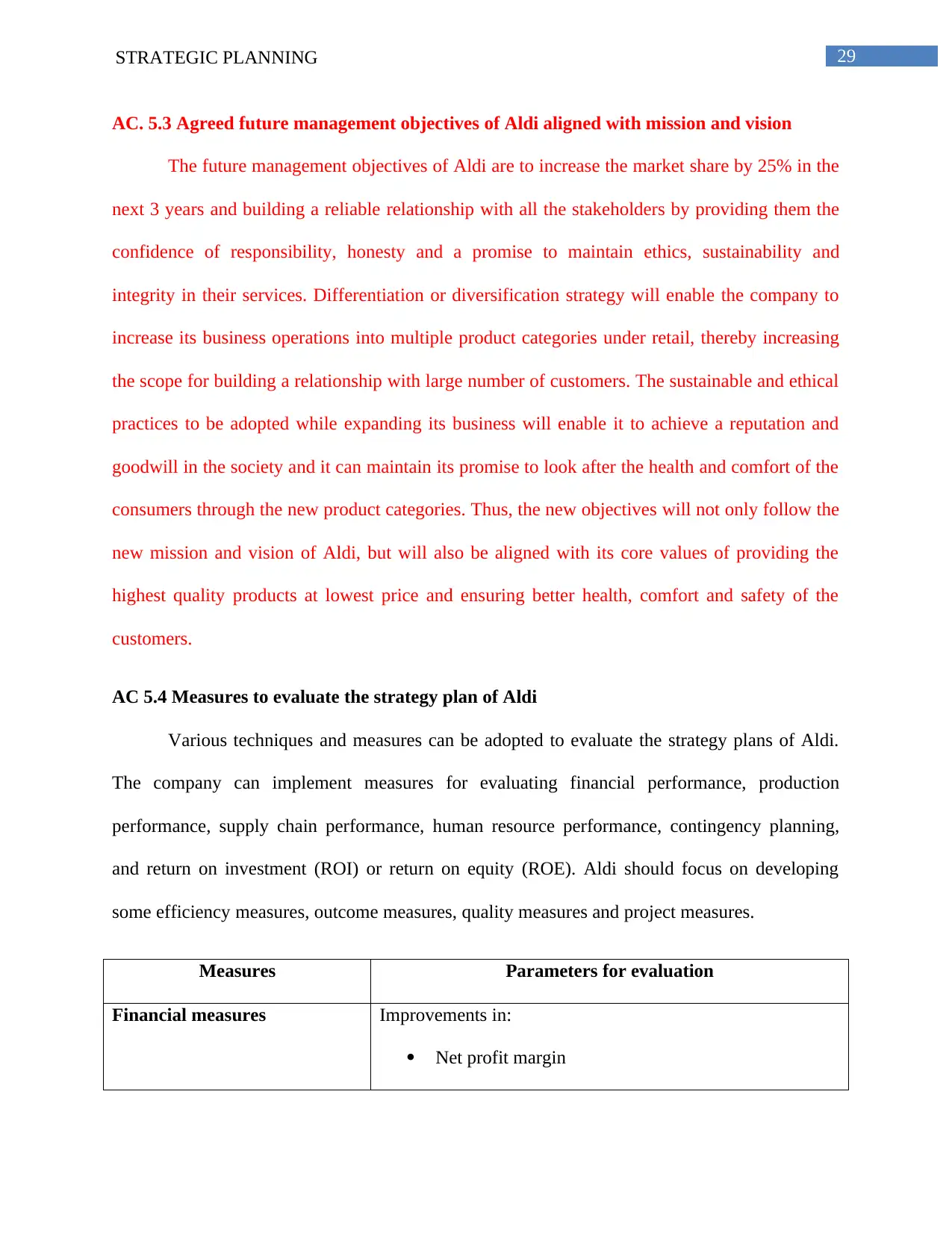
29STRATEGIC PLANNING
AC. 5.3 Agreed future management objectives of Aldi aligned with mission and vision
The future management objectives of Aldi are to increase the market share by 25% in the
next 3 years and building a reliable relationship with all the stakeholders by providing them the
confidence of responsibility, honesty and a promise to maintain ethics, sustainability and
integrity in their services. Differentiation or diversification strategy will enable the company to
increase its business operations into multiple product categories under retail, thereby increasing
the scope for building a relationship with large number of customers. The sustainable and ethical
practices to be adopted while expanding its business will enable it to achieve a reputation and
goodwill in the society and it can maintain its promise to look after the health and comfort of the
consumers through the new product categories. Thus, the new objectives will not only follow the
new mission and vision of Aldi, but will also be aligned with its core values of providing the
highest quality products at lowest price and ensuring better health, comfort and safety of the
customers.
AC 5.4 Measures to evaluate the strategy plan of Aldi
Various techniques and measures can be adopted to evaluate the strategy plans of Aldi.
The company can implement measures for evaluating financial performance, production
performance, supply chain performance, human resource performance, contingency planning,
and return on investment (ROI) or return on equity (ROE). Aldi should focus on developing
some efficiency measures, outcome measures, quality measures and project measures.
Measures Parameters for evaluation
Financial measures Improvements in:
Net profit margin
AC. 5.3 Agreed future management objectives of Aldi aligned with mission and vision
The future management objectives of Aldi are to increase the market share by 25% in the
next 3 years and building a reliable relationship with all the stakeholders by providing them the
confidence of responsibility, honesty and a promise to maintain ethics, sustainability and
integrity in their services. Differentiation or diversification strategy will enable the company to
increase its business operations into multiple product categories under retail, thereby increasing
the scope for building a relationship with large number of customers. The sustainable and ethical
practices to be adopted while expanding its business will enable it to achieve a reputation and
goodwill in the society and it can maintain its promise to look after the health and comfort of the
consumers through the new product categories. Thus, the new objectives will not only follow the
new mission and vision of Aldi, but will also be aligned with its core values of providing the
highest quality products at lowest price and ensuring better health, comfort and safety of the
customers.
AC 5.4 Measures to evaluate the strategy plan of Aldi
Various techniques and measures can be adopted to evaluate the strategy plans of Aldi.
The company can implement measures for evaluating financial performance, production
performance, supply chain performance, human resource performance, contingency planning,
and return on investment (ROI) or return on equity (ROE). Aldi should focus on developing
some efficiency measures, outcome measures, quality measures and project measures.
Measures Parameters for evaluation
Financial measures Improvements in:
Net profit margin
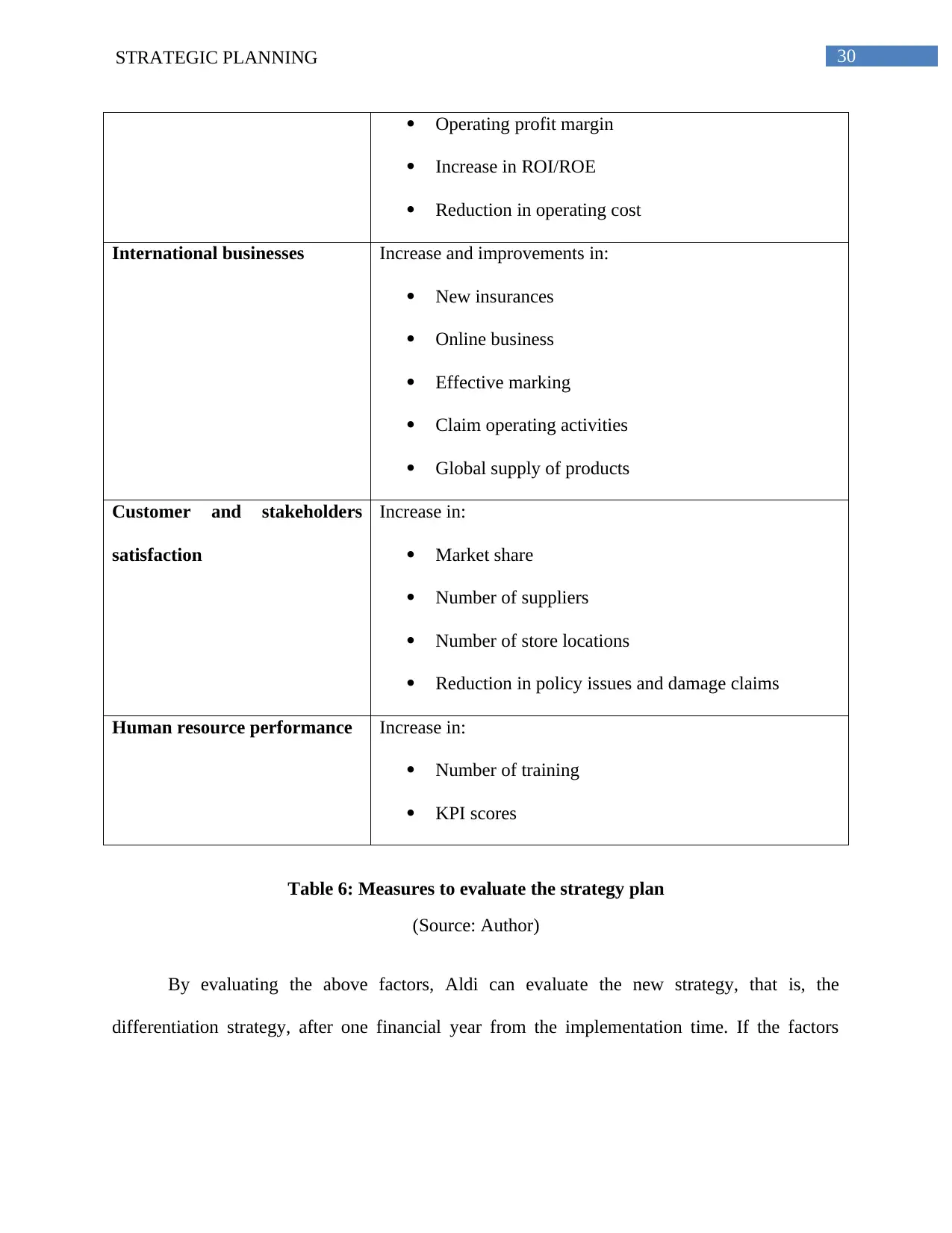
30STRATEGIC PLANNING
Operating profit margin
Increase in ROI/ROE
Reduction in operating cost
International businesses Increase and improvements in:
New insurances
Online business
Effective marking
Claim operating activities
Global supply of products
Customer and stakeholders
satisfaction
Increase in:
Market share
Number of suppliers
Number of store locations
Reduction in policy issues and damage claims
Human resource performance Increase in:
Number of training
KPI scores
Table 6: Measures to evaluate the strategy plan
(Source: Author)
By evaluating the above factors, Aldi can evaluate the new strategy, that is, the
differentiation strategy, after one financial year from the implementation time. If the factors
Operating profit margin
Increase in ROI/ROE
Reduction in operating cost
International businesses Increase and improvements in:
New insurances
Online business
Effective marking
Claim operating activities
Global supply of products
Customer and stakeholders
satisfaction
Increase in:
Market share
Number of suppliers
Number of store locations
Reduction in policy issues and damage claims
Human resource performance Increase in:
Number of training
KPI scores
Table 6: Measures to evaluate the strategy plan
(Source: Author)
By evaluating the above factors, Aldi can evaluate the new strategy, that is, the
differentiation strategy, after one financial year from the implementation time. If the factors
Paraphrase This Document
Need a fresh take? Get an instant paraphrase of this document with our AI Paraphraser
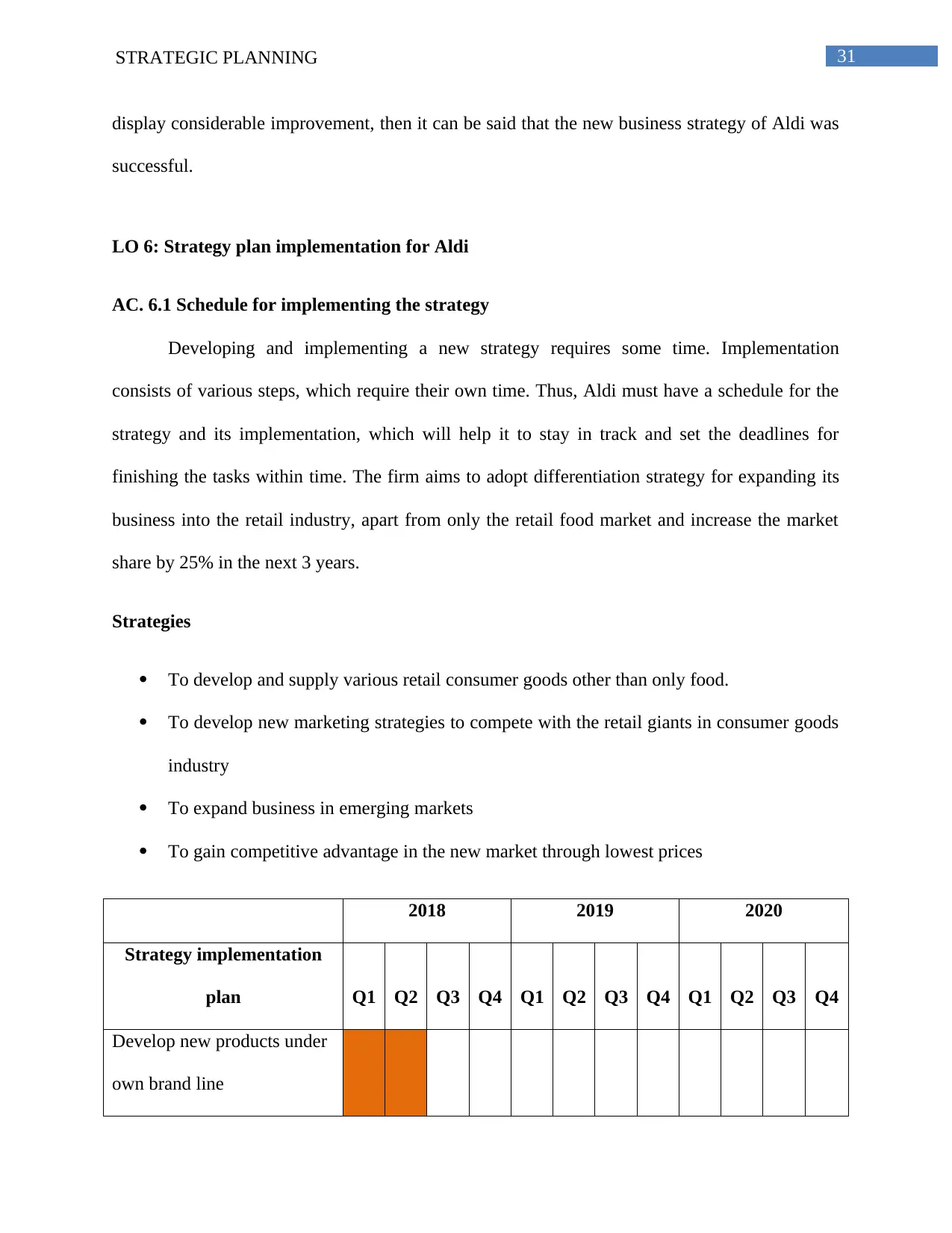
31STRATEGIC PLANNING
display considerable improvement, then it can be said that the new business strategy of Aldi was
successful.
LO 6: Strategy plan implementation for Aldi
AC. 6.1 Schedule for implementing the strategy
Developing and implementing a new strategy requires some time. Implementation
consists of various steps, which require their own time. Thus, Aldi must have a schedule for the
strategy and its implementation, which will help it to stay in track and set the deadlines for
finishing the tasks within time. The firm aims to adopt differentiation strategy for expanding its
business into the retail industry, apart from only the retail food market and increase the market
share by 25% in the next 3 years.
Strategies
To develop and supply various retail consumer goods other than only food.
To develop new marketing strategies to compete with the retail giants in consumer goods
industry
To expand business in emerging markets
To gain competitive advantage in the new market through lowest prices
2018 2019 2020
Strategy implementation
plan Q1 Q2 Q3 Q4 Q1 Q2 Q3 Q4 Q1 Q2 Q3 Q4
Develop new products under
own brand line
display considerable improvement, then it can be said that the new business strategy of Aldi was
successful.
LO 6: Strategy plan implementation for Aldi
AC. 6.1 Schedule for implementing the strategy
Developing and implementing a new strategy requires some time. Implementation
consists of various steps, which require their own time. Thus, Aldi must have a schedule for the
strategy and its implementation, which will help it to stay in track and set the deadlines for
finishing the tasks within time. The firm aims to adopt differentiation strategy for expanding its
business into the retail industry, apart from only the retail food market and increase the market
share by 25% in the next 3 years.
Strategies
To develop and supply various retail consumer goods other than only food.
To develop new marketing strategies to compete with the retail giants in consumer goods
industry
To expand business in emerging markets
To gain competitive advantage in the new market through lowest prices
2018 2019 2020
Strategy implementation
plan Q1 Q2 Q3 Q4 Q1 Q2 Q3 Q4 Q1 Q2 Q3 Q4
Develop new products under
own brand line
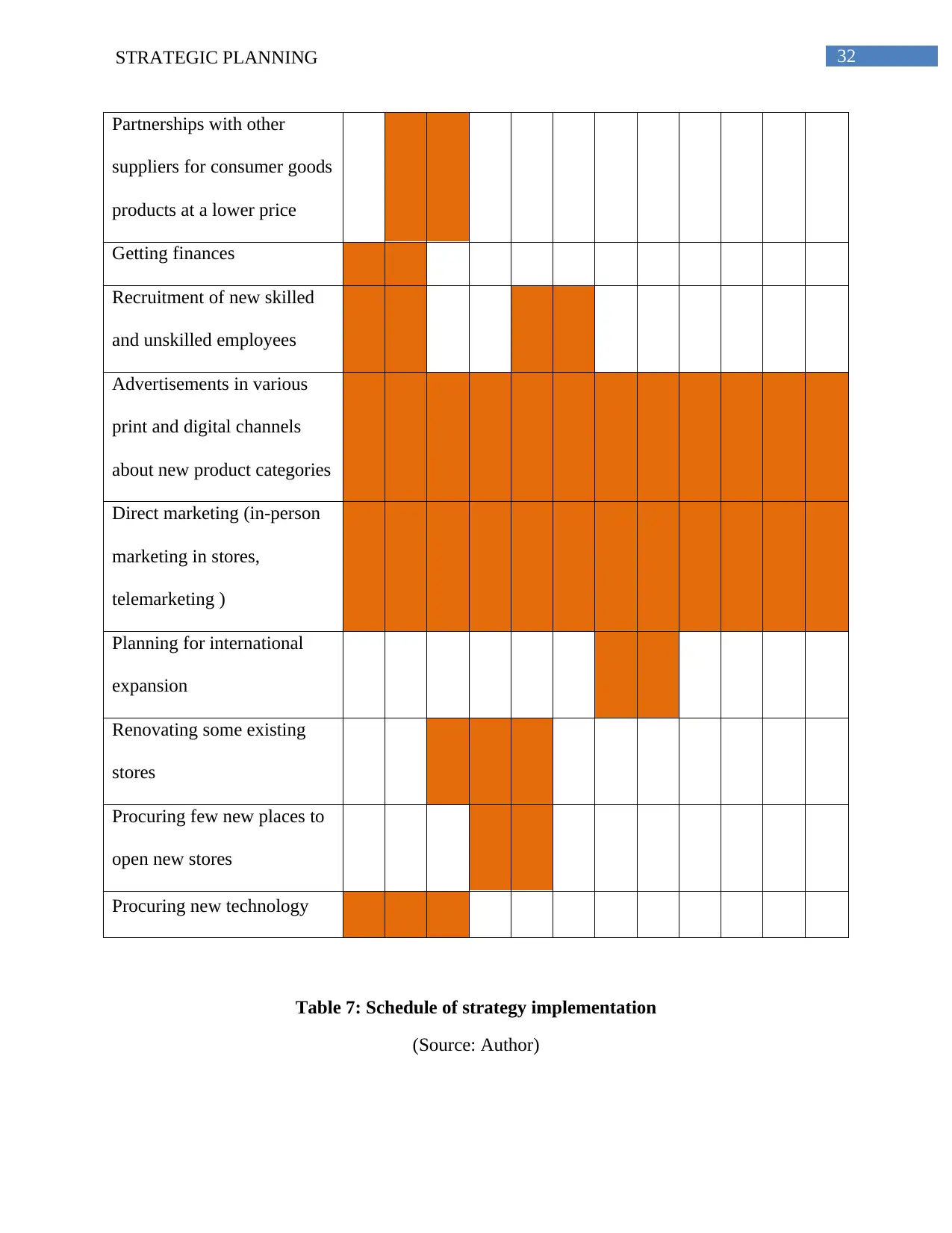
32STRATEGIC PLANNING
Partnerships with other
suppliers for consumer goods
products at a lower price
Getting finances
Recruitment of new skilled
and unskilled employees
Advertisements in various
print and digital channels
about new product categories
Direct marketing (in-person
marketing in stores,
telemarketing )
Planning for international
expansion
Renovating some existing
stores
Procuring few new places to
open new stores
Procuring new technology
Table 7: Schedule of strategy implementation
(Source: Author)
Partnerships with other
suppliers for consumer goods
products at a lower price
Getting finances
Recruitment of new skilled
and unskilled employees
Advertisements in various
print and digital channels
about new product categories
Direct marketing (in-person
marketing in stores,
telemarketing )
Planning for international
expansion
Renovating some existing
stores
Procuring few new places to
open new stores
Procuring new technology
Table 7: Schedule of strategy implementation
(Source: Author)
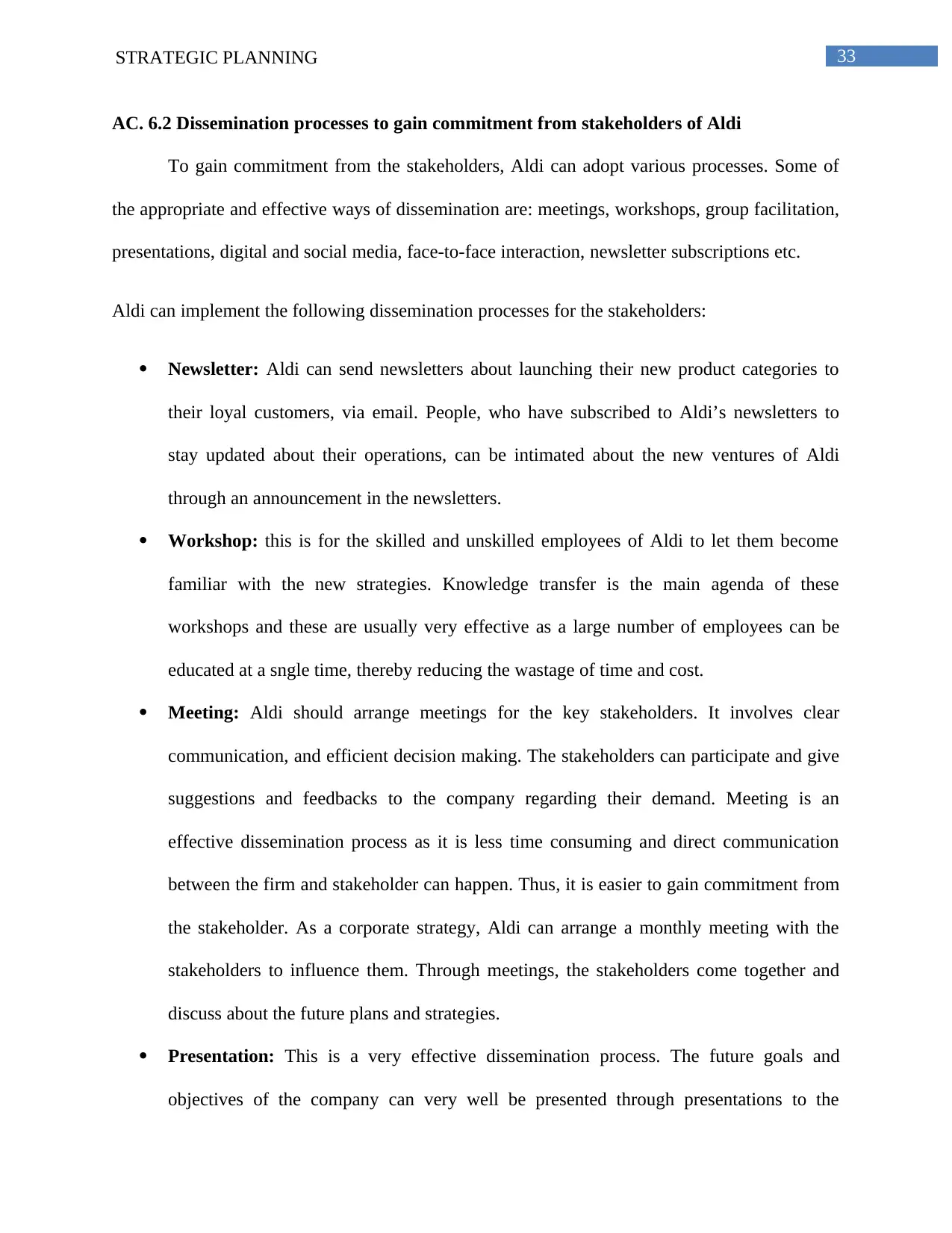
33STRATEGIC PLANNING
AC. 6.2 Dissemination processes to gain commitment from stakeholders of Aldi
To gain commitment from the stakeholders, Aldi can adopt various processes. Some of
the appropriate and effective ways of dissemination are: meetings, workshops, group facilitation,
presentations, digital and social media, face-to-face interaction, newsletter subscriptions etc.
Aldi can implement the following dissemination processes for the stakeholders:
Newsletter: Aldi can send newsletters about launching their new product categories to
their loyal customers, via email. People, who have subscribed to Aldi’s newsletters to
stay updated about their operations, can be intimated about the new ventures of Aldi
through an announcement in the newsletters.
Workshop: this is for the skilled and unskilled employees of Aldi to let them become
familiar with the new strategies. Knowledge transfer is the main agenda of these
workshops and these are usually very effective as a large number of employees can be
educated at a sngle time, thereby reducing the wastage of time and cost.
Meeting: Aldi should arrange meetings for the key stakeholders. It involves clear
communication, and efficient decision making. The stakeholders can participate and give
suggestions and feedbacks to the company regarding their demand. Meeting is an
effective dissemination process as it is less time consuming and direct communication
between the firm and stakeholder can happen. Thus, it is easier to gain commitment from
the stakeholder. As a corporate strategy, Aldi can arrange a monthly meeting with the
stakeholders to influence them. Through meetings, the stakeholders come together and
discuss about the future plans and strategies.
Presentation: This is a very effective dissemination process. The future goals and
objectives of the company can very well be presented through presentations to the
AC. 6.2 Dissemination processes to gain commitment from stakeholders of Aldi
To gain commitment from the stakeholders, Aldi can adopt various processes. Some of
the appropriate and effective ways of dissemination are: meetings, workshops, group facilitation,
presentations, digital and social media, face-to-face interaction, newsletter subscriptions etc.
Aldi can implement the following dissemination processes for the stakeholders:
Newsletter: Aldi can send newsletters about launching their new product categories to
their loyal customers, via email. People, who have subscribed to Aldi’s newsletters to
stay updated about their operations, can be intimated about the new ventures of Aldi
through an announcement in the newsletters.
Workshop: this is for the skilled and unskilled employees of Aldi to let them become
familiar with the new strategies. Knowledge transfer is the main agenda of these
workshops and these are usually very effective as a large number of employees can be
educated at a sngle time, thereby reducing the wastage of time and cost.
Meeting: Aldi should arrange meetings for the key stakeholders. It involves clear
communication, and efficient decision making. The stakeholders can participate and give
suggestions and feedbacks to the company regarding their demand. Meeting is an
effective dissemination process as it is less time consuming and direct communication
between the firm and stakeholder can happen. Thus, it is easier to gain commitment from
the stakeholder. As a corporate strategy, Aldi can arrange a monthly meeting with the
stakeholders to influence them. Through meetings, the stakeholders come together and
discuss about the future plans and strategies.
Presentation: This is a very effective dissemination process. The future goals and
objectives of the company can very well be presented through presentations to the
Secure Best Marks with AI Grader
Need help grading? Try our AI Grader for instant feedback on your assignments.
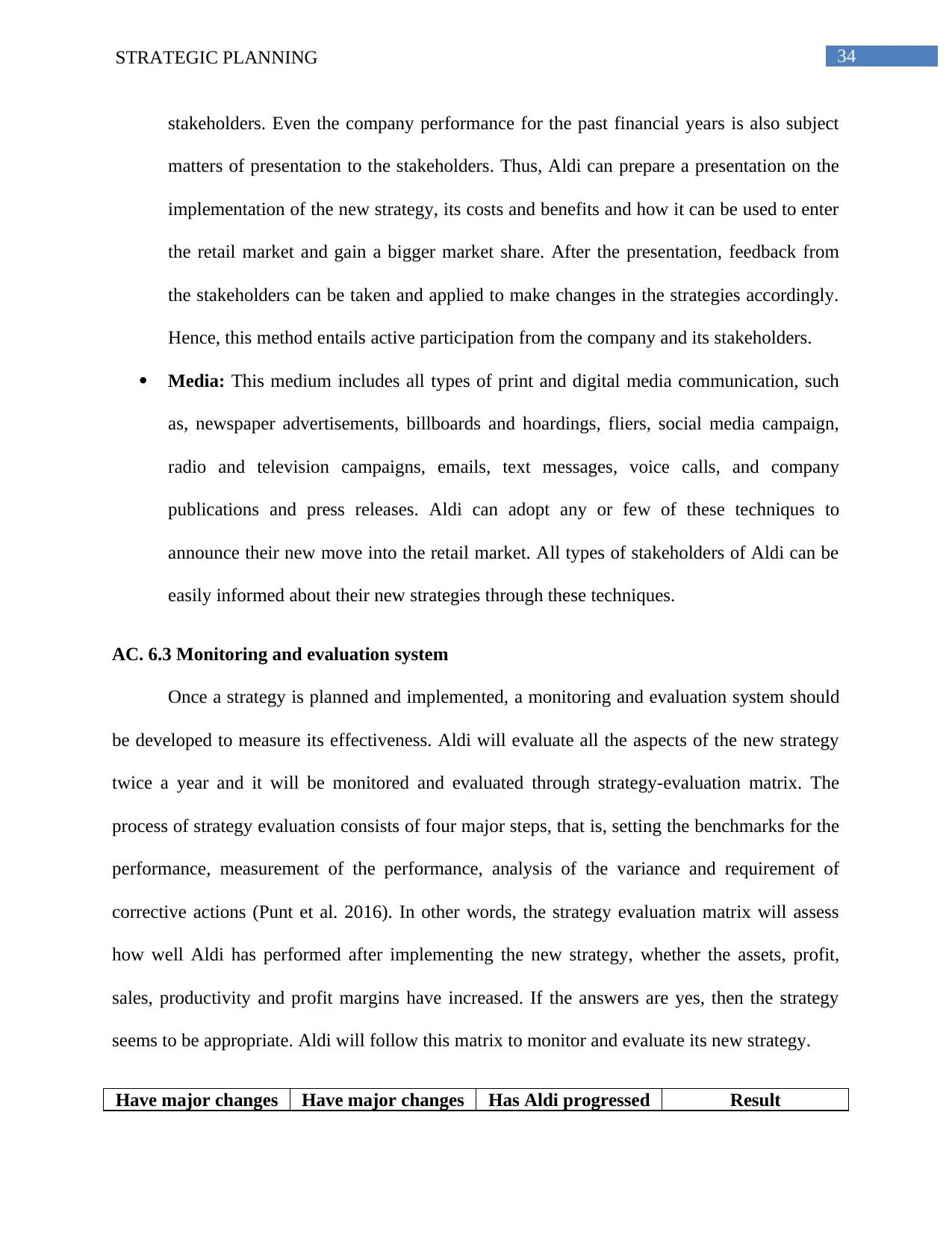
34STRATEGIC PLANNING
stakeholders. Even the company performance for the past financial years is also subject
matters of presentation to the stakeholders. Thus, Aldi can prepare a presentation on the
implementation of the new strategy, its costs and benefits and how it can be used to enter
the retail market and gain a bigger market share. After the presentation, feedback from
the stakeholders can be taken and applied to make changes in the strategies accordingly.
Hence, this method entails active participation from the company and its stakeholders.
Media: This medium includes all types of print and digital media communication, such
as, newspaper advertisements, billboards and hoardings, fliers, social media campaign,
radio and television campaigns, emails, text messages, voice calls, and company
publications and press releases. Aldi can adopt any or few of these techniques to
announce their new move into the retail market. All types of stakeholders of Aldi can be
easily informed about their new strategies through these techniques.
AC. 6.3 Monitoring and evaluation system
Once a strategy is planned and implemented, a monitoring and evaluation system should
be developed to measure its effectiveness. Aldi will evaluate all the aspects of the new strategy
twice a year and it will be monitored and evaluated through strategy-evaluation matrix. The
process of strategy evaluation consists of four major steps, that is, setting the benchmarks for the
performance, measurement of the performance, analysis of the variance and requirement of
corrective actions (Punt et al. 2016). In other words, the strategy evaluation matrix will assess
how well Aldi has performed after implementing the new strategy, whether the assets, profit,
sales, productivity and profit margins have increased. If the answers are yes, then the strategy
seems to be appropriate. Aldi will follow this matrix to monitor and evaluate its new strategy.
Have major changes Have major changes Has Aldi progressed Result
stakeholders. Even the company performance for the past financial years is also subject
matters of presentation to the stakeholders. Thus, Aldi can prepare a presentation on the
implementation of the new strategy, its costs and benefits and how it can be used to enter
the retail market and gain a bigger market share. After the presentation, feedback from
the stakeholders can be taken and applied to make changes in the strategies accordingly.
Hence, this method entails active participation from the company and its stakeholders.
Media: This medium includes all types of print and digital media communication, such
as, newspaper advertisements, billboards and hoardings, fliers, social media campaign,
radio and television campaigns, emails, text messages, voice calls, and company
publications and press releases. Aldi can adopt any or few of these techniques to
announce their new move into the retail market. All types of stakeholders of Aldi can be
easily informed about their new strategies through these techniques.
AC. 6.3 Monitoring and evaluation system
Once a strategy is planned and implemented, a monitoring and evaluation system should
be developed to measure its effectiveness. Aldi will evaluate all the aspects of the new strategy
twice a year and it will be monitored and evaluated through strategy-evaluation matrix. The
process of strategy evaluation consists of four major steps, that is, setting the benchmarks for the
performance, measurement of the performance, analysis of the variance and requirement of
corrective actions (Punt et al. 2016). In other words, the strategy evaluation matrix will assess
how well Aldi has performed after implementing the new strategy, whether the assets, profit,
sales, productivity and profit margins have increased. If the answers are yes, then the strategy
seems to be appropriate. Aldi will follow this matrix to monitor and evaluate its new strategy.
Have major changes Have major changes Has Aldi progressed Result
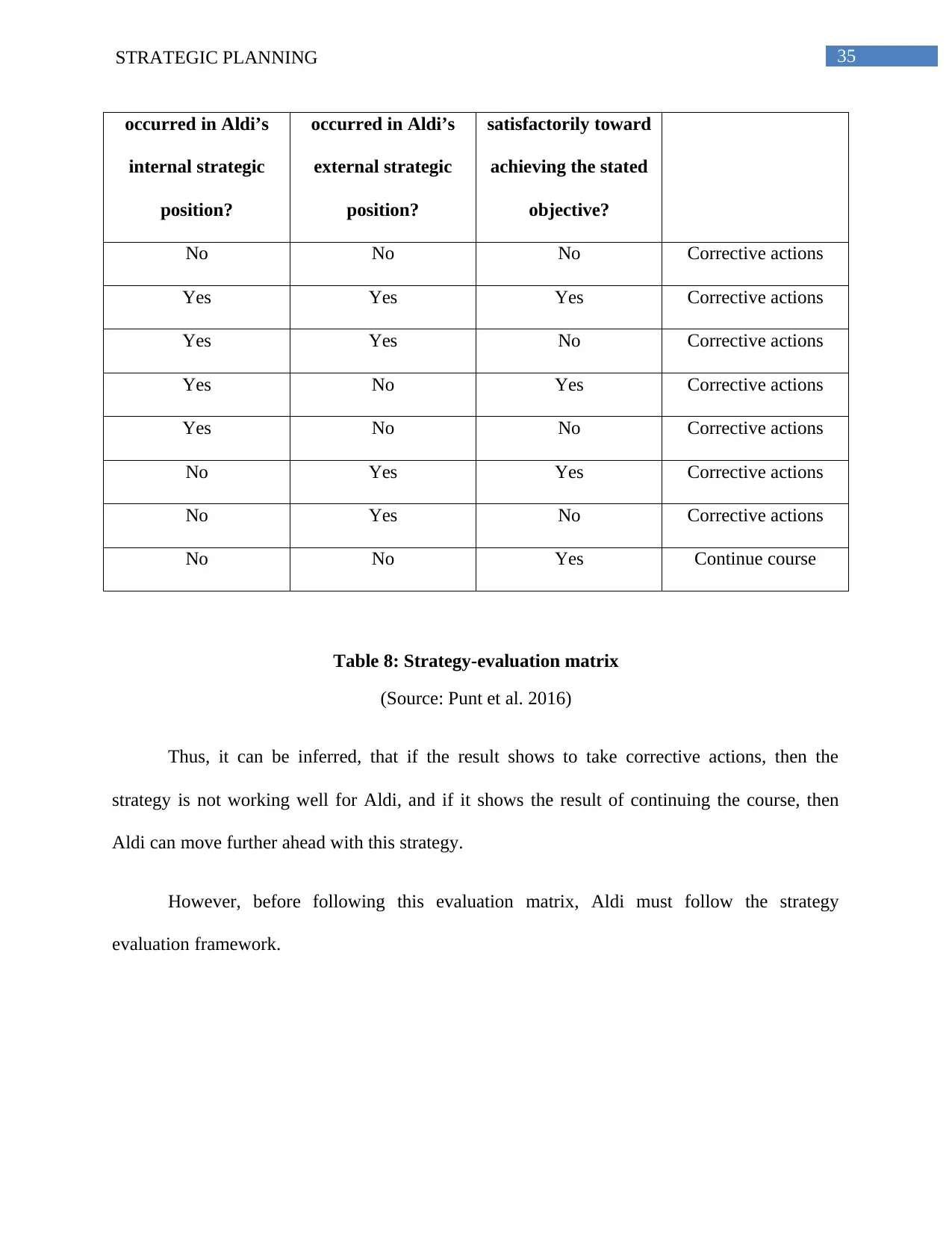
35STRATEGIC PLANNING
occurred in Aldi’s
internal strategic
position?
occurred in Aldi’s
external strategic
position?
satisfactorily toward
achieving the stated
objective?
No No No Corrective actions
Yes Yes Yes Corrective actions
Yes Yes No Corrective actions
Yes No Yes Corrective actions
Yes No No Corrective actions
No Yes Yes Corrective actions
No Yes No Corrective actions
No No Yes Continue course
Table 8: Strategy-evaluation matrix
(Source: Punt et al. 2016)
Thus, it can be inferred, that if the result shows to take corrective actions, then the
strategy is not working well for Aldi, and if it shows the result of continuing the course, then
Aldi can move further ahead with this strategy.
However, before following this evaluation matrix, Aldi must follow the strategy
evaluation framework.
occurred in Aldi’s
internal strategic
position?
occurred in Aldi’s
external strategic
position?
satisfactorily toward
achieving the stated
objective?
No No No Corrective actions
Yes Yes Yes Corrective actions
Yes Yes No Corrective actions
Yes No Yes Corrective actions
Yes No No Corrective actions
No Yes Yes Corrective actions
No Yes No Corrective actions
No No Yes Continue course
Table 8: Strategy-evaluation matrix
(Source: Punt et al. 2016)
Thus, it can be inferred, that if the result shows to take corrective actions, then the
strategy is not working well for Aldi, and if it shows the result of continuing the course, then
Aldi can move further ahead with this strategy.
However, before following this evaluation matrix, Aldi must follow the strategy
evaluation framework.
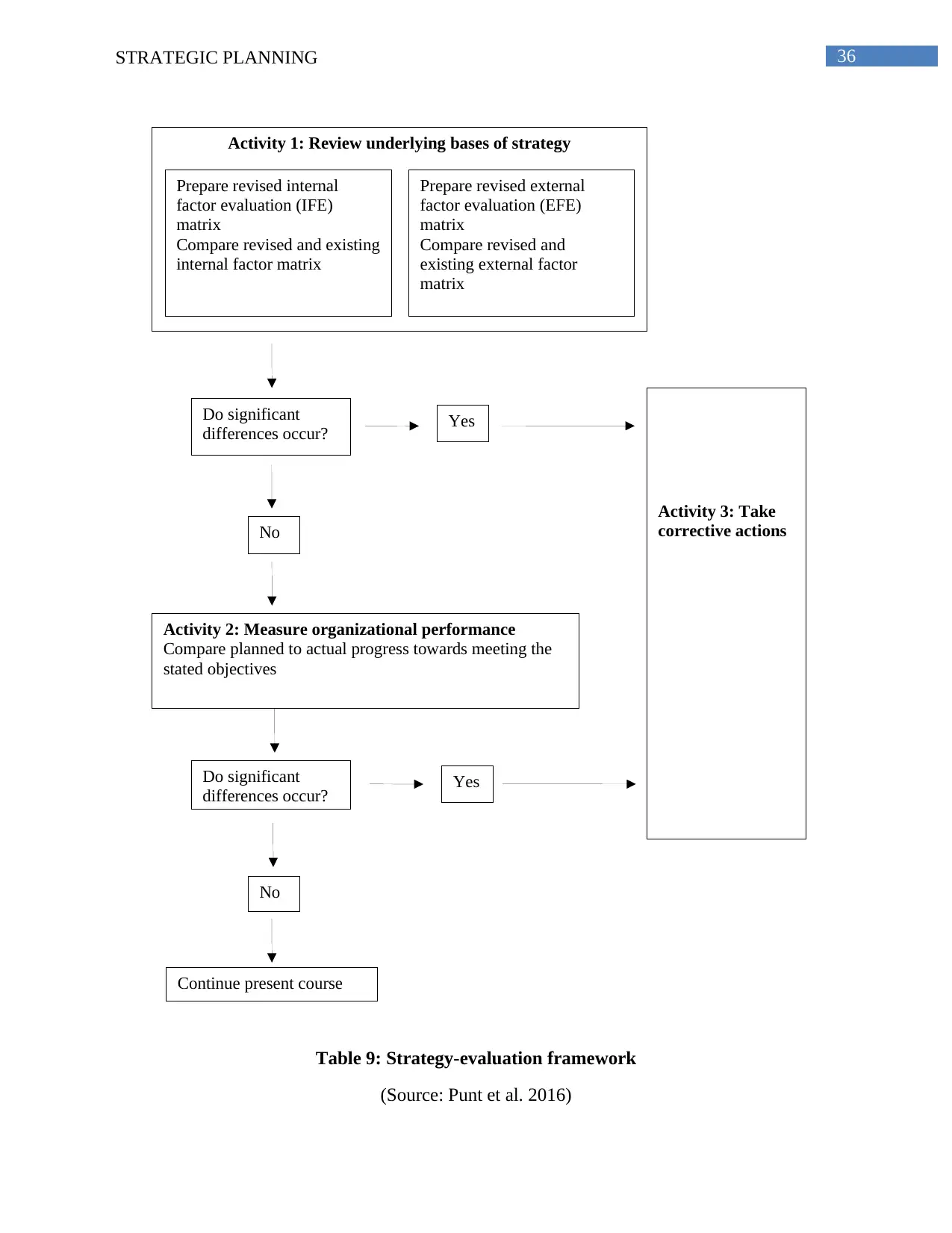
36STRATEGIC PLANNING
Activity 1: Review underlying bases of strategy
Prepare revised internal
factor evaluation (IFE)
matrix
Compare revised and existing
internal factor matrix
Prepare revised external
factor evaluation (EFE)
matrix
Compare revised and
existing external factor
matrix
Do significant
differences occur? Yes
No
Activity 2: Measure organizational performance
Compare planned to actual progress towards meeting the
stated objectives
Yes
No
Do significant
differences occur?
Continue present course
Activity 3: Take
corrective actions
Table 9: Strategy-evaluation framework
(Source: Punt et al. 2016)
Activity 1: Review underlying bases of strategy
Prepare revised internal
factor evaluation (IFE)
matrix
Compare revised and existing
internal factor matrix
Prepare revised external
factor evaluation (EFE)
matrix
Compare revised and
existing external factor
matrix
Do significant
differences occur? Yes
No
Activity 2: Measure organizational performance
Compare planned to actual progress towards meeting the
stated objectives
Yes
No
Do significant
differences occur?
Continue present course
Activity 3: Take
corrective actions
Table 9: Strategy-evaluation framework
(Source: Punt et al. 2016)
Paraphrase This Document
Need a fresh take? Get an instant paraphrase of this document with our AI Paraphraser
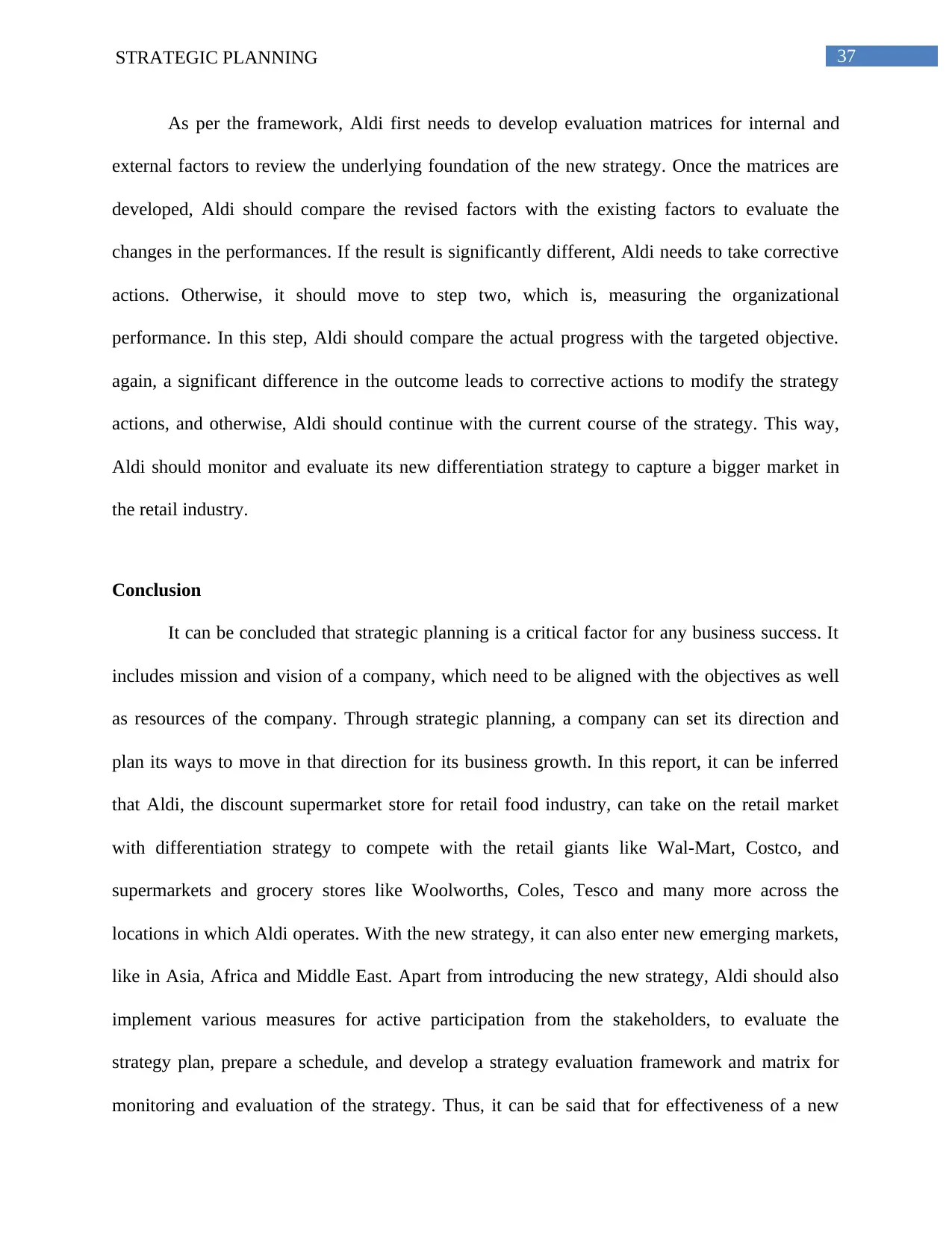
37STRATEGIC PLANNING
As per the framework, Aldi first needs to develop evaluation matrices for internal and
external factors to review the underlying foundation of the new strategy. Once the matrices are
developed, Aldi should compare the revised factors with the existing factors to evaluate the
changes in the performances. If the result is significantly different, Aldi needs to take corrective
actions. Otherwise, it should move to step two, which is, measuring the organizational
performance. In this step, Aldi should compare the actual progress with the targeted objective.
again, a significant difference in the outcome leads to corrective actions to modify the strategy
actions, and otherwise, Aldi should continue with the current course of the strategy. This way,
Aldi should monitor and evaluate its new differentiation strategy to capture a bigger market in
the retail industry.
Conclusion
It can be concluded that strategic planning is a critical factor for any business success. It
includes mission and vision of a company, which need to be aligned with the objectives as well
as resources of the company. Through strategic planning, a company can set its direction and
plan its ways to move in that direction for its business growth. In this report, it can be inferred
that Aldi, the discount supermarket store for retail food industry, can take on the retail market
with differentiation strategy to compete with the retail giants like Wal-Mart, Costco, and
supermarkets and grocery stores like Woolworths, Coles, Tesco and many more across the
locations in which Aldi operates. With the new strategy, it can also enter new emerging markets,
like in Asia, Africa and Middle East. Apart from introducing the new strategy, Aldi should also
implement various measures for active participation from the stakeholders, to evaluate the
strategy plan, prepare a schedule, and develop a strategy evaluation framework and matrix for
monitoring and evaluation of the strategy. Thus, it can be said that for effectiveness of a new
As per the framework, Aldi first needs to develop evaluation matrices for internal and
external factors to review the underlying foundation of the new strategy. Once the matrices are
developed, Aldi should compare the revised factors with the existing factors to evaluate the
changes in the performances. If the result is significantly different, Aldi needs to take corrective
actions. Otherwise, it should move to step two, which is, measuring the organizational
performance. In this step, Aldi should compare the actual progress with the targeted objective.
again, a significant difference in the outcome leads to corrective actions to modify the strategy
actions, and otherwise, Aldi should continue with the current course of the strategy. This way,
Aldi should monitor and evaluate its new differentiation strategy to capture a bigger market in
the retail industry.
Conclusion
It can be concluded that strategic planning is a critical factor for any business success. It
includes mission and vision of a company, which need to be aligned with the objectives as well
as resources of the company. Through strategic planning, a company can set its direction and
plan its ways to move in that direction for its business growth. In this report, it can be inferred
that Aldi, the discount supermarket store for retail food industry, can take on the retail market
with differentiation strategy to compete with the retail giants like Wal-Mart, Costco, and
supermarkets and grocery stores like Woolworths, Coles, Tesco and many more across the
locations in which Aldi operates. With the new strategy, it can also enter new emerging markets,
like in Asia, Africa and Middle East. Apart from introducing the new strategy, Aldi should also
implement various measures for active participation from the stakeholders, to evaluate the
strategy plan, prepare a schedule, and develop a strategy evaluation framework and matrix for
monitoring and evaluation of the strategy. Thus, it can be said that for effectiveness of a new
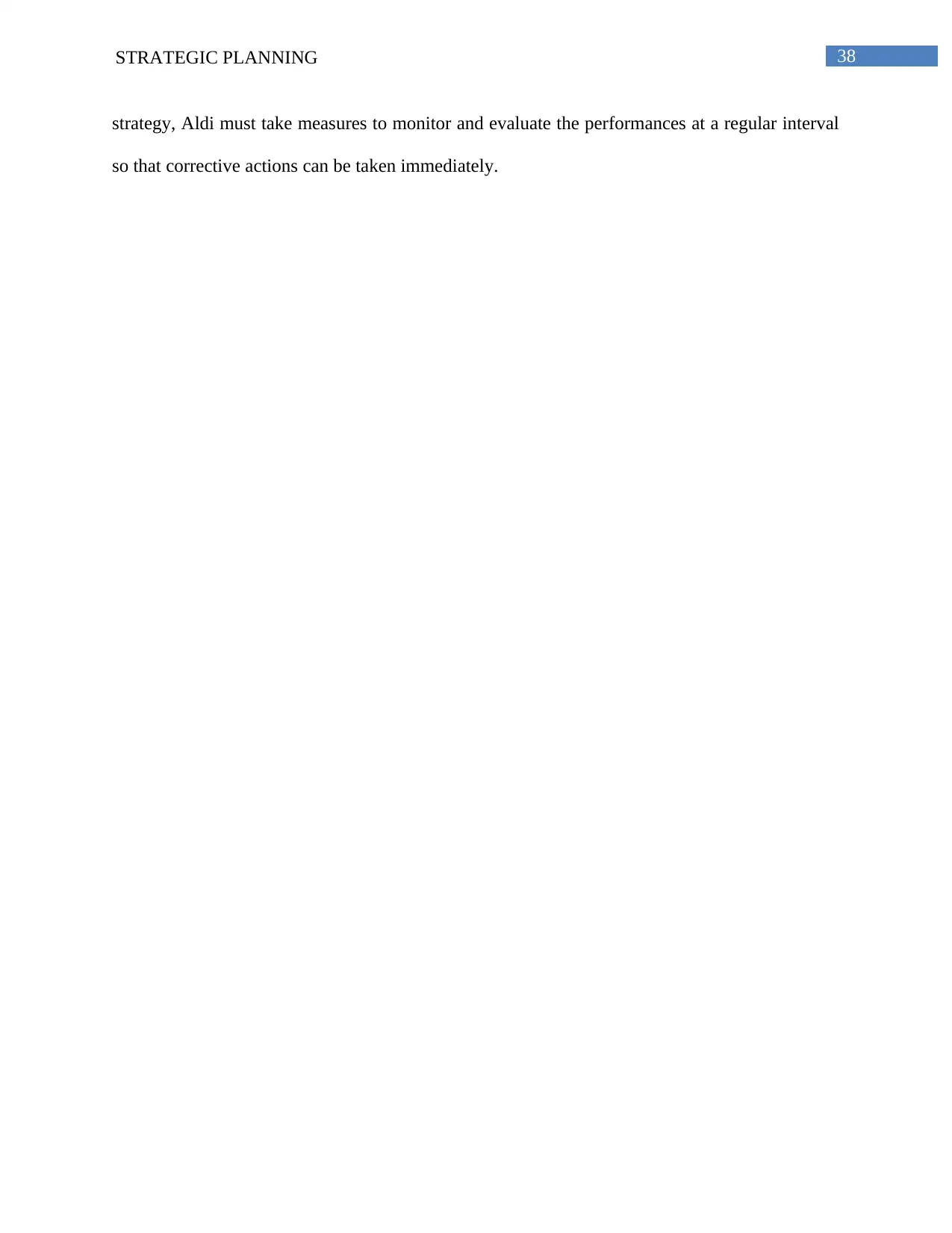
38STRATEGIC PLANNING
strategy, Aldi must take measures to monitor and evaluate the performances at a regular interval
so that corrective actions can be taken immediately.
strategy, Aldi must take measures to monitor and evaluate the performances at a regular interval
so that corrective actions can be taken immediately.
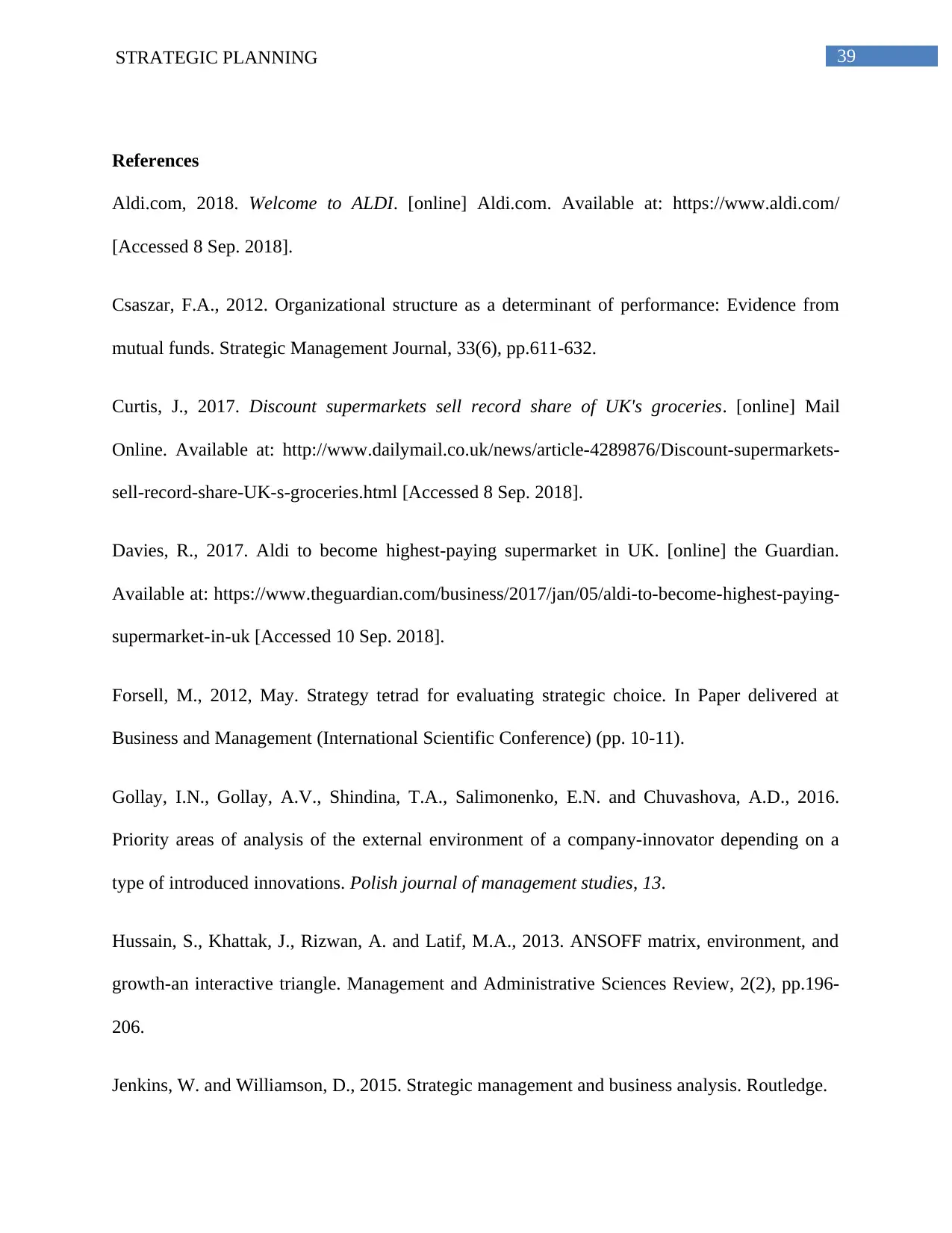
39STRATEGIC PLANNING
References
Aldi.com, 2018. Welcome to ALDI. [online] Aldi.com. Available at: https://www.aldi.com/
[Accessed 8 Sep. 2018].
Csaszar, F.A., 2012. Organizational structure as a determinant of performance: Evidence from
mutual funds. Strategic Management Journal, 33(6), pp.611-632.
Curtis, J., 2017. Discount supermarkets sell record share of UK's groceries. [online] Mail
Online. Available at: http://www.dailymail.co.uk/news/article-4289876/Discount-supermarkets-
sell-record-share-UK-s-groceries.html [Accessed 8 Sep. 2018].
Davies, R., 2017. Aldi to become highest-paying supermarket in UK. [online] the Guardian.
Available at: https://www.theguardian.com/business/2017/jan/05/aldi-to-become-highest-paying-
supermarket-in-uk [Accessed 10 Sep. 2018].
Forsell, M., 2012, May. Strategy tetrad for evaluating strategic choice. In Paper delivered at
Business and Management (International Scientific Conference) (pp. 10-11).
Gollay, I.N., Gollay, A.V., Shindina, T.A., Salimonenko, E.N. and Chuvashova, A.D., 2016.
Priority areas of analysis of the external environment of a company-innovator depending on a
type of introduced innovations. Polish journal of management studies, 13.
Hussain, S., Khattak, J., Rizwan, A. and Latif, M.A., 2013. ANSOFF matrix, environment, and
growth-an interactive triangle. Management and Administrative Sciences Review, 2(2), pp.196-
206.
Jenkins, W. and Williamson, D., 2015. Strategic management and business analysis. Routledge.
References
Aldi.com, 2018. Welcome to ALDI. [online] Aldi.com. Available at: https://www.aldi.com/
[Accessed 8 Sep. 2018].
Csaszar, F.A., 2012. Organizational structure as a determinant of performance: Evidence from
mutual funds. Strategic Management Journal, 33(6), pp.611-632.
Curtis, J., 2017. Discount supermarkets sell record share of UK's groceries. [online] Mail
Online. Available at: http://www.dailymail.co.uk/news/article-4289876/Discount-supermarkets-
sell-record-share-UK-s-groceries.html [Accessed 8 Sep. 2018].
Davies, R., 2017. Aldi to become highest-paying supermarket in UK. [online] the Guardian.
Available at: https://www.theguardian.com/business/2017/jan/05/aldi-to-become-highest-paying-
supermarket-in-uk [Accessed 10 Sep. 2018].
Forsell, M., 2012, May. Strategy tetrad for evaluating strategic choice. In Paper delivered at
Business and Management (International Scientific Conference) (pp. 10-11).
Gollay, I.N., Gollay, A.V., Shindina, T.A., Salimonenko, E.N. and Chuvashova, A.D., 2016.
Priority areas of analysis of the external environment of a company-innovator depending on a
type of introduced innovations. Polish journal of management studies, 13.
Hussain, S., Khattak, J., Rizwan, A. and Latif, M.A., 2013. ANSOFF matrix, environment, and
growth-an interactive triangle. Management and Administrative Sciences Review, 2(2), pp.196-
206.
Jenkins, W. and Williamson, D., 2015. Strategic management and business analysis. Routledge.
Secure Best Marks with AI Grader
Need help grading? Try our AI Grader for instant feedback on your assignments.
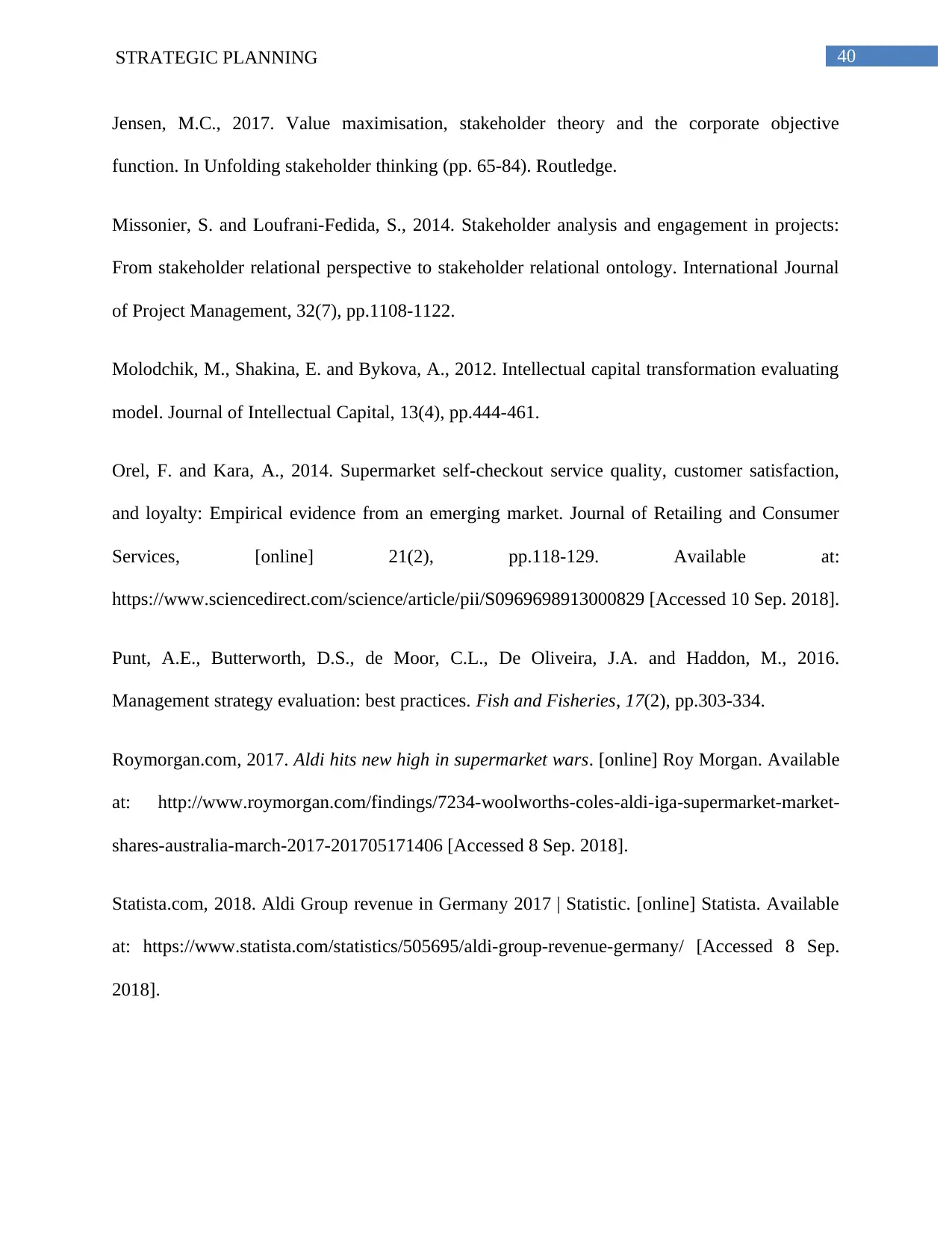
40STRATEGIC PLANNING
Jensen, M.C., 2017. Value maximisation, stakeholder theory and the corporate objective
function. In Unfolding stakeholder thinking (pp. 65-84). Routledge.
Missonier, S. and Loufrani-Fedida, S., 2014. Stakeholder analysis and engagement in projects:
From stakeholder relational perspective to stakeholder relational ontology. International Journal
of Project Management, 32(7), pp.1108-1122.
Molodchik, M., Shakina, E. and Bykova, A., 2012. Intellectual capital transformation evaluating
model. Journal of Intellectual Capital, 13(4), pp.444-461.
Orel, F. and Kara, A., 2014. Supermarket self-checkout service quality, customer satisfaction,
and loyalty: Empirical evidence from an emerging market. Journal of Retailing and Consumer
Services, [online] 21(2), pp.118-129. Available at:
https://www.sciencedirect.com/science/article/pii/S0969698913000829 [Accessed 10 Sep. 2018].
Punt, A.E., Butterworth, D.S., de Moor, C.L., De Oliveira, J.A. and Haddon, M., 2016.
Management strategy evaluation: best practices. Fish and Fisheries, 17(2), pp.303-334.
Roymorgan.com, 2017. Aldi hits new high in supermarket wars. [online] Roy Morgan. Available
at: http://www.roymorgan.com/findings/7234-woolworths-coles-aldi-iga-supermarket-market-
shares-australia-march-2017-201705171406 [Accessed 8 Sep. 2018].
Statista.com, 2018. Aldi Group revenue in Germany 2017 | Statistic. [online] Statista. Available
at: https://www.statista.com/statistics/505695/aldi-group-revenue-germany/ [Accessed 8 Sep.
2018].
Jensen, M.C., 2017. Value maximisation, stakeholder theory and the corporate objective
function. In Unfolding stakeholder thinking (pp. 65-84). Routledge.
Missonier, S. and Loufrani-Fedida, S., 2014. Stakeholder analysis and engagement in projects:
From stakeholder relational perspective to stakeholder relational ontology. International Journal
of Project Management, 32(7), pp.1108-1122.
Molodchik, M., Shakina, E. and Bykova, A., 2012. Intellectual capital transformation evaluating
model. Journal of Intellectual Capital, 13(4), pp.444-461.
Orel, F. and Kara, A., 2014. Supermarket self-checkout service quality, customer satisfaction,
and loyalty: Empirical evidence from an emerging market. Journal of Retailing and Consumer
Services, [online] 21(2), pp.118-129. Available at:
https://www.sciencedirect.com/science/article/pii/S0969698913000829 [Accessed 10 Sep. 2018].
Punt, A.E., Butterworth, D.S., de Moor, C.L., De Oliveira, J.A. and Haddon, M., 2016.
Management strategy evaluation: best practices. Fish and Fisheries, 17(2), pp.303-334.
Roymorgan.com, 2017. Aldi hits new high in supermarket wars. [online] Roy Morgan. Available
at: http://www.roymorgan.com/findings/7234-woolworths-coles-aldi-iga-supermarket-market-
shares-australia-march-2017-201705171406 [Accessed 8 Sep. 2018].
Statista.com, 2018. Aldi Group revenue in Germany 2017 | Statistic. [online] Statista. Available
at: https://www.statista.com/statistics/505695/aldi-group-revenue-germany/ [Accessed 8 Sep.
2018].
1 out of 41
Related Documents
Your All-in-One AI-Powered Toolkit for Academic Success.
+13062052269
info@desklib.com
Available 24*7 on WhatsApp / Email
![[object Object]](/_next/static/media/star-bottom.7253800d.svg)
Unlock your academic potential
© 2024 | Zucol Services PVT LTD | All rights reserved.





